The Best 10 Day Kenya Itinerary!
Looking for that perfect 10-day itinerary in Kenya? Look no further. We’ve made an itinerary for you to get the most out of your travel experience in Kenya with culture, safari and relaxing time on one of the most beautiful beaches of Kenya.
This 10 day Kenya Itinerary is a unique roundtrip where you’ll visit the highlights of Kenya. It includes a safari, you might be able to spot the big five! A citytrip to Nairobi, and days of relaxing at the Kenyan Beaches!
- Nairobi – 1 day
- Kenya – 1 day
- Lake Nakuru & Lake Naivasha – 2 days
- Maasai Mara Game Reserve – 3 days
- Mombasa (Diani Beach) – 3 days
Kenya will have you falling in love with the landscape, wildlife and culture the moment you step off the plane. It’s the best safari destination in the world, but Kenya has so much more to offer than just wildlife. So let’s get started!

Make sure to read are other blogs about Kenya:
- The 10 most beautiful beaches in Kenya
- Kenya Travel Guide (practical information)
- 13 mindblowing things you need to know about the Maasai Tribe
- Kenyan Tribes: Everything you need to know before you travel to Kenya
- 20 awesome things to do in Nairobi
10-day Kenya Itinerary
1. nairobi – 1 day.
The first stop on your 10-Day Kenya Itinerary is Nairobi. Typically, when you fly into Kenya, you will fly into Nairobi International Airport. Or you fly into Mombasa the exotic town at the coast of Kenya with stunning beaches. It’s what you prefer. Nairobi is closer to the best safari parks and ending your trip in Mombasa is what we advise you to do.
So while already in Nairobi, why not make the best of it for a day before you head out to your first destination. Stay the night at Giraffe Manor and have breakfast with giraffes. An alternative is to visit the Giraffe Centre close by where you be able to feed the endangered Rothschild Giraffes. And learn more about this endangered giraffe species. Or visit the David Sheldrick Wildlife Trust to get close to orphaned elephants and rhinos.
A few top places add to your Kenya Itinerary is visiting the Parliament Building , the City Market with local produce and craft markets in Nairobi and get some cultural history at the Nairobi National Museum . And if you are a carnivore you should definitely eat at the famous Nairobi restaurant: Carnivore .
Nairobi is the gateway to your Kenya safari and an excellent place to learn more about the culture and people of Kenya. Another tip is to check the events before you travel to Kenya. A great event to experience the local vibe is the Blankets and Wine Event that’s every first Sunday of the month.
The best venue to catch some live music is at the Live at the Elephant. It’s the perfect location in Nairobi to relax and enjoy listening to some local live Kenyan music.
Useful information
- Read our Nairobi article: 20 awesome things to do in Nairobi
- Places to stay in Nairobi (check the latest prices on Booking.com)
2. Mt. Kenya – 1 day
The Mount Kenya National Park is the second stop in your Kenya Itinerary. Mt. Kenya is the highest mountain in Kenya and the second highest mountain in Africa (highest: Kilimanjaro). The highest peaks are covered with snow and it’s the perfect backdrop for a safari filled with elephants. Well, hopefully, because the surroundings of Mt. Kenya are perfect for spotting the beautiful African elephants. So make sure to go on a walking or 4WD safari when you’re in the area.
Unfortunately, in this 10-day itinerary, there isn’t enough time to climb Mt. Kenya, but that’s a great activity to do when you come back for another time in Kenya. In this itinerary there sure is enough time to hike around Mt. Kenya and sit back and relax on the porch of the many lodges in the area. Having a cold beer overlooking the beautiful landscape and spot great wildlife is also enough for a day. And a great start to the rest of your trip through Kenya.
- Places to stay Mt. Kenya (check the latest prices on Booking.com)
- Activities to book Mt. Kenya (Book your activities via GetYourGuide!)
3. Lake Nakuru/ Lake Naivasha – 2 days
Lake nakuru.
The third stop on your 10-Day Kenya Itinerary is Lake Nakuru. Here you will want to spend a couple of days, with all there is to see. Lake Nakuru National Park is located in central Kenya and is the perfect spot to see a wide variety of African wildlife. It is a beautiful natural escape you will fall in love with, which is why it is noted in this Kenya Itinerary. It’s a destination in Kenya you won’t want to miss.
You can explore the national park and see beautiful animals such as rhinos, hippos, leopards and many others. One unique thing that makes this location a top spot in your Kenya Itinerary is that it is the best spot to see the Lesser pink flamingos. The algae in Lake Nakuru is what attracts these flamingo’s to this lake in is the reason why the lake and flamingo have a pinkish colour. It is a beautiful site and one of the highlights of your Kenya Itinerary.
There are several safari resorts and lodges right in the National Park so you can wake up amidst the natural beauty of wildlife surrounding you. Or you can stay in the town, Nakuru, nearby so you can get the local town feel.
Due to dry periods in the past in Kenya Lake Nakuru shrinks from time to time. The abundance of water depends also if you’re visiting Lake Nakuru during the rainy or dry seasons of Kenya.
Kenya has two rainy seasons. The long rain season is from April to June and the short rainy season is from October to December. The hottest period in Kenya is in February and March.
- Best places to stay Lake Nakuru (check the latest prices on Booking.com)
Lake Naivasha
The other option in your Kenya Itinerary is to visit Lake Naivasha instead of Lake Nakuru. Both are nearly close to each other so it’s up to you. If you’re a quick traveller and driver maybe you can do both.
Lake Naivasha is a freshwater lake and is a totally different experience to Lake Nakuru. You can spot crocodiles and hippo’s coming out of the water every evening and this lake is a recreational area to many Kenyans. So there are a lot of activities to in and around Lake Naivasha. Go on a boat safari and spot an incredible variety of bird species. And at Hell’s Gate National Park you can go on walking or horseback riding safari and spot wildlife like giraffe, buffalo, Colobus monkeys, hartebeest and many more.
An easy day trip from Lake Naivasha is to climb Mt. Longonot . It’s an adventurous 4-5 hour hike into the crater of Mt. Longonot where you can spot buffalo, antelopes and maybe even leopards. If you’re lucky ;).
Another great activity is to visit Elsamere . Visit the beautiful lodge with an amazing view over Lake Naivasha, have a delicious cup of tea and learn more about The Joy Adamson Story. The women who raised the lion cub, Elsa, and successfully released her into the wild many years later. Her best-selling book, Born Free, is definitely something you want to read while you travel through Kenya.
- Best places to stay Lake Naivasha (check the latest price on Booking.com)
- Interesting Book to read: Born Free (check the latest price on Amazon)
4. Maasai Mara Game Reserve – 3 days (Best stop in the Kenya Itinerary)
The next stop on your 10-Day Kenya Itinerary is the Maasai Mara Game Reserve and the most exciting one. You haven’t travelled to Kenya if you haven’t visited the Maasai Mara, so put this for sure in your itinerary. In this park, you will have the ultimate safari experience as you have seen on the National Geographic channel and dreamed about after watching.
We recommend spending a good three days in this stunning location. This is the picture perfect destination to get your full safari experience and see the big five on your game drive.
What is the big five? It’s a bit outdated but the big five is actually an old hunting term. It refers to the five most difficult animals in Africa to hunt on foot: the rhino, leopard, buffalo, elephant and lion. Now it’s used as a safari term by African tour operators.
Best Game Reserve to visit in Kenya
The Maasai Mara is one of the best game reserves in the country due to its abundance in wildlife. This will mean that your chances of seeing all the magnificent animals you want to catch a glimpse of are much more likely than in other areas or parks in the country. And you need three days to give you a chance to spot them all (if you’re very lucky) and make the most out of your African safari experience. There is such a variety due to the vastly different terrains all located in this reserve. You will want to get your camera ready!
And visiting a Maasai village is a must-do as well. It’s a once-in-a-lifetime-experience you must add in your Kenya Itinerary. This tribe has become the symbol of Kenya and is one of the more traditional tribes of Kenya . Known for the tall men jumping very high in the air wearing red clothes. We wrote an article about the Masaai Trib that you might find interesting:
- 13 Mindblowing Things About the Maasai Tribe .
Whether you take a bush walk or go on a game drive, you will be amazed at the landscape and the beautiful animals surrounding you in their natural habitat. Where else would you be able to have a lion or rhino walk right up beside the vehicle you are sitting in. It is one of the prettiest places to explore in Kenya, thus making it a top destination in your Kenya Itinerary.
The most extravagant way to experience the Maasai Mara is to book a hot air balloon safari. You will be picked up before sunrise and just as the sun is coming up you will fly in the air to spot the wild animals at their most active time of day. Oh, and when you land in the middle of the savanne there will be a champagne breakfast waiting for you……
The best time to watch the annual migration of wildebeest and zebra in the Masai Mara is between June and September right after the long rain season.
- Best places to stay Masai Mara (check the latest price on Booking.com)
- Interesting Book to read: The White Maasai (check the latest price on Amazon)
- 13 mindblowing things about the Maasai Tribe (Made For Travellers article)
5. Mombasa (Diani Beach) – 3 days
The last stop on your itinerary for Kenya is Mombasa. This is the perfect destination for a little relaxation after your exploration of Kenya’s National Parks. Kenya’s beaches are quite stunning and a stop is definitely worth multiple days. So you have enough time to relax and process al the amazing experiences and memories you’ve made in Kenya.
Diani beach, in particular, has a little bit of everything. Located on the Southern portion of Kenya’s coast, Diani Beach is about an hour South of Mombasa. There are plenty of resorts along the beach that will provide perfect accommodations for your stay.
During the day you have the crystal-clear waters and sandy beaches to dip into. Lined with coconut palm trees the beach offers great snorkelling and marine life. You can even spot whale sharks. In the evening, you will be able to peruse the different shops and boutiques. There are several restaurant options for when meal time comes around. If the nightlife is your scene, there is a lively nightlife scene surrounding Diani Beach as well. Since your schedule is packed with so much to do, Diani really is the perfect beach option. You can relax and still having plenty to explore. It is the perfect stop in your Kenya Itinerary!
There are many stunning beaches along the coast of Kenya. We’ve made a list of the 10 most beautiful beaches in Kenya . So you can make the best decision to end your trip in Kenya.
- Read our Practical information Kenya Travel Guide
- Best places to stay Mombasa, Diani Beach (Check the latest price on Booking.com)
- Activities to book Mombasa (Book your activities via GetYourGuide)
Additions and Alternatives for Your Kenya Itinerary
- Visit Amboseli National Park instead of the Masai Mara. It’s near the border of Tanzania and during your safari, you’ll have an amazing view of the Kilimanjaro in the background. It’s a lot smaller than the Masai Mara but the view of the Kilimanjaro makes up for it.
- Go to Aberdare National Park instead of Mt. Kenya and spot beautiful waterfalls like the Karuru Falls, Thomson falls or the Chania Falls.
- Explore Tsavo National Park as an additional safari experience. It’s one of the oldest and largest national parks of Kenya. The park lies between Nairobi and Mombasa. Instead of flying to Mombasa from Masai Mara or Nairobi you can drive to Mombasa and you will drive through Tsavo National Park. Or take the train from Nairobi to Mombasa and you can spot wild animals from the train.
- Fly to Zanzibar (Tanzania) for the last few days relaxing in the sun at the end of your Kenya Itinerary. It’s a beautiful and exotic island of the coast of Tanzania with beautiful white sandy beaches, turquoise water and a lot culture to explore in Stone Town .
Similar Posts
13 mindblowing things you need to know about the maasai tribe | kenya, kenyan tribes: everything you need to know before you travel to kenya, the most beautiful beaches in kenya, 20 awesome things to do in nairobi, kenya.
Kenya Tours & Vacations

Kenya is a country that beckons with rich culture, breathtaking landscapes and some of the most exciting wildlife encounters in the world.
From the snow-capped peak of mighty Mt Kenya to the golden, grassy plains of the Central Highlands to the pink blush of Lake Nakuru, Kenya does the great outdoors like nowhere else. Join your local leader as you journey through the incredible Serengeti on a safari, head deep into the heartland of the Maasai tribespeople, watch hippos on the waters of Lake Naivasha, or explore the bustling capital of Nairobi. Whether you want to search for the Big Five, learn how to do the adumu (jumping dance) with the Massai, or cook and eat traditional Kenyan food under the stars, Kenya is waiting for you to explore.
Our Kenya trips
Let's create an exclusive trip for your group.
Kenya tour reviews
Filter by rating
Real East Africa & Zanzibar
Kenya Wildlife Safari
Essential East Africa
Articles of Kenya
Best places to travel in February
Best places to travel in July
The butterfly effect: how positive change is rippling through Maasai communities in Kenya
The 7 best places to go on a hot air balloon ride
Serengeti or Masai Mara? Which national park should you visit?
10 ways to get closer to nature with Intrepid
Meet Semerian Sankori, the woman changing the lives of rural communities in Kenya
What to expect on an Intrepid Premium trip
Kenya at a glance
Capital city.
Nairobi (5.3 million)
Swahili, English
(GMT+03:00) Nairobi
CALLING CODE
Electricity.
Type G (Irish/British 3-pin)
Learn more about Kenya
Culture and customs.
Kenya is one of Africa’s most multicultural countries, with a population as diverse as its terrain. There are more than 40 different ethnic tribes, each with their own language, culture, and customs. The red-robed, beaded Maasai of the south are undoubtedly the most famous tribespeople of the region. The unique Swahili culture dominates the coastal regions and Islam is quite common in the North. Nairobi is home to a large swirl of humanity, with significant Indian, African, and Western populations. As a result, you’re likely to see mosques, churches, and temples, taste international cuisine from all over the world and hear the sounds of Kenyan hip-hop, traditional African drumming, and Western pop.
Depending on where you are in Kenya, the culture and customs vary according to the area you are visiting. The northern and coastal regions tend to be more traditional, while Nairobi, as an international hub of trade and commerce, tends to be more liberal. The Maasai and other tribes typically lead pastoral lives based on agriculture and animal husbandry. Their daily life is based on centuries of tradition and if you get the chance to visit a tribal village, you’ll be able to see the customs of these fascinating people firsthand. Traditional clothing, dance, song, and ceremonies keep this proud culture alive in the face of modernization, which is sweeping through the country.
Eating and drinking
Intrepid believes that one of the best ways of experiencing a country is by eating. Whether you're sampling street food, savoring a cheap eat, or indulging in a banquet, there are endless options to choose from wherever you are in the world.
As a multiracial society, Kenya has many different cuisines for travelers to try. From traditional Swahili cuisine to Indian, European, and Middle Eastern food, many cultures are represented, especially in large cities like Nairobi. While the average Kenyan lives mostly on maize, beans, and vegetables, tourist areas and large cities offer much more variety for visitors.
Things to eat in Kenya
Kenya’s coastal areas, such as Mombasa and Lamu, are the best places to feast on fresh crab, lobster, oysters, and kingfish cooked to perfection in sumptuous spices.
2. Nyama Choma
One strictly for the carnivores, Nyama Choma is a popular Kenyan style of cooking and eating meat. Goat, beef, and chicken are roasted and served on a communal cutting board, sometimes with condiments such as chili, salt, chopped tomatoes, and avocado.
With a significant population hailing from India, Kenya is a great place to savor spicy curries made with an East African twist.
4. Tropical fruit
For a cheap and cost-effective snack, head to the market stalls that sell a colorful array of tropical fruit. Pineapples, papayas, bananas, and passionfruit are usually plentiful in Kenya. Any fruit that you can peel is a more hygienic, easy option than the one you have to wash.
Geography and environment
Kenya is located in East Africa, sharing borders with Ethiopia , Somalia, Sudan, Tanzania , and Uganda . With a diverse topography, Kenya has a wide variety of terrain – lofty mountains, dense rainforest, stark plains, and soft-sand beaches.
This diversity also applies to the environments that Kenya’s people live in. Kenya’s crowded capital is a heaving melange of cars, buses, skyscrapers, street stalls, markets, and people; the idyllic Loita Hills is the heart of Maasai country; the national parks run wild with exotic creatures; and rustic Lamu Island is a car-free piece of living history. Overall, most Kenyans either live a fast-paced existence in the modern metropolis of Nairobi or a quieter, agricultural-based life in Kenya’s rural towns and villages.
History and government
Early history.
Recent archaeological findings in Kenya have revealed the remains of one of the earliest species of hominid, placing Kenya among the first places inhabited by humans. Before the arrival of outsiders, Kenya was inhabited by nomadic tribes who most likely entered Kenya from the north. The Maasai and the Kikuyu were the most dominant in numbers, although the Maasai were well known for their reputation as strong warriors who often raided their neighbors.
During the 19th century, Kenya came under the influence of outside cultures due to the arrival of traders from the Middle East and Asia, and settlers and missionaries from Europe. Britain and Germany both had vested interests in Kenya for its abundance of natural resources (especially ivory) and because it was an important point for trade. As such, settlers from Britain, Germany, and other European nations flooded into the country in large numbers, setting up agricultural empires such as coffee plantations. These plantations relied heavily on local tribespeople for labor, much to the resentment of the indigenous populations. As a result of this, a large number of Indian laborers were brought to Kenya to work on plantations and build railroads. This Indian influence is reflected in the current population of Kenya.
Recent history
After much infighting, confrontation, uprising, and reform, Kenya was granted its independence from British colonial rule in 1963. The “Mau Mau Uprising” of the 1950s was responsible for drawing attention to the plight of the African population, and was also the catalyst for the change in how Kenya is governed.
The 1970s saw Kenya’s international economic profile grow due to the successful development of a free-market economy, with agriculture and tourism creating more a more stable economy. More recently, Kenya’s tourism industry has continued to develop and flourish, mainly due to its wealth of exotic animals, national parks, coastal hot-spots and unique cultures. Standards of living have also improved in Kenya, with an overall improvement in life expectancy, infant mortality, and fertility rates – probably due to the increased investment in family planning, education, and health by both the Kenyan government and NGOs. Despite this, many Kenyans still live below the poverty line and struggle to provide the bare necessities for themselves and their children. Regardless of this, travelers will be touched by the generosity of spirit and genuine hospitality that Kenyans display to visitors.
Top 10 wildlife encounters in Kenya
1. cheetah chase.
The cheetah, the Ferrari of the animal kingdom, is the fastest land animal on the planet. This slick predator can reach speeds of up to 120 km/hr and can accelerate to 103km/hr in just three seconds. Seeing a cheetah stealthily stalk, then pursue, a gazelle, springbok or an impala is a thrilling sight.
Spot the speedy cheetah on our 7 day Premium Kenya adventure.
2. Lioness kill
See the circle of life play out in Masai Mara National Reserve. Lions might be the kings of the jungle, but in Kenya, it's the lionesses that do the hunting. Working in groups, these big cats track down prey such as wildebeest, impalas, zebras and buffalo. If you are lucky, you will see a kill - the lionesses hunting together, encircling a herd then targeting the closest animal. The attack is swift and powerful - an experience you will never forget!
Watch the lioness in her natural habitat on our 15 day Premium Kenya & Tanzania tour.
3. Wildebeest migration
The annual migration of 1.5 million wildebeest across the grassy plains of Eastern Africa is an extraordinary spectacle of nature. The wildebeests risk drowning in rivers and attacks from big cats and crocodiles, to travel nearly 2,000 km in search of food and water. Around 200,000 zebra and 500,000 Thomson's gazelle also join this boisterous group each year, making it one of the greatest shows on earth.
Witness the wildebeest migration on our 8 day Kenya Wildlife Safari.
4. Sea of flamingos
See Lake Nakuru turn a shimmering sea of pink as millions of flamingos flock to feed in the shallow waters. The sheer amount of these long-legged creatures - among 400 species of birds that inhabit the area - is an incredible sight.
Marvel at flamingos on our 15 day Masai Heartlands adventure.
5. Elephant bath time
Elephants love water and, despite their size, they are excellent swimmers. To cool off from the scorching African sun, they splash about in lakes, paddle in rivers and give themselves a shower using their trunks. Witnessing these gentle giants having a bath is a truly memorable experience, but don't stand too close or you'll likely get very wet.
Catch a spray from elephants on our 13 day Premium Uganda, Rwanda & Kenya tour.
6. Rhino love
A baby rhino stays by its mother's side for up to five years after it is born and, during this time, mom is extremely protective of her calf. With an adult white rhino weighing up to 3,600 kg and reaching speeds of up to 50 km/h when charging, you don't want to get between a mother rhino and her baby. The best place for spotting the rare black rhino is Kenya's Aberdare National Park.
Snap some photos of these fascinating creatures on our 15 day Premium Kenya & Southern Africa Highlights tour.
7. Giraffe parade
It's the classic African image – giraffes striding across the African savanna at sunset, nibbling on acacia trees and carving a graceful silhouette on the orange-tinged skyline. Kenya has the biggest giraffe population on the continent, so a dusk safari to see these unique creatures is a must.
Look up at Kenya's giraffe population on our 8 day Kenya Family Safari.
8. Hippos wallowing
One of Africa's best locations for hippo spotting is Lake Naivasha. Here, you can see large pods of these mighty animals submerged in the water and wallowing in mud. More than just social interaction, the water helps them cool down and protects their skin from drying out. With the exception of feeding, hippos spend most of their lives in the water - from childbirth and reproduction to fighting with other hippos - so it's very likely you'll see them playing in their aquatic playground.
Watch hippos playing in the water on our 31 day Premium Kenya & Southern Africa In Depth tour.
9. Zebra crossing
For many, the highlight of the annual zebra migration is hundreds of thousands of these black-and-white-striped animals making the death-defying dash across the Mara River. Vulnerable to massive crocodiles lying in wait for a tasty meal, the zebras don't waste any time once they decide to take the plunge.
Admire these majestic animals on our 20 day Best of East Africa tour.
10. Monkey business
That chatter from the treetops above is most likely from cheeky colobus monkeys. As these creatures spend nearly all of their lives in the forest canopy, your best chance of spotting them is as they dart through the trees, a flurry of black and white fur. Treating branches like trampolines, they leap high into the air, then drop downward, using the long hair on their shoulders like a parachute. Listen out for males, whose croaking roars can often be heard resonating throughout the forest.
Point out swinging monkeys on one of our safari tours in Kenya.
From the large, lively markets of Nairobi to the small, slow-paced markets of the villages, shopping in Kenya is definitely "market-centric". Nairobi and other large cities have a range of boutiques and malls but, as in most other African countries, the buzzing markets are some of the best places to shop, eat and mingle with locals.
It's a good idea to check with your local customs officials to ensure that you are able to import certain items back into your home country. Australia and New Zealand for example have strict quarantine laws.
Things to buy in Kenya
1. Handicrafts
The wood and soapstone carvings in Kenya are of great quality. Peruse the carvings at city markets and shops, or alternatively, buy direct from artisans in countryside villages.
2. Maasai jewellery
The colorful beaded creations of the Maasai make excellent souvenirs. Wear them as a bold, statement piece, or hang them on walls at home as a unique reminder of your time in Kenya.
Kenyan markets are full of vibrant fabric sarongs and wraps (also known as kikoys or kangas). Put these on your shopping list as they offer great protection from the African sun.
4. Kenyan music
Reggae, afro-rap, and African hip-hop are popular (especially in Kenya’s big cities), so stock up on some local music to bring a bit of Kenyan rhythm home with you.
Festival and events
Jamhuri Day
Feasts, speeches, parades, music, and dance all feature in this national holiday commemorating Kenya’s independence and the establishment of its republic. A mass celebration of freedom and unity, this is a big day for all Kenyan people. The day is celebrated on 12th December each year.
The birthday of the Prophet Mohammed turns Kenya’s Lamu Island from a sleepy village into a busy hub of activity. Pilgrims and visitors flock here for four days of devotional prayers and reverence, concluding with fun events such as donkey races, dhow sailing, traditional dance, and drumming.
Public holidays that may impact travel include:
Good Friday
Easter Monday
Madaraka Day / National Day
Idd ul Fitr / End of Ramadan
Idd ul Azha (Muslims only)
Diwali (Hindus only)
Mashujaa Day
Please note the dates of Kenya public holidays may vary
Further reading
Kenya travel faqs, when is the best time to visit kenya.
Kenya is a year-round destination with many drawcards depending on the activities you want to do, the animals you'd like to see and the type of weather you'd prefer to experience.
Most safari destinations are at their best during the dry season from June to October or December to March when it's not too hot, rainfall is low and vegetation is thinner (making it easier to view wildlife). These periods coincide with the high tourist season, particularly in December and January, so expect larger crowds and higher accommodation rates.
Do I need a visa to travel to Kenya?
Most nationalities – except 43 exempt nationalities including the Bahamas, Cyprus, South Africa , Malaysia, Singapore, Tanzania and Zimbabwe – require a visa to enter Kenya for travel, business or transit purposes. Check the official eligibility list for more information.
You must obtain a visa before you travel as visas on arrival are not available. The good news is that the process is fairly quick and easy and most nationalities can apply online.
The e-visa takes around three working days to process, but you should apply two weeks prior to travel to be on the safe side.
This page is for general information only and may be subject to change. It is your responsibility to obtain relevant visa and travel information required for entry, departure and travel to each country or region you visit on your trip. You should confirm these with the relevant embassies and/or consulates.
Last updated: 18 March 2024
Is tipping customary in Kenya?
Tipping isn’t mandatory in Kenya but a little generosity will be received positively, especially considering the low wages that Kenyan service workers are typically paid. Setting aside a small amount for porters, guides and drivers is wise, as is leaving spare change at restaurants.
What is the internet access like in Kenya?
Travelers will be able to access the internet quite easily in the internet cafes of Kenya’s large cities but should expect limited or no access in regional and rural areas.
Can I use my cell phone while in Kenya?
Cell phone coverage is good in Kenya’s large cities and towns, but less so in rural and mountainous areas. Ensure you have global roaming activated before leaving home if you wish to use your mobile phone.
What are the toilets like in Kenya?
Squat/pit toilets are the standard in Kenya, except for western-style flushable toilets that are sometimes available in large hotels and other modern buildings. Carry your own supply of soap and toilet paper, as this is rarely provided.
Can I drink the water in Kenya?
Drinking tap water isn't recommended in Kenya. For environmental reasons, try to avoid buying bottled water. Fill a reusable water bottle or canteen with filtered water. Ask your leader where filtered water can be found; some hotels we stay in may have drinking water available. It's also advisable to avoid ice in drinks and to peel fruit and vegetables before eating.
Are credit cards accepted widely in Kenya?
Credit cards are usually accepted by large hotels and western-style restaurants but not by smaller vendors. Ensure you have adequate cash to cover purchases not able to be made on credit.
What is ATM access like in Kenya?
ATMs are easily found in large cities and tourist areas like Nairobi and Mombasa but are rarer in small towns, rural areas and villages. Be sure to have other payment methods available when venturing out of the big cities, as ATMs aren't always an option.
What should I pack for Kenya?
Kenyans dress conservatively so it's important that you do the same to respect the local culture and customs. Dressing conservatively doesn't mean you need to cover yourself from head to toe, but you should wear long, loose-fitting clothing that covers your knees, shoulders, midriff and chest. Long layers are also more effective in keeping you cool and protecting your skin from the sun and insects.
You'll need a sturdy pair of walking shoes, long and loose-fitting layers (think knee-length shorts, long pants and long-sleeved shirts, etc), a pair of sandals, a warm fleece, sun-protective gear (sunglasses, a wide-brimmed sunhat and sunscreen), and insect repellent. You'll also need a reusable water bottle, a day bag and maybe a headlamp if you're camping.
Is Kenya LGBTQIA+ friendly?
LGBTQIA+ travelers who want to visit Kenya should exercise caution and avoid engaging in public displays of affection. That said, even public displays of affection for hetero couples can raise eyebrows.
Homosexuality is still illegal in Kenya and can be punishable by prison time. The criminalization of same-sex relationships was acquired from Britain before Kenya was granted independence in 1963 and has not been reviewed since.
Kenyan society is largely conservative and identifying as LGBTQIA+ is often considered to be a taboo. There are also no laws to protect LGBTQIA+ people against discrimination.
Is Kenya accessible for travellers with disabilities?
Intrepid is committed to making travel widely accessible, regardless of ability or disability. That’s why we do our best to help as many people see the world as possible, regardless of any physical or mental limitations they might have. However, we’re always happy to talk to travelers with disabilities and see if we can help guide them towards the most suitable itinerary for their needs and where possible, make reasonable adjustments to our itineraries.
Does my trip to Kenya support The Intrepid Foundation?
Yes, all Intrepid trips support the Intrepid Foundation. In fact, we make a donation on behalf of every traveler. Trips to Kenya directly support our foundation partners, East African Wildlife Society, Patinaai Osim Community Care Organisation and Eden Reforestation Project. Intrepid will double the impact by dollar-matching all post-trip donations made to The Intrepid Foundation.
East African Wildlife Society
The East African Wildlife Society aid conservation and promote the sustainable management of natural resources in East Africa. Donations from our trips equip rangers with basic skills and tools to enhance their conservation efforts, help protect endangered wildlife and support the communities living alongside forests, wetlands and marine ecosystems.
Find out more or make a donation.
Patinaai Osim Community Care Organisation
Patinaai Osim Community Care Organisation supports indigenous Maasai women to create sustainable livelihoods and empower women to rise above poverty and inequality. Donations from our trips support Patinaai Osim's livelihood programs which help women and girls to identify, and take on, alternative income-generating activities (such as beadwork and goat-rearing) to support their families.
Eden Reforestation Projects
Eden Reforestation Projects are helping to mitigate climate change by restoring forests worldwide; they also hire locally and create job opportunities within vulnerable communities. Donations from our trips support restoration across planting sites in 10 countries, including Kenya and Nepal.
Do I need to purchase travel insurance before traveling?
Absolutely. All passengers traveling with Intrepid are required to purchase travel insurance before the start of their trip. Your travel insurance details will be recorded by your leader on the first day of the trip. Due to the varying nature, availability and cost of health care around the world, travel insurance is very much an essential and necessary part of every journey.
For more information on insurance, please go to: Travel Insurance
How do I stay safe and healthy while traveling?
From Australia?
Go to: Smart Traveller
From Canada?
Go to: Canada Travel Information
From the UK?
Go to: UK Foreign Travel Advice
From New Zealand?
Go to: Safe Travel
From the US?
Go to: US Department of State
The World Health Organisation also provides useful health information.
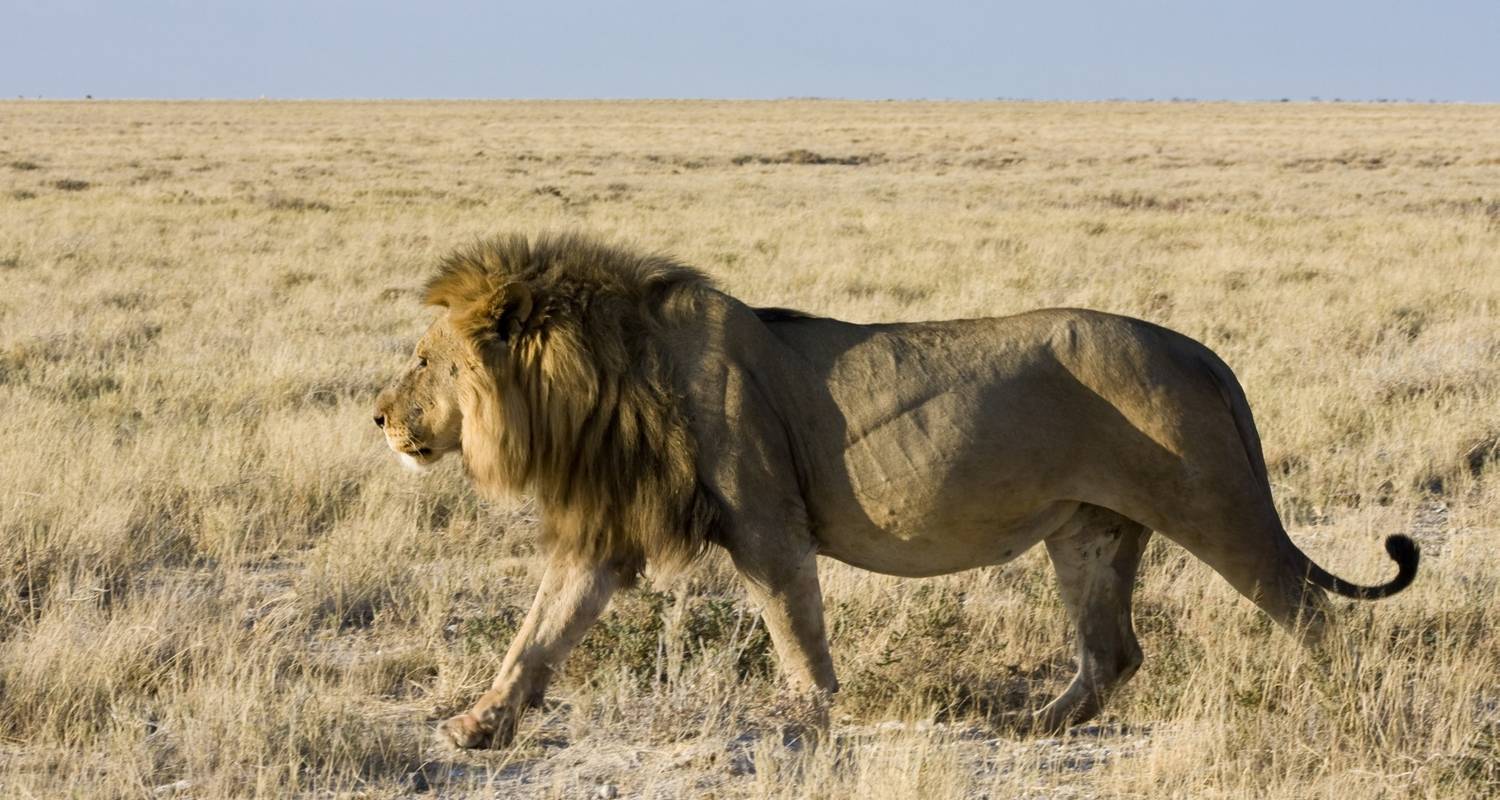
Kenya Tours & Trips
- Choose from 950+ Kenya tours
- 1,400+ verified reviews from TourRadar travelers
- 24/7 customer support
10 best Kenya tour packages
Compiled by

Nadine Kenya travel expert at TourRadar
6 Days Kenya Budget Tours (with Free Night at Nairobi Hotel)
Amboseli & masai mara budget safari by 4x4 jeep, kenya wildlife safari, 5 days mount kenya circumnavigation trek using sirimon chogoria routes, 5 days masai mara and amboseli wildlife safari, 7 days bigfive safari - nairobi, 7 days taylor -made kenya luxury safari, journeys: kenya safari experience national geographic journeys, 8 days kenya discovery safari - nairobi, 5 days kenya medium range safari for amboseli and tsavo parks from nairobi to mombasa.

- Christmas & New Year
- Witness the circle of life in action on the African plains.
- Experience the thrill of photographing the Big Five.
- Indulge in fine authentic African cuisine.
“Breath taking animals .. an amazing experience.”
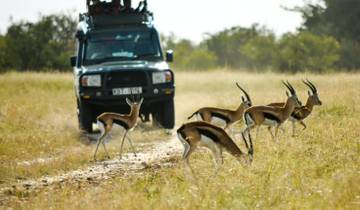
- Walk with wildlife on Crescent Island
- Morning game drive in Amboseli before Nairobi
- Depart from Nairobi to Masai Mara
“The landscapes were stunning, from the sweeping savannahs to the towering mountains.”
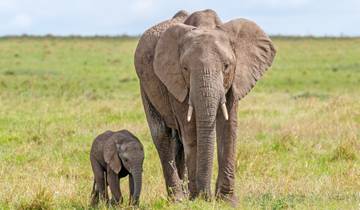
- Overland Truck
- Fall in love with the natural wonder of the Rift Valley.
- Immerse yourself in culture and visit the Maasai tribe.
- Embark on daily game drives.
“Such an incredible experience. Absolutely magical to see these animals in the wild.”
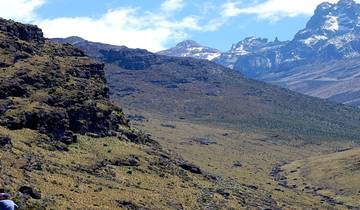
- Descend through Chogoria Route to Nairobi
- Climb to Lenana Peak for a sunrise view
- Trek through moorland to Shipton's Camp
“The views are spectacular. This is due to lack of facilities on the east side of the mountain.”

- Witness the Great Migration up close
- Enjoy game drives in Amboseli Park
- Explore Masai Mara in a 4x4 Jeep
“Our 5 day Kenya Masai Mara safari was fantastic. Everything was very good. Good company I can recommend.”
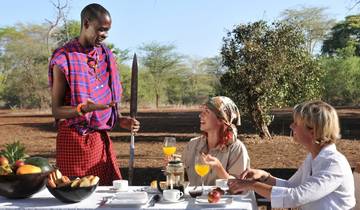
- Great Migration
- Drive through Aberdare's scenic landscapes
- Tour Hell's Gate and Lake Naivasha
- Spot flamingos at Lake Nakuru
“Absolutely incredible from start to finish! My driver, Dennis, was awesome as well. He made sure I got to see just about every animal in Kenya!”
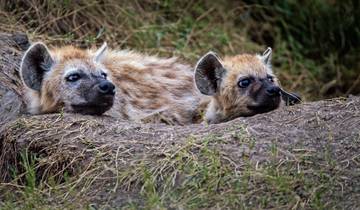
- Spot unique wildlife in Samburu Reserve
- Discover flamingos at Lake Nakuru
- Witness the Great Migration in Maasai Mara
“This is one of the best tours ever. I just loved the experience.”
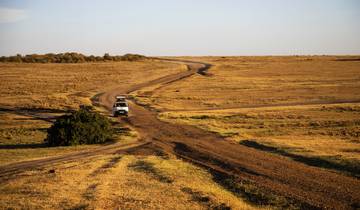
- Spot rhinos and lions on safari drives
- Cruise Lake Naivasha, spot hippos and eagles
- Explore Lake Nakuru's diverse birdlife
“Great trip to the Masai Mara, Lake Nakuru and Amboseli. The experience was excellent.”
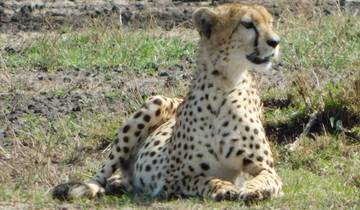
- Explore the Masai Mara's rich wildlife
- Drive through Lake Nakuru National Park
- Visit Hell's Gate and Lake Naivasha
“We saw the 'ugly five' and the 'big five' though it was 2 cheetahs instead of a leopard.”

- Stay at comfortable full-board safari lodges
- Enjoy game drives in Tsavo East National Park
- Explore Tsavo West's Mzima Springs and lava flows
“It was all very easy and well organised. I also found it to be very competitively priced considering the service we received and the standard of accommodation.”
Kenya Destinations
Discover TourRadar
Kenya Tours and Trips 2024/2025
If you want to go on a safari tour, Kenya is the place to be! The country’s Maasai Mara National Reserve is home to lions, cheetahs, elephants, and a large herd of wildebeest, making it perfect for a game drive. Kenya is also known for its fantastic gorilla and chimpanzee tracking while a trip to Lake Nakuru National Park is where you’ll find thousands of flamingos!
Check out our Kenya tours below.
Showing 255 Trips in Kenya with 324 Reviews

3 Days Maasai Mara Safari Tour

4 Days Mt. Kenya Sirimon Route and Down Sirimon

Kenya Wildlife Safari

Kenya Photographic Safari with Paul Goldstein - Premium Adventure

4 Days Maasai Mara Lake Nakuru Safari Tour

6-Day Fascinating Safari

6 Day Masai Mara, Lake Nakuru and Amboseli

Masai Mara, Lake Naivasha and Amboseli Adventure

Classic Kenya 4WD Safari

3 Days Wildesbeest Migration Safari on Budget

3 Days Amboseli Safari (Kili Base Tour)

7-day Kenya Budget Safari

Maasai Mara and Lake Nakuru 4 days

3 Days' Safari at Amboseli National Park

Kenya Tour Reviews
Kenya - travel highlights and travel tips.

The Big Five. Snow-capped mountains. Great rainforests. Beautiful beaches. Ancient history. An exciting cuisine. Invigorating experiences. That’s what each trip to Kenya has in store for you. Kenya isn’t just about wildlife. It also boasts of a rich and diverse history and culture. The country has always been famous for its eco-friendly safaris and is famous as the top tourist destination in Africa. Its national parks provide you the ideal opportunity to become a part of all kinds of activities that range from sunbathing and scuba diving to spa hopping and hiking. Holidays to Kenya is incomplete with a visit to Masai Maara, home to the Great Migration, is the most famous national park in Kenya, but Mount Kenya is equally enthralling.
Travel Highlights
- Experience a walking safari at Amboseli National Park, and see the Big Five, and several species of bird.
- Explore the geological marvel that is The Great Rift Valley.
- Learn about the Maasai tribes, and even get the kids involved in the learning experience, at the Maasai Mara National Reserve.
- Climb Mount Kenya, and see the view from the peak of a mountain.
- Soak up some sunshine on the coast, at Diani, Nyali, or Lamu beaches.
- Visit the islands off the coast of Kenya.
- Visit Kenya’s neighbor, Tanzania, and climb Mount Kilimanjaro.
Travel Tips
- Be careful while eating meat, it can be unsettling for foreign stomachs due to quality or cooking method.
- Bring your malaria pills! There is a high possibility you could get sick if you forget them.
- Bugs can be more dangerous than big animals; bring bug spray and long sleeves and pants.
- If you’re in Nairobi, be careful and ask your hostel which parts are safe for visitors.
- Be prepared for hot weather, but also pack options; the weather can be a little unpredictable.
- Never approach the wildlife, no matter how safe or docile they may seem.
- Drink only bottled water.
- Kenya Eco Tours
- Kenya Guided and Escorted Tours
- Kenya Tours for Young Adults
- Kenya Tours for Senior Citizens
- Kenya Solo Trips
- Kenya Family Tour Packages
- Kenya Group Tours
- Kenya Budget Tours
- Kenya Small Group Tours
- Kenya Travel Deals
- Kenya Last Minute Deals
- Kenya Tailor-made Vacation Packages
- Kenya Private Tours
- Kenya Luxury Tours
- Kenya Customized Tours
- Kenya Tour Operators
Popular Destinations
- Nairobi Tours
- Maasai Mara National Reserve Tours
- Amboseli National Park Tours
- Lake Nakuru National Park Tours
- Samburu National Reserve Tours
- Kajiado Tours
- Mombasa Tours
- Lake Naivasha Tours
Popular Activities
- Active and outdoor Tours
- Adventure Tours
- Beach Tours
- Cultural, religious and historic sites Tours
- Explorer Tours
- Getaways and short breaks Tours
- Gorilla and chimpanzee tracking Tours
- Local culture Tours
- National parks Tours
- Nature and bush walks Tours
- Overland Journeys Tours
- Road trips Tours
- Safari Tours
- Trekking and Hiking Tours
- Wildlife Tours
- Wildlife safaris and game drives Tours
Upcoming Departures
- Summer tours
- Winter tours
- Spring tours
- September 2024 tours
- October 2024 tours
- November 2024 tours
- December 2024 tours
- January 2025 tours
- February 2025 tours
- March 2025 tours
- April 2025 tours
- May 2025 tours
- June 2025 tours
- July 2025 tours
- August 2025 tours
- September 2025 tours
- October 2025 tours
- November 2025 tours
- December 2025 tours
- January 2026 tours
- February 2026 tours
- March 2026 tours
- April 2026 tours
- May 2026 tours
- June 2026 tours
- July 2026 tours
- August 2026 tours
Trips per Duration
- 1 day tours
- 2 days tours
- 3 days tours
- 4 days tours
- 5 days tours
- 6 days tours
- 1 week tours
- 8 days tours
- 9 days tours
- 10 days tours
- 11 days tours
- 12 days tours
- 13 days tours
- 2 weeks tours
- 15 days tours
- 16 days tours
- 20 days tours
Trending Travel Guides
- Best Time to Visit Kenya
- 8 Things to Know Before Going to Kenya
- Great Kenya Itineraries: How Many Days to Spend?
- Kenya in July: Safari Underneath Clear Weather
- Kenya in August: Cool Weather Travel Tips
- Kenya in December: Weather, Tips & Festivals
- Kenya in November: Shoulder Season Weather and Travel Tips
- Kenya in October: Transitional Period Travel Tips
- Kenya in September: Mild Weather and Clear Skies
- Kenya in March: All You Need to Know
- Kenya in April: Wet Season Travel Tips
- Kenya in February: High Season Travel Guide
- Kenya in May: Low Season Travel Tips
- Winter in Kenya: Weather and Must-Visit Destinations
- Summer in Kenya: Weather and Top Destinations
- Kenya in January: Weather, Tips and More
- One Week in Kenya: Top 4 Recommendations
- 10 Days in Kenya: Top 4 Recommendations
- Kenya in June: Weather, Tips and More
- 2 Weeks in Kenya: Top 4 Itinerary Recommendations
- Best Things to Do in Kenya
- Top 10 Places to Visit in Kenya
We use cookies to analyze traffic and give you personalized content and ads. It's an essential part of giving you a great site experience. Click on the 'Accept' button if you agree with our use of tracking and analytical cookies. Please refer to our Cookie Policy for more information.
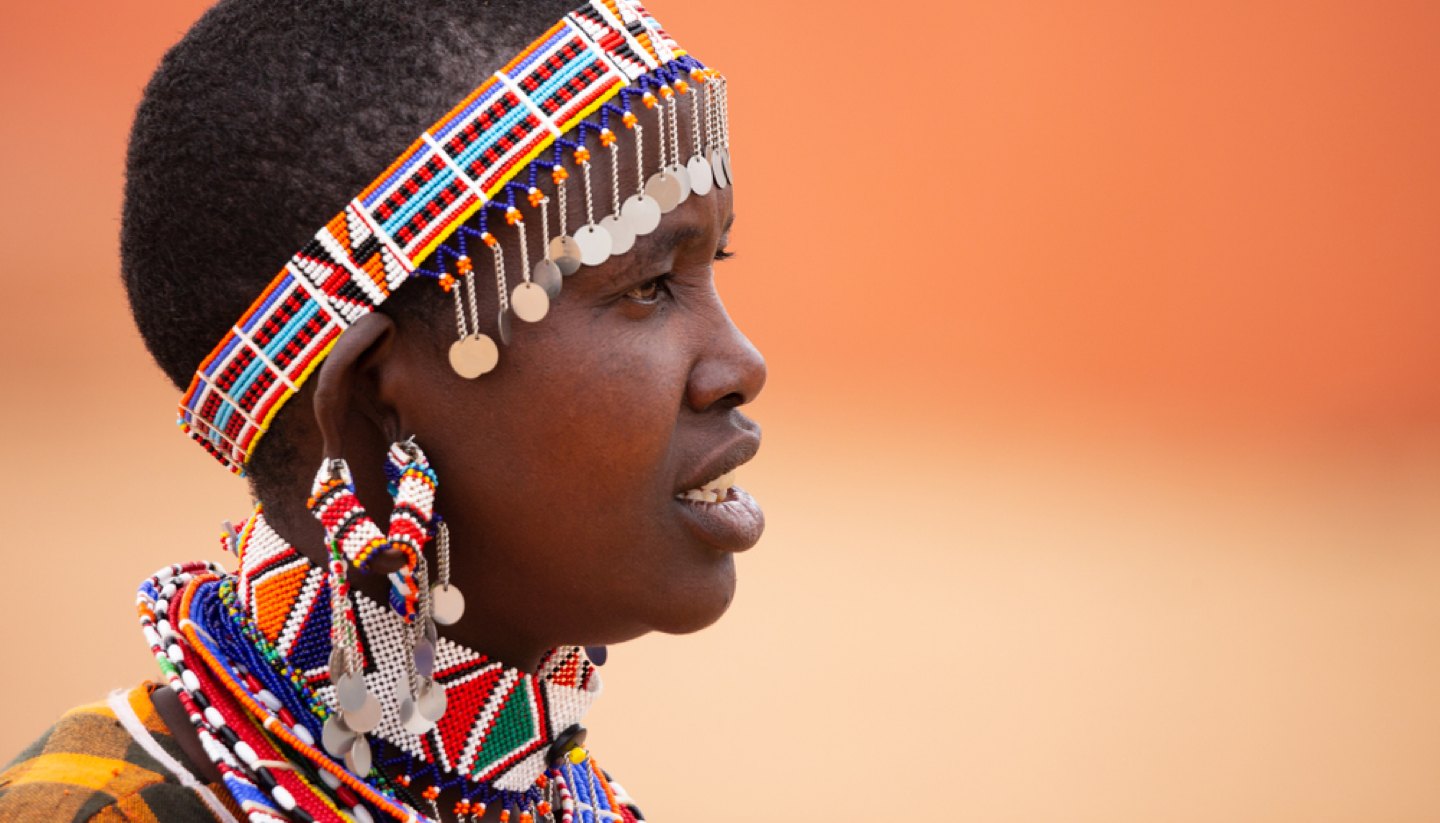
Introducing Kenya
About kenya.
- Images of Kenya
- History, language & culture
- Weather & geography
- Doing business & staying in touch
Plan your trip
- Travel to Kenya
- Where to stay
While you’re there
- Things to see & do
- Shopping & nightlife
- Food & drink
- Getting around
Before you go
- Passport & visa
- Public Holidays
- Money & duty free
Book your flights
- Mombasa Moi International Airport
- Nairobi Jomo Kenyatta International Airport
- Bamburi Beach
- Diani Beach
- Mombasa beaches
Kenya travel guide
Lions and leopards are just part of the landscape in Kenya, one of East Africa's favourite safari destination. More than 40 national parks and nature reserves are scattered between Lake Victoria and the Indian Ocean, covering every imaginable landscape and featuring just about every animal in Africa: from aardvarks to zebras.
As you might expect, wildlife safaris are the lifeblood of Kenyan tourism, and the infrastructure for travellers is impressive. Jeeps, buses and light aircraft fan out daily across the country to safari lodges and tented camps, some simple and rustic, others lavish and opulent. Refreshingly, you can enjoy close encounters with nature even on a budget, with walking safaris run by tribal guides and economic-tented camps that scrimp on creature comforts, but not on creatures.
Most people start their journey in Nairobi, Kenya's capital city, but few linger when there are more attractive cities strung out along the sun-kissed Kenyan coast and dotted around the Great Rift Valley. Whether you pick the interior or the coast (with its beach resorts and Islamic ruins), you can be sure to find a national park or reserve close at hand. Even Nairobi has a national park within the city limits, with zebras and giraffes just a stone's throw from the suburbs.
Kenya is also a great place for cultural encounters, with more than 40 different tribal groups, each following its own unique way of life. The semi-nomadic Maasai tribe, with their multi-coloured, bead-covered adornments, is perhaps the most obvious group, but visiting any tribal village is a fascinating and enlightening experience.
On appearances, Kenya would seem like the perfect holiday destination, but tourism has had its ups and downs in recent years, with political upheaval during elections and a string of high-profile militant attacks in Nairobi and along the coast.
These setbacks have made a noticeable dent in Kenya's tourist industry, yet travellers still flock to the teeming plains of the Maasai Mara and trek the slopes of Mount Kenya, and the biggest decision for most is not whether to go to Kenya, but instead, which wild animal to search for first.
580,367 sq km (224,081 sq miles).
52,580,497 (2019).
79.2 per sq km.
President William Ruto since 2022.
Travel Advice
Your travel insurance could be invalidated if you travel against advice from the Foreign, Commonwealth & Development Office (FCDO).
Areas where FCDO advises against all but essential travel
Kenya-somalia border and northern parts of the east coast.
Due to the risk of terrorism from groups based in Somalia, FCDO advises against all but essential travel to:
- within 60km of Kenya’s border with Somalia
- Eastern Garissa County, up to 20km north-west of the A3 road, including the Boni National Reserve
- Mandera County, excluding Mandera West sub-county
- Lamu County, excluding Lamu Island and Manda Island
- Tana River County north of the Tana River, up to 20km north-west of the A3 road
- within 15km of the east coast between the Tana River and the Galana (Athi-Galana-Sabaki) River
Find out more about why FCDO advises against travel .
Before you travel
No travel can be guaranteed safe. Read all the advice in this guide. You may also find it helpful to:
- see general advice for women travellers
- read our guide on disability and travel abroad
- see general advice for LGBT+ travellers
- read about safety for solo and independent travel
- see advice on volunteering and adventure travel abroad
Travel insurance
If you choose to travel, research your destinations and get appropriate travel insurance . Insurance should cover your itinerary, planned activities and expenses in an emergency.
About FCDO travel advice
FCDO provides advice about risks of travel to help you make informed decisions. Find out more about FCDO travel advice .
Follow and contact FCDO travel on Twitter , Facebook and Instagram . You can also sign up to get email notifications when this advice is updated.
This information is for people travelling on a full ‘British citizen’ passport from the UK. It is based on the UK government’s understanding of the current rules for the most common types of travel.
The authorities in Kenya set and enforce entry rules. If you’re not sure how these requirements apply to you, contact the Kenyan High Commission in the UK .
COVID-19 rules
You do not need a negative COVID-19 test or proof of vaccination to enter Kenya.
If you have flu-like symptoms when you arrive, you must take one or more COVID-19 tests at your own expense. If tests show you have COVID-19, you must isolate. For more information see COVID-19 travel requirements from the Kenya Civil Aviation Authority .
Passport validity requirements
To enter Kenya, your passport must have an ‘expiry date’ at least 6 months after the date you arrive and at least 2 blank pages.
Check with your travel provider that your passport and other travel documents meet requirements. Renew your passport if you need to.
You will be denied entry if you do not have a valid travel document or try to use a passport that has been reported lost or stolen.
Visa requirements
You must apply online for electronic travel authorisation in advance of travel. The local authorities recommend applying at least 2 weeks before your departure.
Travellers who currently hold a visa can continue to travel using their visa until it expires.
For information on work permits and residency, check the Kenyan Department of Immigration requirements.
Vaccine requirements
To enter Kenya, you must have a certificate to prove you’ve had a yellow fever vaccination if you’re coming from a country listed as a transmission risk .
For full details about medical entry requirements and recommended vaccinations, see TravelHealthPro’s Kenya guide .
Customs rules
There are strict rules about goods you can take into or out of Kenya . You must declare anything that may be prohibited or subject to tax or duty.
Taking drones into Kenya
It is illegal to import or export drones without prior approval from the Kenya Civil Aviation Authority ( KCAA ) . Contact the KCAA well in advance of travel if you wish to bring a drone to Kenya.
This guide also has safety advice for regions of Kenya .
There is a high threat of terrorist attack globally affecting UK interests and British nationals, including from groups and individuals who view the UK and British nationals as targets. Stay aware of your surroundings at all times.
UK Counter Terrorism Policing has information and advice on staying safe abroad and what to do in the event of a terrorist attack. Find out how to reduce your risk from terrorism while abroad .
Terrorism in Kenya
Terrorists are very likely to try to carry out attacks in Kenya.
There is a heightened threat of terrorism across Kenya. Attacks could target westerners, including British nationals. These could occur at any time including at religious events, public holidays or celebrations. Attacks are indiscriminate and could occur in places visited by foreigners, including tourists, such as, but not limited to:
- hotels, bars, restaurants and nightclubs
- sporting events
- supermarkets and shopping centres
- safari parks
- commercial and government buildings
- places of worship
Be particularly alert in these places. If you go regularly to any location, try to vary timings and patterns of movement. Always travel during daylight hours if possible. Look at the security arrangements in buildings you visit, including bag searches, physical security and guards. The main terrorist threat is from extremists linked to Al Shabaab – an Al Qaida-affiliated militant group in Somalia. Al Shabaab has issued threats and carried out attacks against Kenya, in part, due to Kenyan military intervention in Somalia. See Regional risks .
Recent significant attacks include :
- in 2020 Al Shabaab conducted an attack on a military airstrip in Lamu County, killing 3 people
- in 2019 there was an attack at the hotel and commercial complex at 14 Riverside in Nairobi, resulting in injuries and loss of life
There is some evidence of growing support for Daesh (formerly ISIL) in Kenya. On 4 January 2024 Daesh published a statement calling for a new global campaign of terrorism including a specific focus on western and Jewish targets. This statement and the ongoing conflict in Israel and the Occupied Palestinian Territories could increase the likelihood of terrorist attacks that affect British nationals.
Lamu Island and Manda Island
Travellers to Lamu Island and Manda Island should be particularly vigilant given the close proximity of these islands to the Lamu County mainland. You should only travel to the islands by air to Lamu airport (a civilian airport on Manda Island), and not by road. The only commercial option for air travel to or from Lamu Island and Manda Island is through Lamu airport. See Regional risks .
Terrorist kidnap
There is a high threat of terrorist kidnap across Kenya. You should be alert to the heightened threat of terrorist kidnapping targeting westerners, including British nationals. Westerners have been the target of kidnaps in northern counties bordering Somalia and coastal counties. Further kidnaps are very likely.
British nationals are seen as legitimate targets, including tourists, humanitarian aid workers, journalists and business travellers. If you are kidnapped, the reason for your presence is unlikely to protect you or secure your safe release.
The long-standing policy of the British government is not to make substantive concessions to hostage takers. The British government considers that paying ransoms and releasing prisoners builds the capability of terrorist groups and finances their activities. This can, in turn, increase the risk of further hostage-taking. The Terrorism Act (2000) makes payments to terrorists illegal.
Political situation
Recent weeks have seen major protests across multiple cities in Kenya, including Nairobi and Mombasa. A number of protestors have been injured and killed. The situation could change quickly. Avoid political gatherings and large crowds and monitor local media to see when and where major protests are likely. Follow local news and the instructions of local authorities closely.
There are frequent incidents of violent crime including mugging, armed robbery and carjacking, particularly in the large cities and on major highways.
Although uncommon, violent crimes have resulted in the deaths of British nationals, including during daylight hours.
Avoid walking alone in isolated areas, including in daylight. Criminals might target you directly, so be aware of your surroundings and make sure people know where you are and when you are due to return. The risks are higher in some areas of major cities.
In Nairobi:
- Central Business District
- Mathare, Kibera and slum areas
In Mombasa:
- in the Old Town
- on and around the Likoni Ferry, which links Mombasa to the southern resorts
Crime rates are often higher around the Christmas and New Year period so take extra precautions at this time of year.
Protecting your belongings
Bag-snatching is common in bus stations, railway stations and airports. Be vigilant and take note of any security advice given by your hotel, employer or your hosts. If you’re attacked, do not resist. Avoid carrying large sums of money or wearing expensive-looking jewellery or watches.
Vehicle crime
Always drive with windows closed and doors locked. When driving outside of cities and in remote areas, consider driving in convoy. Avoid driving at night if possible. Carjackers may set up bogus checkpoints. See Transport risks .
Beware of thieves posing as police officers or private security guards. It’s a technique used by criminals to take charge of valuables, passports and vehicles and steal them. Always ask for identification.
Drink and food spiking
Do not accept drinks or food from strangers in bars or clubs. Criminals spike drinks to weaken and confuse their victims and then commit theft or sexual assault.
Attacks and sexual assault
Sexual assaults are rare, but do happen, and can affect both male and female travellers.
Laws and cultural differences
Personal id.
You must always carry ID. A copy of your passport is normally acceptable, but police officers may insist on seeing the original document so keep it within a reasonable travelling distance.
The coastal areas of Kenya are mainly Muslim. Show courtesy by dressing conservatively away from tourist resorts and hotels – particularly in Mombasa. Wearing holiday-style clothing is likely to get negative attention at religious sites or buildings.
Smoking and e-cigarette bans
It is illegal to smoke in any public place in Kenya, except in designated smoking areas. If you smoke in a prohibited place, you could get a fine of up to 50,000 Kenyan shillings or up to 6 months in prison.
Illegal drugs and prison sentences
If you’re convicted of using illegal drugs in Kenya, you will get a heavy fine and prison sentence. The penalty for possession is up to 10 years in prison. People found to be trafficking illegal drugs could face life imprisonment.
Using cameras in secure areas
It is illegal to take photographs of official buildings, including embassies, or at airports. You could be arrested if caught.
LGBT+ travellers
Same-sex sexual activity is illegal and same-sex relationships are not tolerated in Kenya’s conservative society. Showing affection in public could lead to arrest and imprisonment.
Read more advice for LGBT+ travellers .
Wildlife, animal products and souvenirs
It is illegal to buy, sell, kill or capture any protected wild animal or trade any of its parts without a licence. If you are caught buying or trafficking banned goods, you could face a fine or prison sentence.
Outdoor activities and adventure tourism
Game reserves and national parks.
If you’re visiting game reserves, use reputable tour operators and arrive at your destination in daylight hours. Do not buy safari tours from touts. Always follow park regulations and advice from wardens.
There are risks associated with viewing wildlife, particularly on foot or at close range. Swimming in rivers and lakes is illegal in national parks and is best avoided elsewhere due the dangers from wildlife and waterborne diseases.
Hiking and mountaineering
You must hire a local guide on certain hikes in Kenya. Be conscious of the risk from wildlife and do not approach wild animals. Make sure your travel insurance covers all your planned activities.
Altitude sickness is a risk when hiking in high-altitude areas, including on Mount Kenya. Read about altitude sickness on TravelHealthPro .
Transport risks
Road travel.
If you are planning to drive in Kenya, see information on driving abroad .
You can use a UK photocard driving licence in Kenya for up to 3 months. If you still have a paper driving licence, you may need to update it to a photocard licence .
After 3 months, you’ll need to have both the 1968 version of the international driving permit ( IDP ) and your UK driving licence with you in the car. You cannot buy an IDP outside the UK, so get one before you travel.
If you’re staying longer or living in Kenya, you’ll need to get a Kenyan driving licence.
Driving standards are often poor. There is a risk of vehicle crime – see Crime .
Jomo Kenyatta International Airport to Nairobi City
For travel between Jomo Kenyatta International Airport and Nairobi City, use the Mombasa Road or the Nairobi Expressway. There is a higher risk of carjacking on the old airport road (Airport South Road) and Jogoo Road.
The Mombasa Road can get very busy during rush hour, and check-in can take several hours. Allow plenty of time to get to the airport. A vehicle security check outside the airport may add to your journey time.
Travel in remote areas
Monitor local media and take care in all remote areas. The Kenya Tourism Federation Safety and Communication Center provides tourist advice and emergency help.
There have been serious accidents involving long-distance buses and minibuses (‘matatus’). The accidents are often due to poor maintenance and speeding. Often minibuses are uninsured. Check operators’ safety standards.
There are frequent minibus hijackings and robberies.
Driving fines
On-the-spot fines from traffic police are common but illegal. If a traffic police officer stops you, ask them to issue you with the correct paperwork.
If you charter a private aircraft, check with the company about the condition of the aircraft and runways. If the air crew does not include a safety pilot, qualified to take over the controls, find another company that does.
Rail travel
Passenger trains run between Nairobi and Mombasa. Take care of your belongings while on the train and at railway stations. If you leave your compartment, take your valuables with you.
Piracy and armed robbery off the coast of Somalia, in the Gulf of Aden and Indian Ocean remain a significant threat.
See piracy and armed robbery at sea .
Extreme weather and natural disasters
Find out what you can do to prepare for and respond to extreme weather and natural hazards .
Earthquakes
Kenya lies on an active fault and tremors occur from time to time. The last significant earthquake to affect the region was of magnitude 5.2 in 2007.
The US Federal Emergency Management Agency has advice about what to do before, during and after an earthquake .
This section has safety advice for regions of Kenya. It only covers regions where FCDO has specific advice.
You should also read FCDO ’s overall travel advice and safety and security advice .
Due to the risk of terrorism from groups based in Somalia, FCDO advises against all but essential travel to:
- within 15km of the coast between the Tana River and the Galana (Athi-Galana-Sabaki) River
There have been frequent attacks in the north-eastern border regions, most of which were attributed to Al Shabaab.
Attacks have killed members of the Kenyan security forces as well as civilians. The Kenyan security forces have increased their presence in the affected areas. Armed militia groups operate within the Boni National Reserve and along the border with Somalia. See Terrorism .
If you travel to Lamu Island or Manda Island, you should fly to Lamu Airport (a civilian airport on Manda Island). Do not travel by road. See Terrorism .
For travel between Jomo Kenyatta International Airport and Nairobi City, you should use the Mombasa Road or the Nairobi Expressway. See Transport risks .
North and north-east Kenya
Rural areas, particularly in the north and north-east of Kenya, occasionally experience cattle rustling, banditry and ethnic clashes. Foreign nationals are not usually the target, but you should take great care.
Turkana, West Pokot, Elgeyo-Marakwet, Baringo, Laikipia and Samburu counties
The Kenyan government has imposed a dusk-to-dawn curfew in parts of Turkana, West Pokot, Elgeyo-Marakwet, Baringo, Laikipia and Samburu counties. Follow local security measures and use caution.
Kenya-Ethiopia border
There have been attacks using landmines around Moyale, close to the main A2 road south. Vehicles crossing the Kenya-Ethiopia border at this point should stay on the A2. Avoid staying at the rest house at Sololo – travel directly to Marsabit before breaking the journey.
Mount Elgon
There is a large security presence in Mount Elgon because of armed clashes. Further incidents are possible. Seek local advice before you set off.
Before you travel check that:
- your destination can provide the healthcare you may need
- you have appropriate travel insurance for local treatment or unexpected medical evacuation
This is particularly important if you have a health condition or are pregnant.
Emergency medical number
Dial 999 and ask for an ambulance.
Contact your insurance company quickly if you’re referred to a medical facility for treatment.
Vaccine recommendations and health risks
At least 8 weeks before your trip:
- check the latest vaccine recommendations for Kenya
- see where to get vaccines and whether you have to pay on the NHS travel vaccinations page
See what health risks you’ll face in Kenya , including:
- malaria and dengue
- schistosomiasis
Altitude sickness is a risk in parts of Kenya. Read more about altitude sickness on TravelHealthPro .
The legal status and regulation of some medicines prescribed or bought in the UK can be different in other countries.
Read best practice when travelling with medicines on TravelHealthPro .
Healthcare in Kenya
FCDO has a list of medical facilities in Kenya .
There is also guidance on healthcare if you’re living in Kenya .
Travel and mental health
Read FCDO guidance on travel and mental health . There is also mental health guidance on TravelHealthPro .
The Foreign, Commonwealth & Development Office ( FCDO ) cannot provide tailored advice for individual trips. Read this travel advice and carry out your own research before deciding whether to travel.
Emergency services in Kenya
Telephone: 999 (ambulance, fire, police)
Kenya Tourism Federation
Kenya Tourism Federation’s Safety and Communication Center provides tourist advice and emergency help.
Contact your travel provider and insurer
Contact your travel provider and your insurer if you are involved in a serious incident or emergency abroad. They will tell you if they can help and what you need to do.
Refunds and changes to travel
For refunds or changes to travel, contact your travel provider. You may also be able to make a claim through insurance. However, insurers usually require you to talk to your travel provider first.
Find out more about changing or cancelling travel plans , including:
- where to get advice if you are in a dispute with a provider
- how to access previous versions of travel advice to support a claim
Support from FCDO
FCDO has guidance on staying safe and what to do if you need help or support abroad, including:
- finding lawyers and funeral directors in Kenya
- dealing with a death in Kenya
- being arrested or imprisoned in Kenya
- getting help if you’re a victim of crime
- getting help if you’ve been a victim of rape or sexual assault in Kenya
- what to do if you’re in hospital
- if you’re affected by a crisis , such as a terrorist attack
Contacting FCDO
Follow and contact FCDO travel on Twitter , Facebook and Instagram . You can also sign up to get email notifications when this travel advice is updated.
You can also contact FCDO online .
Help abroad in an emergency
If you’re in Kenya and you need emergency help from the UK government, contact the British High Commission in Nairobi .
FCDO in London
You can call FCDO in London if you need urgent help because something has happened to a friend or relative abroad.
Telephone: 020 7008 5000 (24 hours)
Find out about call charges
Risk information for British companies
The Overseas Business Risk service offers information and advice for British companies operating in Keny a on how to manage political, economic, and business security-related risks.

Book a Hotel
© Columbus Travel Media Ltd. All rights reserved 2024

8-Day Kenya Itinerary: A Perfect First-Timers’ Guide to Explore the Wilderness

Kenya, a land of astounding beauty and cultural diversity, stands as a shining gem among the world’s best travel destinations. With a moderate climate throughout the year and a remarkable variety of experiences to offer, Kenya is the epitome of an all-year-round travel paradise.
This East African jewel beckons adventurers, wildlife enthusiasts, and culture seekers alike to explore its pristine landscapes, iconic wildlife, and vibrant traditions. Whether you’re drawn to the majestic savannas, ancient cultures, or the wonders of the Great Rift Valley, Kenya’s enchanting allure knows no season, making it a timeless choice for every traveler’s bucket list.
Keep reading for my Kenya itinerary for first-time visitors to the country.

8-Day Kenya itinerary
I’ve been lucky to have spent a month in Kenya , and here’s a perfect 8-day Kenya itinerary to help you plan an amazing trip.
Check our guide on how to get the Kenya eVisa .
Day 1: Arrival in Nairobi
Begin your adventures in Nairobi , the lively capital city known for its warm and welcoming people. As you step into Nairobi’s bustling streets, immerse yourself in the vibrant local culture, and don’t forget to savor some delectable street food.
If you’re fortunate to arrive in Nairobi early in the morning, kick off your day with a heartwarming visit to the David Sheldrick Wildlife Trust. They open their doors between 11 AM and 12 PM, allowing you to spend precious moments with orphaned elephants and gain insight into their remarkable conservation efforts. It’s an experience that’s both touching and educational.
Afterward, make your way to the Giraffe Center, where you can get up close and personal with these gentle giants, the Rothschild giraffes. Feeding and interacting with them is a truly memorable experience.
While in Nairobi, don’t miss the opportunity to explore the local markets, where you can find traditional beaded jewelry, a perfect memento to remember your Kenyan journey by.
As the sun sets over Nairobi, conclude your day with a night of fun and excitement in this vibrant city, filled with opportunities for entertainment, dining, and cultural experiences. Nairobi’s energetic nightlife promises a perfect end to your first day in Kenya.

Day 2: Journey to Maasai Mara
Rise and shine early as your Kenya itinerary leads you to the iconic Maasai Mara National Reserve. The scenic drive, lasting approximately five and a half hours, promises breathtaking landscapes that will captivate your senses. By midday, you’ll find yourself at the doorstep of Maasai Mara.
To make the most of your Maasai Mara experience, consider booking a comprehensive package that includes accommodation and exhilarating game drives. After a satisfying lunch, your anticipation will be met with the thrill of an afternoon game drive, scheduled from 3:30 PM to 6:30 PM. This is your first opportunity to witness the abundant wildlife that calls Maasai Mara home.
Following your captivating game drive, indulge in a restful night’s sleep, as more incredible wildlife encounters await in the days to come.

Day 3: Enjoy the Game Drives in Maasai Mara
Embrace a full day of thrilling wildlife adventures in Maasai Mara. You can embark on an exhilarating full-day game drive, commencing in the early morning hours, when the wild inhabitants of this region are at their most active.
Keep in mind that animals in their natural habitat follow their own schedules, which may lead to awe-inspiring encounters or moments of patient observation. Both experiences are equally valuable and should be cherished.
In addition to your wildlife odyssey, consider adding a cultural dimension to your day by participating in a village tour. Pay a visit to the Maasai tribes and explore their traditional villages on the outskirts of the reserve. Immerse yourself in their rich culture and traditions, gaining a deeper appreciation for the remarkable coexistence of the Maasai people and the wild creatures of Maasai Mara.
Related read: Kenya Attractions: A Guide to Experiencing Kenya

Day 4: Travel to Lake Nakuru National Park
As we bid adieu to the captivating beauty of Maasai Mara, our next destination is the enchanting Lake Nakuru National Park. Nestled within the Great Rift Valley, this national park is renowned for its population of endangered rhinoceros and a myriad of other fascinating wildlife. Your upcoming wildlife encounters are destined to be unparalleled and etched into your memory forever.
The journey to Lake Nakuru is approximately five hours from Maasai Mara, offering a chance to revel in the changing landscapes as you transition from one remarkable location to another. Upon your arrival at Lake Nakuru, your lodge is likely to organize a game drive for the latter part of the day, ensuring that your adventure continues without pause.

Day 5: Exploring Lake Nakuru & Lake Naivasha
You can spend this day sightseeing and exploring the wonders of Lake Nakuru. Your first stop has to be the Baboon Cliff View Point, a must-visit attraction. Here, you’ll encounter amiable baboons and enjoy a magnificent panoramic view of the national park, a perfect spot for capturing breathtaking moments.
Next on your agenda is a day trip to Lake Naivasha, a mere two-hour drive from the Baboon Cliff. This scenic lake is renowned for its resident hippo population and provides an ideal setting for observing these magnificent creatures in their natural habitat. Get ready for a day filled with natural wonders and unforgettable encounters.


Day 6: Journey to Amboseli National Park
This is one of my favorite parks in Kenya, and in no way can you miss this! As you approach Amboseli National Park , be prepared to be utterly captivated by the awe-inspiring views of Mount Kilimanjaro , which will stand before you in all its majestic glory.
Once you’ve reached your destination, indulge in a series of exhilarating game drives. All while the towering presence of Mount Kilimanjaro serves as a breathtaking backdrop to your adventures. Amboseli is renowned for its abundant elephant population, making it the perfect place for you to spot these gentle giants in their natural habitat.
Your day in Amboseli promises unforgettable moments, offering you a unique blend of African wilderness and the towering grandeur of Kilimanjaro, ensuring that your journey continues to be nothing short of extraordinary.
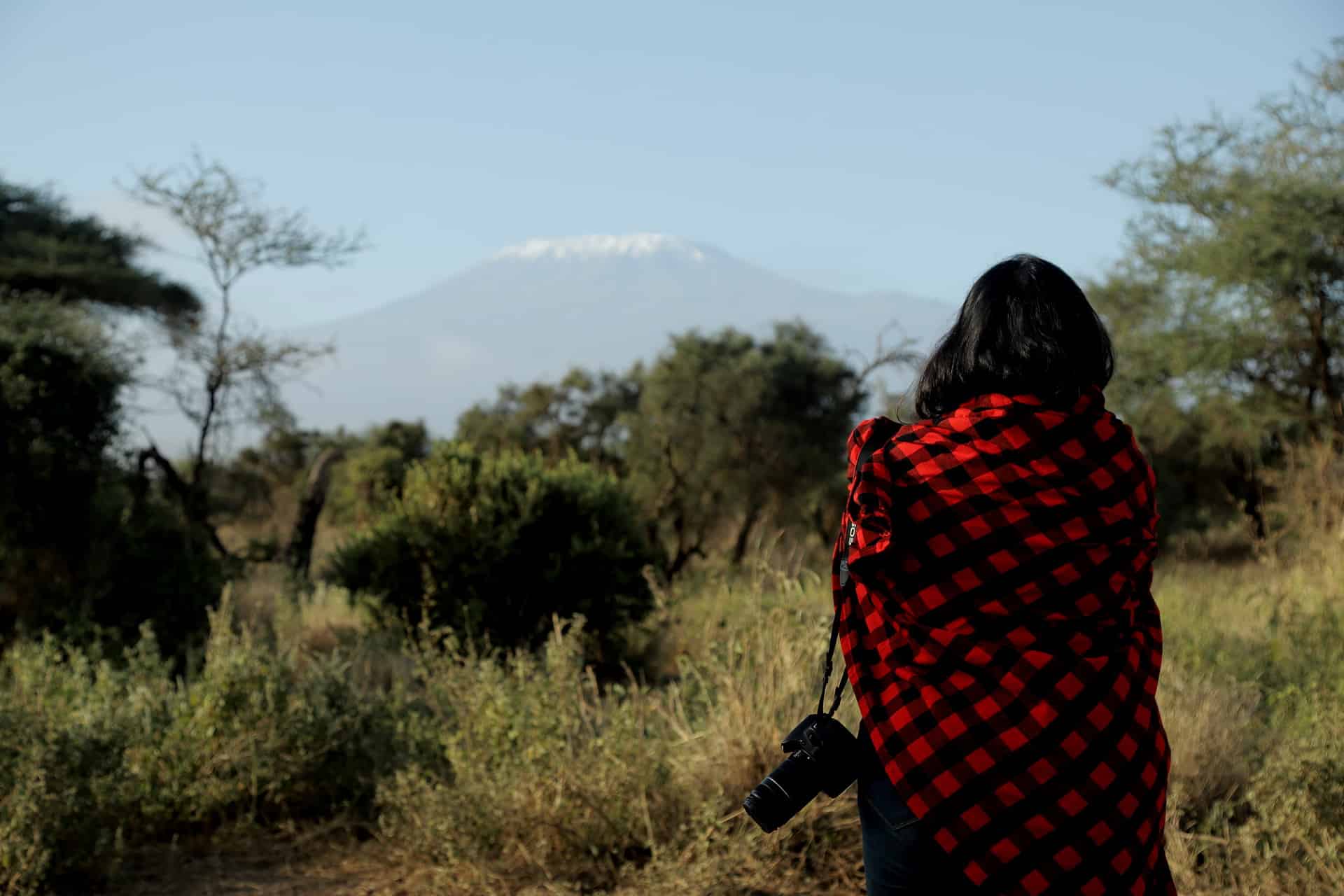
Day 7: Exploring Amboseli and returning to Nairobi
Get ready for your remarkable journey, and anticipate a thrilling half-day safari in Amboseli, providing you with a final opportunity to delve deeper into the untamed wilderness. Set out to explore more of the national park, where the beauty of the African landscape and the wildlife will leave a lasting impression.
In the afternoon, it’s time to bid farewell to Amboseli and embark on your journey back to Nairobi, where your adventure began. Reflect on the incredible moments, breathtaking landscapes, and unforgettable wildlife encounters as you return to the vibrant capital city.

Day 8: Bidding goodbye to Nairobi
On your last day in Kenya, if time permits, seize the opportunity to enjoy a quick drive through Nairobi National Park . It’s a unique gem, being the only national park in the world set amidst a bustling capital city. Witness the coexistence of urban life and untamed nature before you embark on your journey back home.
As you board your flight, departing from Nairobi, reflect on the incredible adventures, cultural experiences, and wildlife encounters that have enriched your Kenyan expedition. Your return journey may mark the end of your physical presence in Kenya, but the indelible memories you’ve collected during this extraordinary journey will remain with you, etching Kenya’s beauty and allure into your heart and soul forever.
Kenya’s unique blend of vibrant urban life in Nairobi, the enchanting culture of its diverse tribes, and the awe-inspiring wildlife left an indelible mark on my heart. Not only did I have the privilege of volunteering in Nairobi , where I connected with the local community and witnessed the resilience and hope of the people, but I also embarked on a breathtaking exploration of a country oozing with natural wonders.
From the bustling markets and flavorful street food to the tranquil moments of watching wildlife in Maasai Mara and Amboseli, Kenya’s diverse tapestry of experiences touched my soul.
Riyanka is a traveler who is keen on exploring different parts of the world. She's a freelance blogger who's equally passionate about photography. Her quest is to turn all her journeys into beautiful stories. Being a die-hard ‘mountain-aholic‘, her favorite destinations are all around the Himalayas! She can spend days gazing at the snow-capped mountains, binge on Maggi and lemon-honey-ginger tea and reading Ruskin Bond books.
RELATED ARTICLES MORE FROM AUTHOR
Top tips for booking an african safari with an agent, discover the rhinos of mosi-oa-tunya national park, 8 days in rwanda itinerary: trekking, tea plantations, and gorilla conservation, check out & follow:, similar travel tips, a guide to climbing the rwenzori mountains, walking inside the pyramids of giza, egypt, mauritius: the island of incredible colors, explorer videos, visit ljubljana – a look at the city, food and region, travel in covid-19 times – my trip to lanzarote in the..., costa brava, spain: the culture guide, more travel tips, gear guide: must haves for camping and hiking, how to get f1 grand prix tickets, a summer of house sitting in europe, follow us on instagram @/traveldudes/.
- Advertise and Media
14 things you need to know before traveling to Kenya

Nov 21, 2023 • 7 min read

Make the most of your travel through Kenya with these practical tips © Bartosz Hadyniak / Getty Images
Think of Kenya and your mind instantly fills with exquisite scenes of safari jeeps and beautiful beaches lapped by the Indian Ocean.
But the incredible experiences stretch beyond Kenya's natural landscapes – Nairobi offers exciting urban and cultural encounters, too.
Here’s everything you need to know to make the most of a trip to this East African nation, from clothing and etiquette to safety and visas.
1. Check the visa requirements for Kenya
Many nationalities need to obtain a visa before departing for Kenya. Check the official visa website and allow time to complete your application. Random checks can mean extra questions for some travelers, even after submission and payment.
You won’t receive an email confirmation of your Kenya visa application or payment, so you need to log in to check its status. Once issued, print a color copy (or two) of the visa and payment and keep them on hand, even for domestic flights, such as between Nairobi and Mombasa.
The good news for citizens of African countries is visas for Kenya will be a thing of the past next year. The Kenyan President, William Ruto, recently announced that visa requirements will end for all African nations by the end of 2023.
Proof of a COVID-19 vaccination and a negative PCR test is no longer required to enter Kenya. However, travelers exhibiting flu-like symptoms will be required to take a PCR test and fill out a passenger locator form.
2. Pack smart for Kenya – it’s not always hot
Early morning safaris can be chilly, so it’s wise to take layers for a trip to Kenya. Similarly, temperatures can drop at night in the highlands. Fleeces and even windproof waterproofs are recommended.
On the other hand, staying cool is key by the coast or in the city. Pack cool, breathable fabrics and always cover up in the midday sun.
3. Leave your plastics at home
Kenya banned single-use plastic bags in 2017, so leave any carrier bags (and preferably single-use plastic water bottles and straws) at home. The bag ban is countrywide – luggage is often scanned, so don’t pack shoes or other items in plastic bags.
Single-use plastic bottles and straws are banned in national parks – bring a reusable water bottle from home.
4. Do you need malaria tablets for Kenya? Probably.
The risk of malaria is low in Nairobi, and in the highlands above 2500m (8200ft), but you should still avoid being bitten. The majority of Kenya falls into a malarial zone, so take advice on which antimalarial is best suited to you between atovaquone/proguanil, doxycycline or mefloquine.
Brand names you might be more familiar with include Malarone and Lariam, but check with your physician, pharmacy or travel clinic. Ideally do this a month in advance of your trip, as you may have to begin taking the pills some time before your trip begins.

5. Greet people with “ mambo ” or “ niaje ”
“ Jambo ” is the best-known greeting in this fantastically friendly country, but if you want to show off your sheng (a Swahili and English combo originating among Nairobi’s younger population), try greeting people with “ mambo vipi .” The common reply is “ poa .” Alternatively, say “ niaje ,” to which someone will reply with “ niaje .”
6. Feel free to bargain, but don’t go too far
A sense of humor is essential when bargaining. It’s fine to offer a lower price in markets and some shops – many sellers will start with a higher price, and it can be fun to barter and meet in the middle.
Few sellers will accept an offer that's too low so have some fun with it – just bear in mind what you’re prepared to pay, be respectful and don’t over-haggle.
7. Leaving a tip goes down a treat
Tipping isn’t expected in Kenya, but if you’ve had a good meal or service, leaving around 10% is appreciated. In hotels, you can also tip porters and housekeeping staff. Some calculate it at Ksh100 to Ksh200 a day while others round it up at the end. Keep small change on you for tips and shopping in markets.
If you’re taking a taxi, round up to the nearest 100, but tips are not always necessary. Taxi apps are popular, and you can add a tip at the end of the journey through the app. Avoid giving money in exchange for preferential service.

8. Be respectful of local communities
Never take photos of people without asking permission, particularly in rural areas and in Mombasa . If you want to publish any photos, even on social media, it’s respectful to carry a consent form and say “ asante ” (thank you).
Be particularly conscious around children or other vulnerable people. If you’re given the OK to take a photo, show it to them after you've taken it. Think twice before visiting a school (or anywhere that would be strange or inappropriate for you to go to in your home country).
Also note: anyone taking photos of infrastructure, airports and the military may come under suspicion.
9. Dress appropriately – but don’t overthink it
Kenya is moderately conservative, but that doesn’t mean you need to cover your shoulders and knees everywhere. In Nairobi, in towns and on safari, shorts, dresses and sleeveless tops are fine to wear, and the same goes for most beach resorts , although walking around in swimwear isn’t appropriate.
In Muslim communities such as Lamu Town, dressing more conservatively is advised. Loose clothing can be more comfortable in the heat.

10. Don’t rush – go with the flow
It’s misleading to suggest the whole of Kenya operates on some slower “Kenya time” – Nairobi can have the same pace and rhythm as any major city. But the heat and humidity of the coastal areas, around Mombasa, Malindi and Lamu for example, can mean life needs to be lived at a more relaxed pace.
Bear that in mind before expecting certain tasks and services to be carried out immediately, and instead, go with the flow and enjoy a pole pole (“slowly” in Swahili) way of life.
11. You can boil the tap water in Kenya and drink it
Tap water in Kenya isn’t off-limits. If you have the facilities, you can boil the tap water – it’s soft and sweet – and drink it once cooled.
Obviously, that's not always an option, in which case filtered water in restaurants and hotels is safe. You can buy plastic-bottled water, but it’s obviously a lot more ecofriendly to bring your own reusable bottle and water filter or tablets.

12. Pack a power bank
Power cuts in Kenya can occur (they’re usually not for long), so if you rely on your smartphone, take a power bank and ensure it’s always charged. Take a spare camera battery if you're going on safari – and a decent flashlight is helpful in case of power cuts but also when walking around the safari camp at night.
In addition to helping you navigate in low light, it will help you look out for insects and snakes. Headlamps are especially handy on a campsite for reading and for nighttime bathroom trips.
13. Don’t be scared by headlines, but know your geography
People often ask, “Is Kenya safe for tourists?” Few incidents involve tourists, especially in game reserves and tourist areas, but there are a few areas it's better to avoid.
These include but are not limited to, within 60km (37 miles) of the Kenya-Somalia border, Garissa County and Lamu County (excluding Lamu Island and Manda Island – travel by air if you're planning a visit).
Check the latest guidelines from your government before traveling. In Nairobi, as with any major city, keep valuables safe and your wits about you.
14. Keep embassy and consulate details to hand
Wherever you’re from, it’s savvy to know the contact details of your embassy or consulate. Take photos of your passport, visa and other documents, so you can access them on your phone or email.
Carry an original form of ID if possible. A driver's license is useful if you don’t want to carry your passport with you every day.
This article was first published Mar 8, 2022 and updated Nov 21, 2023.
Explore related stories

Tips & Advice
Jul 9, 2024 • 8 min read
Plan your travels in Kenya with this guide to the best places to visit.

Feb 20, 2024 • 17 min read

Jan 30, 2024 • 8 min read

Jan 5, 2024 • 19 min read

Dec 8, 2023 • 4 min read

Nov 30, 2023 • 9 min read

Nov 29, 2023 • 4 min read

Nov 19, 2023 • 10 min read

Nov 17, 2023 • 7 min read
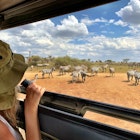
Nov 15, 2023 • 5 min read
- Meet the Team
- Our Manifesto
- Work with Us
- Budget Travel
- Personal Development
- Work & Travel
- United Kingdom
- More of Europe
- Philippines
- More of Southeast Asia
- More of South America
- More of Central America
- South Korea
- More of Asia
- More of North America
- New Zealand
- Pacific Islands
- More of Oceania
- South Africa
- More of Africa
- More of the Middle East
- Travel Essentials
- Travel Gear
Home » Africa » Backpacking Kenya Travel Guide (2024)
Backpacking Kenya Travel Guide (2024)
Kenya is a dream destination for many — and it’s not hard to see why. From the unreal wildlife encounters you can get on a safari to its stunning coastline, Kenya is home to some pretty epic bucket list experiences.
And it isn’t exactly new to the backpacking scene, either. East Africa has been a mecca for travelers for years, and Kenya is often considered one of the most stable and friendly countries to visit in the entire region.
Can you go off the beaten path, though? Oh, you sure can — and I’m here to show you how.
Whether you have a couple of weeks or a couple of months, there is much left for the intrepid traveler to explore in Kenya. This guide will help you plan the ultimate East African adventure, giving you all the tools you need to have an epic time backpacking in Kenya.
We’ll be covering the best places to visit, our suggested itineraries, some safety tips, and how to cut down costs. Your trip to Kenya is one step closer!
Why go backpacking in Kenya?
Not much can beat spotting a lion in the savannah of the Maasai Mara or a herd of elephants against the backdrop of Mount Kilimanjaro. Kenya offers some of the best wildlife spotting opportunities on the continent!
Do you know about the Big Five? It’s what they call the elephant, lion, buffalo, rhino, and leopard. They’re some incredibly magnificent animals, and you’ll get to see them all when visiting Kenya’s National Parks .
But while a safari is undoubtedly a highlight of any trip to Kenya, you’ll be pleasantly surprised to know what else the country has to offer.
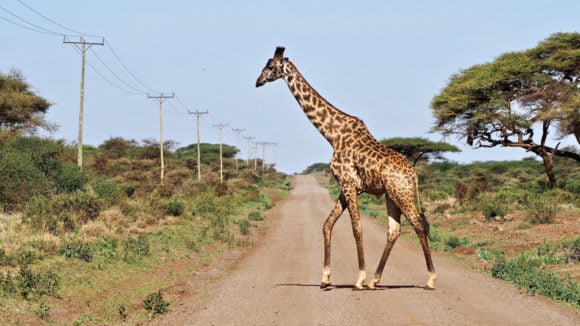
The Broke Backpacker is supported by you . Clicking through our links may earn us a small affiliate commission, and that's what allows us to keep producing free content 🙂 Learn more .
Heading east to the Indian Ocean coast, you’ll find long stretches of palm tree-lined beaches with the clearest azure water. Towards the equator, the snow-capped jagged peak of Mount Kenya stands tall over the harsh arid plains. Then you’ve got the bustling metropolitan center of Nairobi!
You’ll soon find that Kenya is probably way more than you had in mind…
Linger long enough, and you’ll come to appreciate the proud and fascinating tribal landscape of Kenya’s population. The Maasai people, the Samburu, Turkana, Swahili, and Kikuyu… these are cultural experiences that are bound to stay with you for life.
With so much to see and do, I’ve prepared a few itinerary options for you to consider when backpacking Kenya. Let’s get this started!
Best Travel Itineraries for Backpacking Kenya
Depending on what’s driving you to visit Kenya, I’d say you should spend anywhere from 10 days up to two months backpacking the country.
Most people opt for a quick safari trip and possibly a few days on the coast, but then again… most people never get to see the real Kenya.
You will, though! Below, I’m providing you with a few sexy itineraries for your Kenya trip. They’re based on my own trips there, but you can easily adjust them to suit your own adventure.
And mark my words: it’s gonna be an epic one.
Backpacking Kenya Itinerary 10 Days
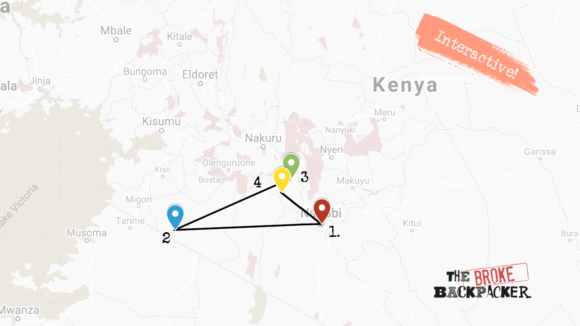
Most people begin their Kenya backpacking journey in Nairobi, the capital. And while it’s had a bad reputation in the past, the city can be a hella vibrant! Save at least one full day to explore the markets and the Kenya Museum Society. You could even visit Nairobi National Park.
From here, you’ll want to head straight to the Kenya’s number one highlight: Maasai Mara National Reserve. You can easily book a safari through any hostel or hotel — you can even book them online . The package deals are usually more convenient than booking it all separately.
After you’ve spotted the Big Five (hopefully!) in the national reserve, you can head north to Lake Naivasha, the highest freshwater lake in Kenya. It’s a popular place to spot hippos, crocodiles and many bird species.
From there, it’s onwards to Hell’s Gate National Park. It’s a great place to try to walk/bike your way through a more independent safari. And you’ve got affordable accommodation inside the park, too!
Try to allocate at least a couple of days for Lake Naivasha and Hell’s Gate to really enjoy the area. From there, head back east to Nairobi to wrap up.
Backpacking Kenya Itinerary 1 Month
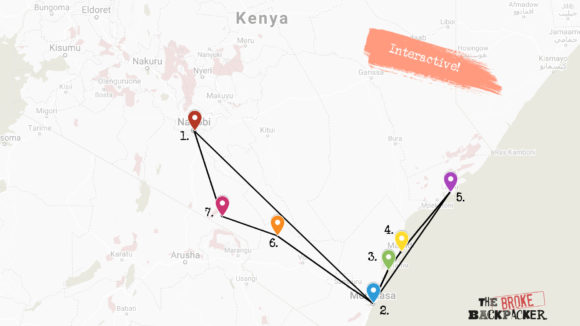
If you have up to a month in Kenya, you’re in for a real trip!
Following the above 10-day itinerary, you start moving further east to Mombasa. It’s the second-largest city in Kenya, and worth spending a couple of days in to check out its historical sites. Make sure you see Fort Jesus, Mandhry Mosque and the Spice Market.
From Mombasa, you can travel north along the coast to some incredibly dreamy destinations. Depending on how fast you move, you can head all the way up to Lamu Island, stopping at Kilifi and Malindi on the way.
You should be warned, though, the Kenyan coastal towns are very enticing, and you’ll find most backpackers staying in the same spot for indefinite amounts of time — the place’s sticky!
On the way back to the start, take a detour to a lodge inside Tsavo West National Park. You can even combine a safari here with Amboseli National Park, and finish your trip with more animal sightings against the towering backdrop of the Kilimanjaro peak.
Backpacking Kenya Itinerary 6 Weeks
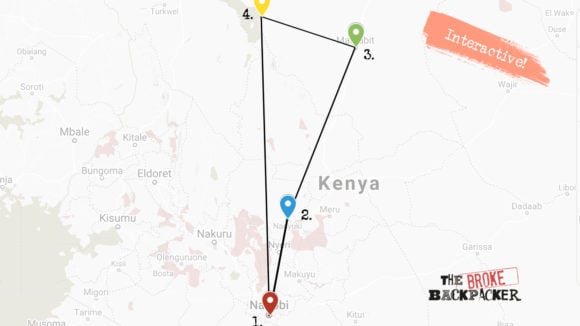
More than a month? What more could possibly be left to see in Kenya? Well… the entire northern half of the country! Travelers usually ignore this region completely, but for intrepid backpackers with the time, it can be the country’s ultimate adventure.
Following the one-month itinerary above, your next destination is Mount Kenya — and if you’re keen, you can spend almost a week trekking to the summit. This is one of the best spots in Africa for hiking, but you’ll want to make sure that you do this with a guide and porters.
After the summit experience, continue north by bus through Isiolo and all the way to Marsabit. From here, it’s best to arrange a driver to take you west to Lake Turkana in the wild northwest of Kenya.
You can venture further and try to reach Loiyangalani, an incredible lakeside settlement that0’s home to the Turkana and Samburu people. Take at least a couple of days to enjoy the lake and cultural experience in town.
After that, it’s back to Nairobi.
With the exception of Mount Kenya, northern Kenya is by far the least visited area of the country. You won’t find a lot of infrastructure here, especially when you compare it to the south. However, if you’re after a wild and adventurous journey, this is what you need in your Kenya itinerary.
Want to save money on accommodation?

We got you. For reals.
Places to Visit in Kenya
Kenya is blessed with some incredibly beautiful landscapes, whether that’s the coast, the savannah, or Mount Kenya. And most of the top places to visit in Kenya are relatively near these locations, so it’s truly a nature lovers dream.
The southern half and the coast have been enjoyed by generations of travelers, so they’re a bit easier to navigate. Northern Kenya requires a bit more of a sense of adventure, but if you’re in for the ride… go for it!
Backpacking Nairobi
Nairobi might not have the best reputation, but it’s by far East Africa’s most cosmopolitan city. It is often nicknamed “Nai-robbery” by backpackers, but don’t let that put you away. As long as you protect your belongings and don’t carry any valuables around, you can the city’s beating heart and get a real feel for the country’s promising future.
It has a number of great central markets where you can pick up arts, crafts, and souvenirs from all around the country. You can pick up some Maasai jewelry, wood carvings, and paintings on your way back home.
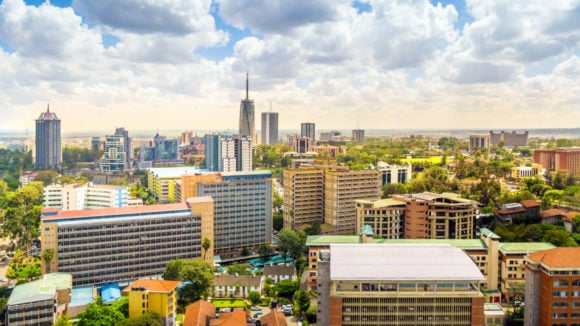
You can also head out on a safari within just kilometers of the city center. Nairobi National Park is something of an anomaly as you can literally spot giraffes and elephants against the backdrop of the city’s skyscrapers. It’s relatively small, so you can easily arrange a half or full-day trip.
Here are some of the best things to do in Nairobi:
- Maasai Market: an open-air marketplace in the middle of Nairobi where you can pick up souvenirs and crafts.
- Kenya Museum Society: A museum with exhibitions on East African traditions and history.
- Nairobi National Park: Head out on a safari just a short drive outside of the city. It’s one of the most accessible safari destinations in the world, and one of the only national parks that borders a capital city.
- Karen Blixen Museum: You can tour the 1920s farmhouse where Blixen lived and wrote her famous memoir, Out of Africa.
Backpacking Maasai Mara National Reserve
Arguably the most famous safari park in the world, the Maasai Mara is an unmissable stop on any trip to Kenya. The reserve is contiguous with the Serengeti National Park across the border in Tanzania, and it’s the best place in East Africa to spot the Big Five.
It’s also the world-famous setting of the Great Migration, one of nature’s biggest spectacles — over 2 million animals travel from Serengeti to Maasai Mara, from July to September.
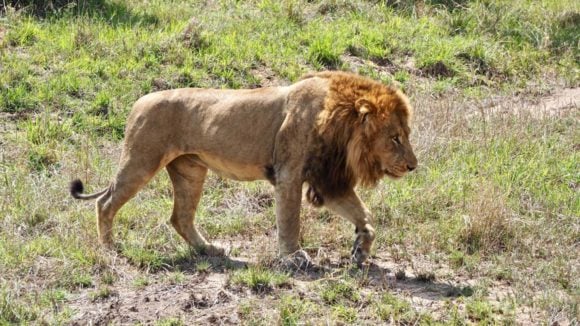
The reserve spans an area of around 1,500 square kilometers and is characterized by open grasslands dotted with acacia trees and small hills. Sunrise and sunset missions are the real highlights because that’s when animals are most active and the lighting is killer for photos.
Most people visit the Mara on a safari package which includes accommodation, meals, and game drives — designed to take you close to the wildlife-rich spots. You’ve got packages with lodging inside the park included.
Backpacking Naivasha
Lake Naivasha is one of Kenya’s real highlights of the Great Rift Valley. It’s a shiny blue lake sitting at an elevation of just over almost 2,000 meters. It’s not far from Hell’s Gate National Park, so you can easily visit both in a matter of days.
The lake is rich in wildlife and there is a large hippo population living here. The surrounding forests are also home to buffalo, giraffe, monkeys, and a wide variety of birds.
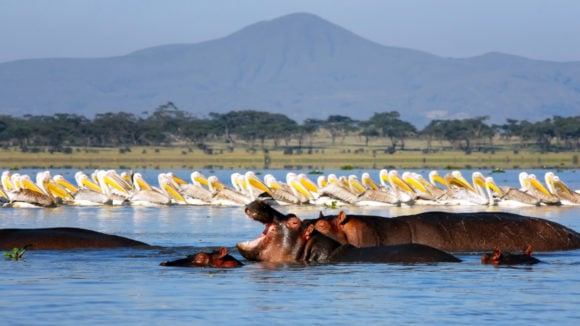
Lake Naivasha is the perfect place to relax and get away from the chaotic hustle of Nairobi, which is just 100km away. The town itself is a very typical Kenyan urban setting with not a whole lot to hold your interest. It’s still where you’ll find transportation to Nairobi and other destinations.
Most of the budget accommodation around the lake are also based in Naivasha town, but some can also be found further around in Karagita.
Backpacking Hell’s Gate National Park
Don’t be put off by the slightly daunting name, because Hell’s Gate is a real treat to explore. The national park is just three hours northwest of Nairobi and slightly south of Lake Naivasha.
It’s characterized by volcanic rock formations, deep valleys, and high escarpments that are enough to get any outdoorsy person excited. For many, it seems to fit the bill as the real-life inspiration for The Lion King!
Amidst the incredible natural beauty, you can spot wildebeest, buffalo, and lions within the 68-square-kilometer area. It’s become increasingly popular among backpackers because it’s much more affordable than the Mara — plus, you can self-tour the park on foot or two wheels.
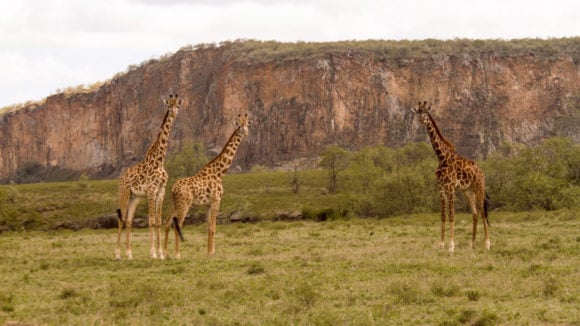
The easiest way of getting there is taking a minibus (or matatu) from Naivasha to the park’s entrance (Elsa Gate). And the daily park fee is only $30! An absolute steal compared to other parks in East Africa.
You’ll find plenty of bicycles to rent, but don’t expect much in terms of quality. Be sure that you at least have working brakes and you should be fine! Adventure , remember?
If you’ve packed a tent, you can also camp inside the national park at a few designated sites. This is, of course, the best way to experience it and allows you to see it once all the day-trippers have gone home.
Backpacking Mombasa
Mombasa is the main hub of Kenya’s Indian Ocean coast, and it’s both rich in history and culture. It’s a huge bustling city and a major shipping port, but you can easily find the city’s charm amongst its historical sites. The Old Town area is where you’ll probably spend most of your time.
Kenya’s oldest city has a long history and a fascinating culture — an intoxicating blend of Arabia, India, and Africa. You’ll feel almost in a completely different country here! And it’s only really an introduction to the rest of the coast.
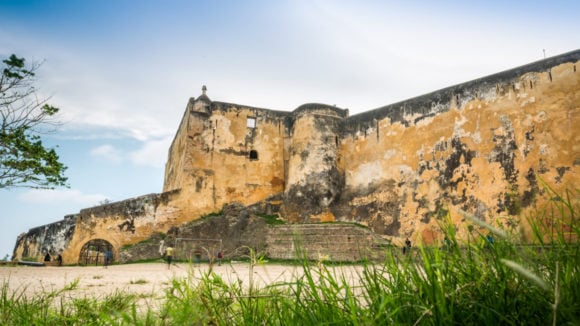
It’s likely that you have to return here after traveling more of the coastline since it’s well connected to Nairobi by both train and bus.
Here are some of my favorite things to do in Mombasa:
- Fort Jesus: This seaside fortress is a UNESCO World Heritage Site and Mombasa’s crown jewel. It was built by the Portuguese in 1593 and has stood the test of time as traders and colonizers have come and gone.
- Old Harbour: This is a disused harbor but the old dhow boats that are still docked here make for a picturesque image.
- Basheikh Mosque: The oldest mosque in the Old Town, it was built in the 13th century.
- Mandhry Mosque: A beautiful 16th-century mosque in Old Town.
- Spice Market: An aromatic and colorful experience in Old Town, on Nehru Road.
Backpacking Malindi
Malindi is the second largest coastal town in Kenya and it sits just 120km north of Mombasa. It’s welcomed foreigners since Vasco da Gama landed there in 1498, and has since become a popular getaway spot for travelers in Kenya.
It’s a bustling town and is not as laidback or charming as Kilifi or Watamu. Still, it makes for a great place to explore some sights and can be used as a transport hub for getting to more secluded spots on the coast.
The old town is an interesting place to wander and you can easily explore some of its history with its prominent Vasco da Gama pillar near the pier. However, its most enticing attraction is definitely the white sand and coconut palms on the water’s edge.
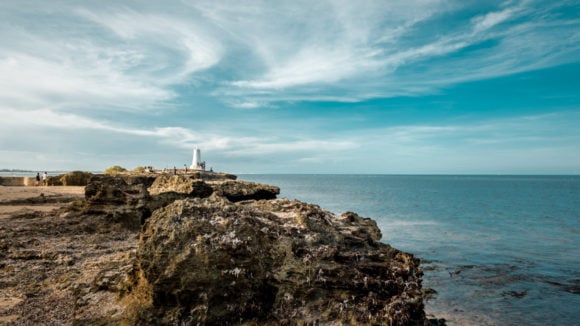
Once you lay your towel down there, you may never want to move. Off the coast, the Malindi Marine National Park has incredibly crystal-clear blue water and is perfect for snorkelling and cooling off after baking in the sun.
There has been considerable resort construction along the coast in Malindi, but you can still find some relatively cheap guesthouses to stay at. If you want to escape the big town, most backpackers tend just head slightly south to Watamu, which has incredible coral reefs to explore.
Backpacking Lamu Island
Off the northern coast of Kenya is the Lamu Island archipelago. The main island, Lamu, is one of the most incredibly dream-like and picturesque spots in the country. It’s basically Kenya’s version of Zanzibar, except a lot quieter and maybe a bit more charming.
The little island is just 10km long but it is one of the culturally richest places in the whole of Kenya. Lamu’s Old Town is a UNESCO World Heritage Site, thanks to its stunning traditional Swahili architecture.
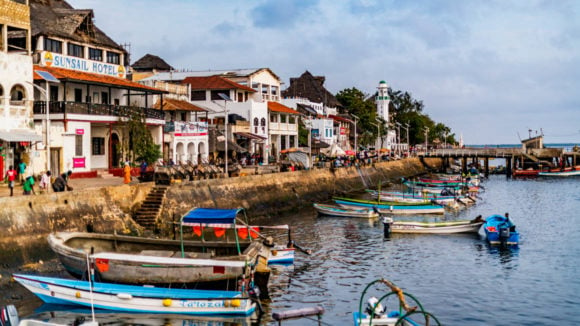
There are no vehicles on the entire island, so you’ll be getting lost in the maze of streets with only locals and a few donkeys. The island is ringed by incredible sandbanks and floating dhow boats.
You can spend a few days by the beach, but if you’re feeling restless, take a boat to Shela Village or Manda Island which are even more secluded.
If you’re able to, time your visit with a festival. The Lamu Cultural Festival happens every August and the Maulidi festival celebrates the prophet, Mohammed, during the third month of the Muslim calendar.
To reach Lamu, you can either fly straight there — there are regular flights from Mombasa or Malindi which are relatively affordable — or take a bus from Mombasa to Mokowe, and from there a 25-minute ferry ride.
Backpacking Amboseli National Park
If you’re in luck and Kili’s lofty peak isn’t shrouded in cloud, Amboseli is often considered one of the most picturesque national parks in all of Africa. The continent’s highest mountain, Kilimanjaro, stands across the border in Tanzania but looms high over the park for an incredible safari backdrop.
The park is known primarily for its herds of elephants, but it’s also home to cheetahs, wildebeests, giraffes, lions, and zebras. You can also spot over 370 species of birds in the park, making it a prime spot for bird watchers.
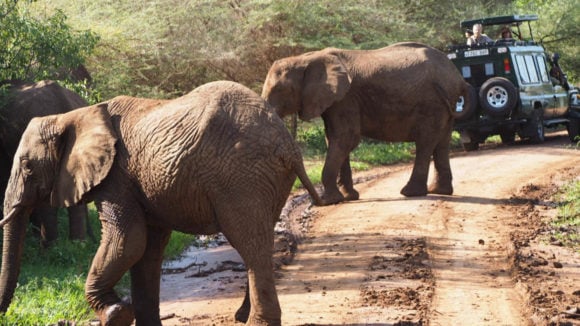
The park is not as big as the Maasai Mara, so a couple of days is usually enough to cover most of it. And just like the Mara, it’s best seen on an organized tour or safari that you can book virtually anywhere.
You’ll be close to Tsavo West National Park, which is just two hours away, so you can even combine the two for something a little different.
Backpacking Mount Kenya National Park
Mount Kenya is Africa’s second-highest peak, sitting at over 5000m. This rugged, lofty extinct volcano sits in central Kenya, almost directly north of Nairobi, and the peaks are covered in snow and glaciers year-round.
It actually has three distinct high points. The highest two are technical climbs and are reserved for mountaineers with proper knowledge and gear. The last one is Point Lenana at 4985m, which you can summit and come back down in about five days’ time.
In theory, anyone who is fit and able can climb up to Point Lenana, but around a quarter of trekkers fail mostly due to the sudden change in altitude. The weather conditions on the mountain are like nothing else in the country, so it’ll require some preparation. Get a team of guides and porters, and you’ll have one of the most thrilling experiences of your life.
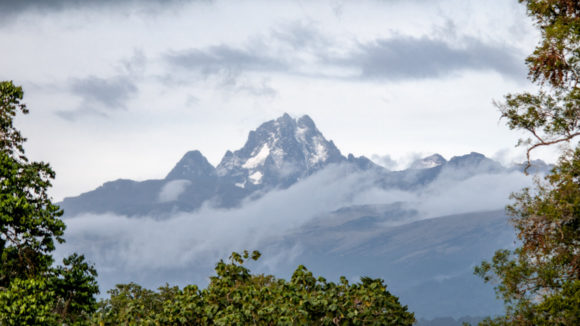
Take your time and research into the tour operators before signing up and handing over any cash. You’ll need experienced guides who know the mountain, camping, and cooking equipment.
While a full summit attempt is an incredible adventure to be had, you can also opt for shorter one or two-day hikes in the lower slopes. You’ll get to take in the beauty of the landscape without risking altitude sickness.
Nanyuki is the closest town to the mountain and has some good accommodation options.
Backpacking Loiyangalani
Looking for a place none of your friends ever heard of? Head to Loiyangalani! It’s unlikely for this town to come up in most backpacking Kenya guides, but to exclude it would be a real shame.
Loiyangalani is an incredibly fascinating place, and it should be your main destination if you’re heading north. It lies on the southeast coast of Lake Turkana in northwest Kenya, and you can reach it via a bone shattering bumpy road from Marsabit.
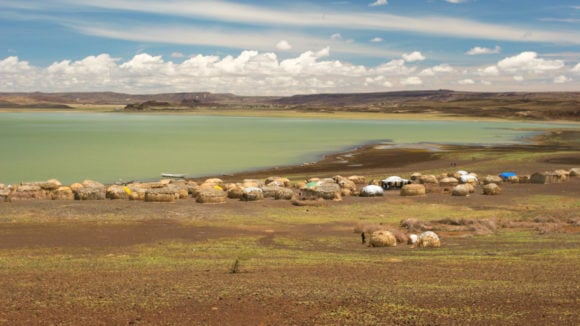
The town is a sort-of crossroads and home to some of Kenya’s most interesting tribes, the Turkana and Samburu. Although there’s not a whole list of attractions in town, the joy is in the journey of getting there and simply spending time with the local people.
The landscape is quite desolate and the harsh climate is a testament to the people who have called the area home for centuries. There is a local Desert Museum in town that is worth stopping by, but don’t think too much about swimming in the lake as it’s croc infested!
Getting Off the Beaten Path in Kenya
Kenya has one of the oldest running tourism industries in Africa, but it’s still not too hard to get off the beaten path. Most people traveling here just head to the Mara and the coastal towns, with very few exploring elsewhere.
This means that if you prefer to travel without the crowds, you can easily have Kenya’s landscape and culture to yourself.
Northern Kenya is by far the least visited area, and you’ll likely not encounter another foreigner here for days. This is certainly Kenya’s biggest adventure! You’ve got incredible cultural experiences and some crazy wildlife sightings waiting for ‘ya.
However, if you’re running low on time, you can try avoiding the crowds of safari jeeps and high-end resorts by opting for lesser-known parks and towns.
You can head to Tsavo West National Park and Tsavo East National Park, which are both between Nairobi and Mombasa and home to the Big Five. On the coast, try Tiwi Beach (south of Mombasa) or Kilifi to the north.
They might not boast recognizable names, but you can easily enjoy the highlights of Kenya without the crowds at these spots.

We’ve tested countless backpacks over the years, but there’s one that has always been the best and remains the best buy for adventurers: the broke backpacker-approved Osprey Aether and Ariel series.
Want more deetz on why these packs are so damn perfect? Then read our comprehensive review for the inside scoop!
Top Things to Do in Kenya
Kenya packs a bunch of exciting activities for backpackers! To give you a little inspiration for the trip, I’ve put together a list of the ultimate things to do in Kenya:
1. See the Big Five on a Safari
Whether you decide to plan your own African safari on a budget or splash out on one of those more typical bougie tourist experiences complete with bucket hats and binoculars – a safari is easily the number one thing to do in Kenya. This is one of the best places in Africa to spot the Big Five, and with the number of national parks available here, you can easily hop around for weeks at a time.
Elephants, lions, leopards, rhinos, and buffalos — this is your chance to see them all. Maasai Mara National Reserve is the most popular and likely place to spot them all on the same trip.
2. Witness the Great Migration
Hold on tight, because you’re in for one of the world’s greatest spectacles. The annual wildebeest migration in Kenya is a once-in-a-lifetime experience and the reason most people schedule their trip between July-September.
The migration is the largest mammal migration in the world and is one of the most breathtaking sights you’ll ever see. Two million wildebeests, zebras, and antelopes migrate from Serengeti National Park in northern Tanzania to Kenya’s Maasai Mara National Park.
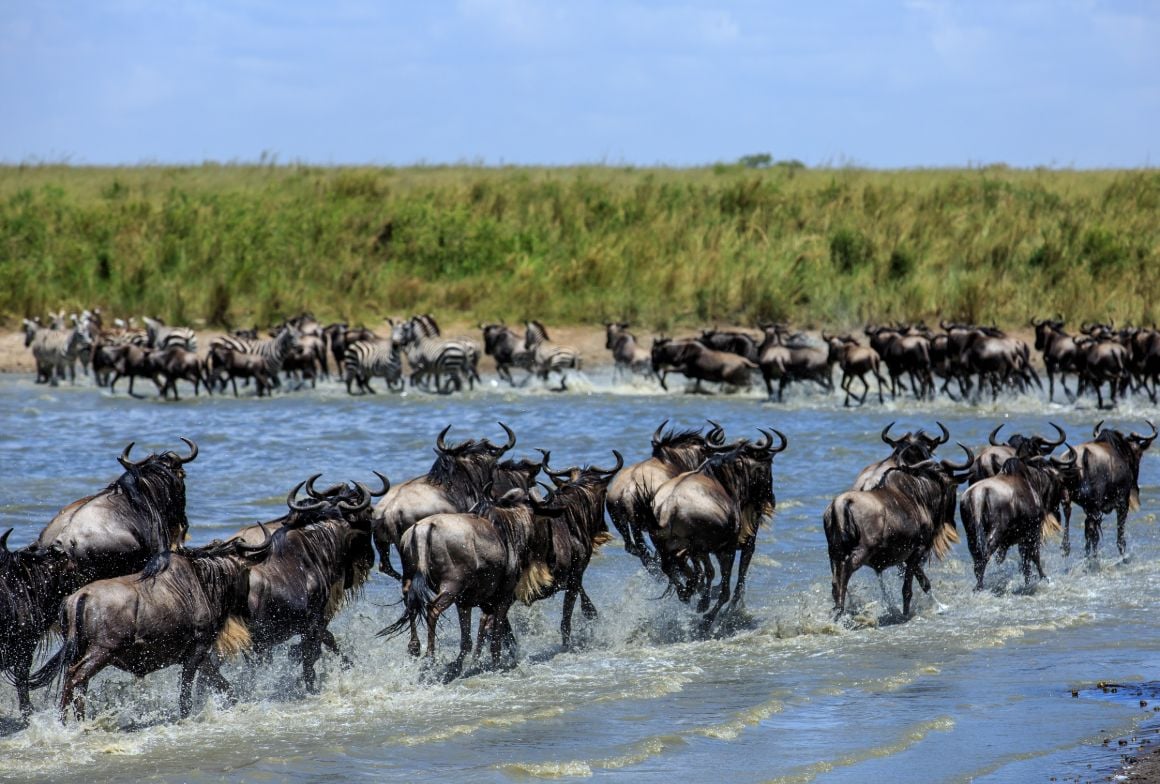
3. Climb Mount Kenya
If you’re an outdoor enthusiast looking for the ultimate bucket list experience, climbing Africa’s second-highest mountain is one of the best things you can do.
The two highest points of the peak are technical climbs, but Point Lenana is achievable on around a 5-day trek. It stands high up at almost 5000m!
If you don’t want to attempt a summit trek, you’ve also got shorter options for 1 or 2-day hikes inside the national park.
4. Relax on the Beach
Kenya’s Indian Ocean coastline is a true paradise. Adorned with palm trees, clear water, and white sandy beaches, the coastal towns in Kenya are an absolute delight.
This is the mecca of chill in Kenya. Come here if you’re looking to rest and relax — there’s plenty of opportunities to snorkel and explore the underwater world, too.
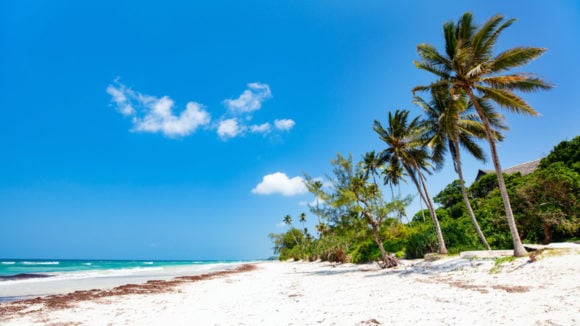
5. Explore the Old Town of Lamu
Lamu’s Old Town is a UNESCO World Heritage Site and an incredible place to escape for a while. The small Swahili port town on the island of Lamu has an incredible blend of unique architecture and dhow boats floating in the water that reflect its Portuguese, Arabic and Indian influences.
Wander the skinny streets to admire the carefully preserved heritage and fascinating history of Kenya’s coast.
6. Visit a Maasai Village
The Maasai tribe is one of the most fascinating in the world. They inhabit the southern part of Kenya, around the Maasai Mara and Amboseli National Parks.
They have been welcoming foreigners to their land for many years and villages often allow short visits by people wanting to have a brief glimpse into their traditional way of life.
This is something you don’t wanna miss!
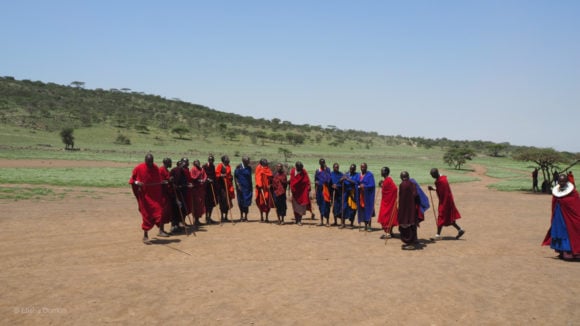
7. Eat Nyama Choma
If you a real foodie, you have to try nyama choma, Kenya’s beloved national dish. And what is it, you may ask? Barbecued goat meat! They serve it on every possible occasion in Kenya.
You can also find it on most menus in restaurants. If you want to go full traditional, pair it with a side of ugali (maize) and eat it with your hands. Make your momma proud.
8. Cycle through Hell’s Gate
One of the most unique African safaris you can do is a cycle tour of Hell’s Gate National Park. The park is part of the Great Rift Valley and is characterized by a dramatic volcanic landscape.
There’s a range of different activities in the park, but one of the best things you can do is to grab a bike and take a self-cycle tour. The trails are well defined, and you can spot zebras, wildebeest, and even lions as you ride.

Wanna know how to pack like a pro? Well for a start you need the right gear….
These are packing cubes for the globetrotters and compression sacks for the real adventurers – these babies are a traveller’s best kept secret. They organise yo’ packing and minimise volume too so you can pack MORE.
Or, y’know… you can stick to just chucking it all in your backpack…
Backpacker Accommodation in Kenya
You’ll find accommodation options in Kenya for every end of the spectrum, and while the safaris might take a toll on your wallet, you can still practice the art of budget travel !
Despite having a longstanding history of tourism, Kenya doesn’t really have a solid hostel network. But that doesn’t mean that it’s expensive; you can still find plenty of affordable guesthouses in towns around the country.
As a country that prides itself on its protection of wildlife and the environment, there are many great and affordable eco-lodg e in Kenya .
It’s not uncommon to find private rooms in basic guesthouses for the price of a dorm bed in other countries, but you’ve got other options to save up.
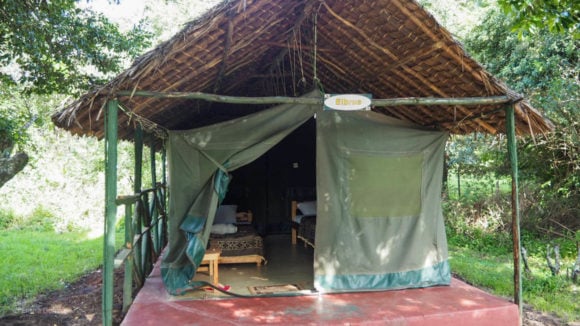
If you really want to travel Kenya on a shoestring, you can bring a tent and stay in campgrounds around the country — or wherever you feel like calling home, as long as it’s not a massive lion’s home already.
You can also try Couchsurfing or volunteering to save money, as you’ll often get a much more real experience, and accommodation included in the package. Try checking Workaway, for example!
The Best Places to Stay in Kenya
Kenya backpacking costs.
East Africa is generally a pretty affordable region to travel to, and it’s been on the Africa backpacker circuit for many years now. The cost of living in Kenya is pretty low, so accommodation, transport, and food won’t really break the bank.
In general, a safari will be the most expensive thing on your Kenya itinerary. These are expensive endeavors with exorbitant national park fees, but since most of it goes back to the conservation efforts, it ain’t all that bad in the end.
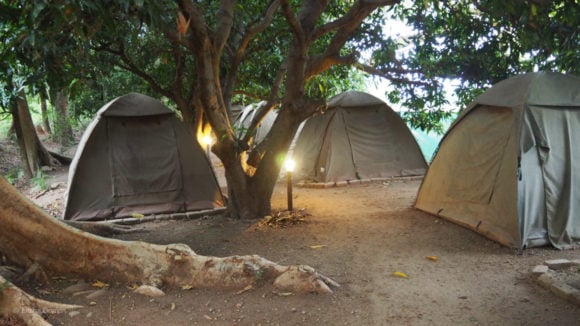
Still, a safari or climb up Mount Kenya will easily blow your daily budget out of the water and there’s not a whole lot you can do about it.
A realistic daily budget for Kenya is around $30-50 per day, and this includes a guesthouse room or dorm bed, daily meals, groceries, transport, and maybe a beer or two.
You can push it even lower if you eat 100% local, stick to the crowded minibus, and camp. Or Couchsurf and make new friends! Best to try Couchsurfing once Covid has subsided.
A Daily Budget in Kenya
Money in kenya.
The Kenyan shilling is the official currency. ATMs are scattered around the country, and you can usually always find one (even in small rural towns). Find out how much your money is worth today by using the up-to-date converter below.
It helps to travel with a wad of cash though, as almost all shops, restaurants, and ticket offices will only accept cash from foreigners.
You should also keep small bills on you as much as possible and only use larger bills for paying things like accommodation. Most small vendors don’t appreciate having to break large bills for a small purchase.
You can easily get cash out at ATMs with most foreign cards but in larger cities, you’ll also find currency exchange shops.
Large expenses like safaris and treks are usually quoted in USD or Euros, but most of the time you can still pay in shillings as long as you can get that amount out of an ATM — and it will probably take a few withdrawals!
Travel Tips – Kenya on a Budget
- Carry a water bottle: This is both a budget AND sustainable travel tip. You can save money on bottled water and prevent plastic from being thrown into a landfill by bringing along your own bottle to refill.
- Consider packing a tent: Camping is the best way to save extra money. There are plenty of places to camp in Kenya, with extraordinary landscapes to enjoy. To get some inspiration, check out our breakdown of the best tents to take backpacking .
- Cook your own food: If you’re really on a budget, then cooking your own meals is the way to go. Most Airbnb properties will have a proper kitchen, but you can also consider bringing a portable backpacking stove along if you plan on doing some camping/trekking.
- Volunteering: This is a popular thing to do in Kenya and is a great way to spend time in one place for a while. Usually, you can get free accommodation in exchange for work . Always do your research to ensure you are embarking on an ethical volunteering project.
- Do as locals do: The best way to stick to a tight budget anywhere you travel to is by sticking to what the locals do. Use the minibus to get around, pick unassuming local restaurants, and shop at local markets — haggle away, fellow backpacker !
Why Should You Travel to Kenya with a Water Bottle?
Plastic washes up on even the most pristine beaches… so do your part and keep the Big Blue beautiful!
You aren’t going to save the world overnight, but you might as well be part of the solution and not the problem. When you travel to some of the world’s most remote places, you come to realise the full extent of the plastic problem. And I hope you become more inspired to continue being a responsible traveller.
STOP USING SINGLE-USE PLASTIC! If you’d like some more tips on how to save the world .
Plus, now you won’t be buying overpriced bottles of water from the supermarkets either! Travel with a filtered water bottle instead and never waste a cent nor a turtle’s life again.

Drink water from ANYWHERE. The Grayl Geopress is the worlds leading filtered water bottle protecting you from all manner of waterborne nasties.
Single-use plastic bottles are a MASSIVE threat to marine life. Be a part of the solution and travel with a filter water bottle. Save money and the environment!
We’ve tested the Geopress rigorously from the icy heights of Pakistan to the tropical jungles of Bali, and can confirm: it’s the best water bottle you’ll ever buy!
Best Time to Travel to Kenya
Kenya’s weather patterns can be a little unpredictable. It’s a combination of hot, dry, and wet seasons, but you’re unlikely to ever feel really cold unless you hike up Mount Kenya.
In general, the weather is hot and dry from December-March, and hot and wet from April-June when the long, heavy rains arrive. July-October is warm and dry, and November to early December might bring along a few short rainfalls.
The coast is slightly different, and its weather is influenced by the Indian Ocean’s monsoon — this brings heavy rain from May to October.
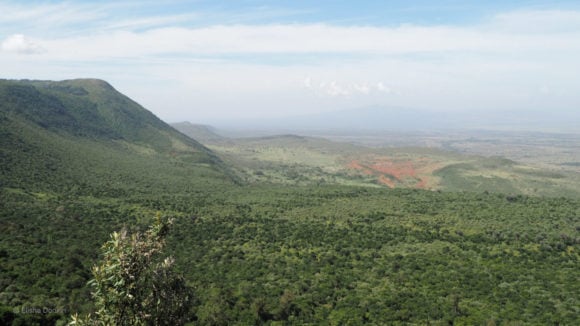
The first high season in the country runs from December to January because that’s when the weather is more pleasant across the country; the second coincides with the Great Migration (July-September), which is peak animal-sighting season.
Don’t let the wet seasons in Kenya put your travels on hold, though, as the rains tend to come for only brief periods of the day. You’ll also have fewer crowds in the parks and the landscape will be glowing green!
Festivals in Kenya
Kenya has surprisingly few festivals that are worth planning your trip around, but there are still a few that might interest you:
Lamu Cultural Festival: One of the best times to be in Lamu is during the cultural festival where the beauty and culture of the Swahili town are on full display. It happens every November for around 3 days and includes sailing, donkey races, and Swahili delicacies.
Maulidi: This one is also held in Lamu, during the third month of the Muslim calendar. The festival has been going since the 19th century and consists of traditional music, dance, art exhibitions, and dhow races.
Lake Turkana Festival: For a truly colorful and vibrant festival, this one is an incredible experience. The Lake Turkana Festival celebrates the Turkana tribe in Loiyangalani, on the coast of Lake Turkana. It runs every August for 3 days, showcasing traditional dresses, songs, and dances from 14 different tribes.
What to Pack for Kenya
If you’re wondering what to pack for your Kenya trip, here’s a list of my recommended essentials.

Travel Security Belt
This is a regular looking belt with a concealed pocket on the inside – you can hide up to twenty notes inside and wear it through airport scanners without it setting them off.

Microfiber Towel
Hostel towels are scummy and take forever to dry. Microfibre towels dry quickly, are compact, lightweight, and can be used as a blanket or yoga mat if need be.

Petzl Actik Core Headlamp
A decent head torch could save your life. If you want to explore caves, unlit temples, or simply find your way to the bathroom during a blackout, a headtorch is a must.

‘Monopoly Deal’
Forget about Poker! Monopoly Deal is the single best travel card game that we have ever played. Works with 2-5 players and guarantees happy days.
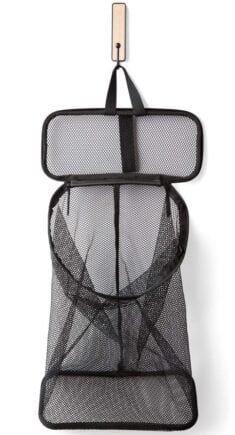
Hanging Laundry Bag
Trust us, this is an absolute game changer. Super compact, a hanging mesh laundry bag stops your dirty clothes from stinking, you don’t know how much you need one of these… so just get it, thank us later.
Staying Safe in Kenya
While overall Kenya is a pretty safe country to visit, you’ve likely heard of stories related to crime and terrorist attacks. To get the bad stuff out of the way, there is a bit of a crime issue in major cities like Nairobi and Mombasa.
Pickpocketing is likely the worst offense that happens to foreigners. In crowded places, keep all of your valuables hidden or held in your hand. And keep your bags with you at all times — this is safe travel 101 !
The other major issue concerning people is terrorism. There are foreign government travel warnings for much of the coastline of Kenya and towards the Somali border for this reason.
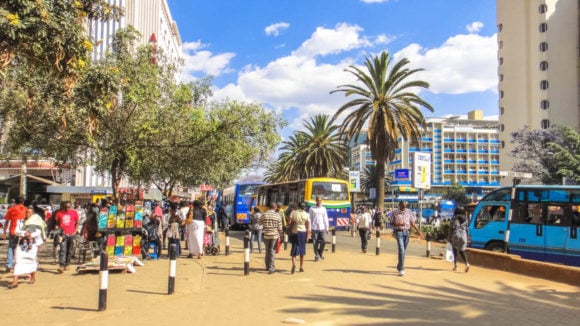
Attacks have happened in the past, with members of Al Shaabab entering Kenya from Somalia. The most well-known incident, and one of the worst, occurred in 2013 in Nairobi’s Westgate Shopping Mall.
You should not ignore these situations, because they’re very real. But you should also have in mind that not only are they not directed at tourists, but they’re also not frequent. The situation has been stable even on the coast for some time now.
As long as you use common sense and your special backpacker powers — we do have a reputation, don’t we? — you’ll do just fine. Carrying a money belt with you is a fine way of keeping your essentials protected at all times.
As a female solo traveler, I can tell you I’ve never had any bad experiences, and I’ve traveled to Kenya on three different occasions. I can certainly vouch for the fact that it’s a safe country for women and solo travelers too.
Sex, Drugs and Rock ‘n’ Roll in Kenya
Kenyans love to get it down on the weekends, and you’ll find bars and clubs in major towns and cities around the country. Nairobi has by far the best nightlife and there are a variety of places that are open until sunrise.
If you’re keen on a good drink and boogie over the weekend, definitely go for it. East African hip-hop and RnB is probably going to be the soundtrack.
Beer is the most popular drink, along with whiskey, vodka, and basically any other spirit you can think of. It’s relatively cheap too, which helps, but make sure you maintain that common sense we’ve just talked about.
Drinking a bit too much can make you silly (and vulnerable), you know that!
Weed/hash and khat (a herbal stimulant that is chewed) are the most common drugs you’ll come across in Kenya. It’s not uncommon for the youth to smoke or chew, especially in the coastal areas.
Hard drugs are also becoming a prevalent problem in Kenyan society, however, I didn’t come across anything during my time there.
Contraception is not as accessible and reliable as what you might be used to in your own country. And even though you’ll find condoms at most supermarkets and pharmacies, I wouldn’t rely on that. Come prepared!
Or don’t come at all… eheh. But seriously, stay safe.
Travel Insurance for Kenya
You never know what can happen on the road, and Kenya is unpredictable! Getting good backpacker insurance is a good way to cover your ass in case things go south.
I’ve been using World Nomads for some time now, and already made a few claims over the years. You can even buy or extend a policy mid-trip which really comes in handy.
ALWAYS sort out your backpacker insurance before your trip. There’s plenty to choose from in that department, but a good place to start is Safety Wing .
They offer month-to-month payments, no lock-in contracts, and require absolutely no itineraries: that’s the exact kind of insurance long-term travellers and digital nomads need.

SafetyWing is cheap, easy, and admin-free: just sign up lickety-split so you can get back to it!
Click the button below to learn more about SafetyWing’s setup or read our insider review for the full tasty scoop.
Getting into Kenya
Most people arrive in Kenya by air. The main airport is Jomo Kenyatta International Airport in Nairobi, which is around 30 minutes to one hour from the city center. You can also fly into Mombasa at Moi International Airport, but it’s not as commonly serviced internationally.
Crossing into Kenya overland is quite common for backpackers, particularly between the East African nations. The borders with Tanzania and Uganda are relatively easy to cross and can even be entered with an eVisa.
There are regular bus services from Tanzania to Kenya across five different border posts, although the Namanga crossing is the most common — it connects Arusha to Nairobi. But then you’ve also got Loitokitok…
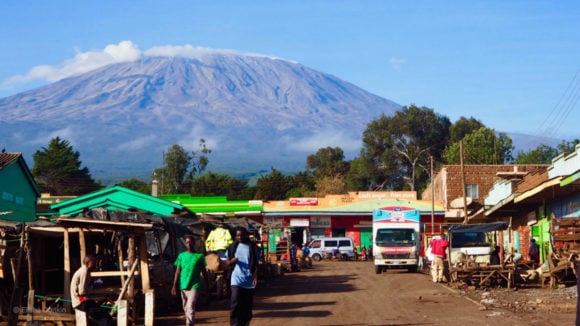
Between Uganda and Kenya, there are two border crossings open. The most common is Busia, which connects Kampala with Nairobi with regular bus services. With other borders, things get a bit trickier — there are no open crossings from Somalia to Kenya, for example.
The Ethiopian and South Sudanese borders are more precarious and entry requirements change all the time. However, you can still cross them with appropriate visas from an embassy, it’s just a long and arduous journey.
Entry Requirements for Kenya
Kenya’s visa policy makes it relatively easy for most travelers to get in. People from the US, UK, Canada, Australia, New Zealand, and EU nations require a visa, but it’s easy to get.
eVisas are the most convenient and you can apply for one online . They can take up to seven days to process and give you 90 days with a single entry. You can also get multiple entry visas, but the price is heftier!
If your plan includes other East African countries, you should absolutely consider an East African Tourist Visa. It allows you to roam freely between Kenya, Rwanda, and Uganda. And it runs for three months — you save money, and you save the hassle of getting individual visas.

Get 15% OFF when you book through our link — and support the site you love so dearly 😉
Booking.com is quickly becoming our go-to for accommodation. From cheap hostels to stylish homestays and nice hotels, they’ve got it all!
How to Get Around Kenya
Kenya is relatively easy to get around. You’ve got a wide range of transportation options depending on your budget and time constraints.
You can find domestic flights with Kenya Airways between Nairobi and regional cities. Even into national parks! It’s best to book way in advance, especially during the high season.
Trains are not so common in East Africa, but the new high-speed Nairobi to Mombasa rail service is certainly something you should consider. It cuts the journey time from a full day on a bus to just 4.5 hours by train. A lower-class ticket is around $9.
By far the most common way of getting around Kenya is by bus. There is an endless network of buses and minibuses (called matatus), which service almost every town and city in the country.
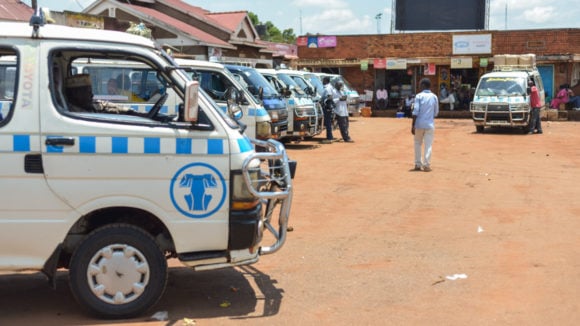
Buses are all run by private companies, so comfort, quality, and speed vary wildly. Still, they’re the most convenient and cheapest way to move around — unless, of course, you’re a hitchhiking ninja . A bus ticket from Nairobi to Mombasa can cost around $6.
For all forms of transport, it’s best to book directly at stations or ticket offices. You’ll find bus ticket counters jammed up at major stops, but you can also pay directly to the driver.
Traveling by Motorbike in Kenya
Many travelers opt to bring their own motorcycle to Kenya, often as part of a bigger African odyssey. Your bike needs registration papers, insurance, and a valid driver’s licence. You also need a Carnet de passage en douane , which is basically a passport for your vehicle to avoid paying import tax.
It’s common for people to ship their bikes in and out of Kenya from Mombasa to other destinations, although this is obviously a pricey endeavour.
Having a motorbike allows you to explore the country at your own pace, and it can also enable you to see places that would otherwise be unreachable!
Be aware though that Kenyans are notoriously crazy drivers. If you’re riding a bike, you’re certainly the weaker element. Be aware of trucks and buses in particular, as they don’t tend to care much about other vehicles.
Hitchhiking in Kenya
This is a common practice in rural parts of Kenya, and locals will certainly understand what you’re doing. Flag them down on the side of the road, and good luck…
Hitchhiking is one of the main of getting around parts of Kenya where public transport doesn’t reach. And it’s one hell of an experience! Be wary though, as it’s not necessarily the safest option as a foreigner — do it in pairs if you can.
Working and Staying Connected in Kenya
While most people don’t think of Kenya as a remote-working hub, it’s certainly possible to work and stay connected in Kenya. Nairobi is by far the best option, as there is a growing start-up and digital nomad community.
Nairobi is also a popular place to live for expats in general, with many aid agencies and international companies basing there.
The city has over 30 co-working spaces with Nairobi Garage in Westlands being the first and most popular. You’ve also got Ikigai with four different branches across the city.
Wi-Fi at cafes is not usually reliable, but getting a SIM card in Kenya is pretty cheap (and easy). Safaricom is the most reliable 4G provider, and you can always top it with more data. Pick one up at the airport or at one of their shops in Nairobi.

A new country, a new contract, a new piece of plastic – booooring. Instead, buy an eSIM!
An eSIM works just like an app: you buy it, you download it, and BOOM! You’re connected the minute you land. It’s that easy.
Is your phone eSIM ready? Read about how e-Sims work or click below to see one of the top eSIM providers on the market and ditch the plastic .
Teaching English in Kenya
Teaching English is probably one of the most popular options when it comes to volunteering in Kenya . Although many people in Kenya are relatively fluent, there is a constant demand for help in schools, especially in rural areas.
Most English teaching gigs are volunteer-based, with accommodation and food in exchange. However, with a course certificate from MyTEFL and a Bachelor’s Degree, you can often find paid work teaching in private schools.
Volunteer in Kenya
Volunteering overseas is a great way to experience a culture whilst doing some good in the world. There are lots of different volunteer projects in Kenya which you can join ranging from teaching, to animal care, to agriculture to pretty much anything!
Kenya is a developing country where volunteers are always in high demand. Community development, social work, and teaching are all areas where backpackers can make a huge difference to small communities. You’ll also find opportunities to help out with eco-projects, like tree planting or agriculture. Most travelers only need a tourist e-visa to volunteer in Kenya, which you’ll need to have before arriving.
If you want to find volunteering opportunities in Kenya, then we recommend that you Signup for Worldpackers – a volunteer platform that connects local hosts directly with traveling volunteers. As a Broke Backpacker reader, you’ll also get a special discount of $10 when you sign up. Just use the discount code BROKEBACKPACKER and your membership is discounted from $49 a year to only $39.
Volunteer programs run through reputable work exchange programs like Worldpackers are usually very well-managed and reputable. However, whenever you are volunteering, do stay vigilant especially when working with animals or children.

Worldpackers: connecting travellers with meaningful travel experiences.
What to Eat in Kenya
Food in Kenya has a plethora of influences from early Arab settlers to Indian railway workers. And while it might not be anything extraordinary to write home about, you should still try it! I found it delicious, and there’s plenty of options for meat lovers and vegetarians alike.
Kenyan food is very carb and meat-heavy. The main staple is corn or maize, which is ground into coarse flour and then cooked into a thick paste/cake called ugali. This is then served as a side dish with a stew or sauteed spinach known as sukuma . For many backpackers, ugali is the one thing they have to learn to acquire a taste of in Kenya.
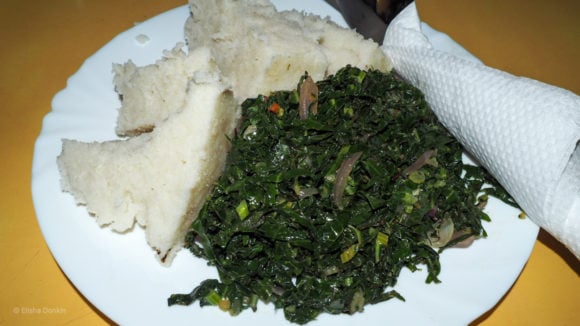
If you can’t get into the ugali, rice is the other main carb staple and can be served instead of ugali. With a bit of a South Asian twist, you’ll often find chapati or flatbread served with the stew, too.
Kenyans consider meat a staple to their diet, which is bad news for vegetarians. Nyama choma (aka grilled goat) is the national dish and is often on most menus, but you’ll also find sauteed spinach dishes, sukuma, and plenty of other legumes as well.
The Best Food in Kenya
Here are some of the best foods that you should try in Kenya.
- Nyama choma: Grilled or barbequed meat, usually goat, served with relish and eaten with your hands.
- Ugali: Kenya’s staple food dish is made of coarse, white maize meal cooked into a spongey cake. It’s served with relish, spinach, and stew, and you eat it with your hands!
- Mandazi: A sweet or savoury deep-fried dough, similar to a doughnut. You usually eat it in the morning with chai.
- Chapati: Flatbread inspired from the Indian continent and served as a side dish to stews.
- Githeri: A hearty bean stew made with an assortment of beans in a tomato sauce. It can sometimes come with potatoes!
- Pilau: Another aromatic Middle Eastern-inspired dish in Kenya is pilau. This fragrant rice dish is usually made with beef or chicken.
Kenyan Culture
Kenya is far from a homogenous country in terms of ethnicity and culture. There are around 13 main ethnic groups and 27 additional groups scattered across the country.
There’s also a significant portion of Kenya that is of non-African descent, with large populations of Indian, Arab, and European immigrants living here.
This makes Kenya a fascinating cultural experience. And one that you can’t describe as one whole: from the Maasai villages in the south to the Turkana in the north, all the way through the Mijikenda tribe on the coast… you’ll witness a change in language, dress, and traditions as you move from one side of the country to the other.
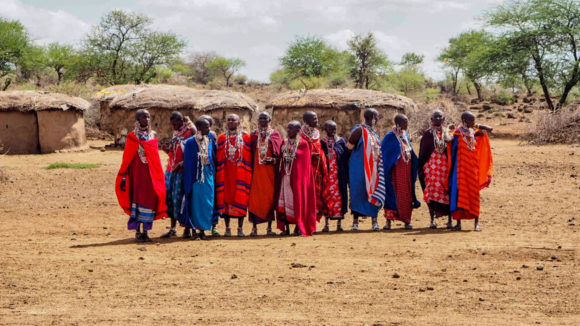
There is real distrust between some of the tribes in Kenya, too. It’s not uncommon for a Maasai to tell you to never trust a Kikuyu and vice versa. Many of these animosities date back generations and are more tongue in cheek these days.
In general, the different tribes live together in relative harmony, although in rural Kenya they still tend to stick to their traditional territory.
Kenyans are incredibly friendly, heart-warming, and kind people. You will usually always be met with a big smile and a friendly chat, or a helping hand. The Kenyan people hold a dear place in my heart and is the main reason that I return to the country again and again!
Speaking Swahili – Useful Travel Phrases
It is believed that over 50 languages are spoken in Kenya, belonging to the various tribal groups in the country. However, English and Swahili are the two official languages. Swahili was adopted as a common language and is taught in schools so that the entire country can understand one another.
However, English is slowly taking over that role and most young people prefer to speak English, especially in Nairobi. The youngsters usually know their English well, but the older generations are more into their tribal language and Swahili.
Many people are multilingual, so it’s unlikely that you run into a lot of communication barriers — although to me it just makes traveling more exciting!
Before you start your journey backpacking Kenya, be sure to learn a few useful phrases in Swahili:
Jambo – Hello
Habari gani – How are you
Nzuri – Fine
Kwa heri – Goodbye
Asante sana – Thank you very much
Unasema kiingereza – Do you speak English?
Sielewi – I don’t understand
Samahani – Excuse me
Books to Read About Kenya
- Out of Africa : By far one of the most famous books about Kenya. This is the memoir of Karen Blixen, who lived at the foot of the Ngong Hills and managed a coffee plantation from 1914 to 1931. The language can be a little hard to swallow, but it’s a testament to the time it was written.
- A Grain of Wheat : A fiction book set in the time of the Mau Mau rebellion in a small village. It’s written by Ngugi wa Thiong’o who was 25 when Kenya received independence and reflects the struggles of colonialism in his work.
- Dust : This book takes a more current look at Kenyan society. It starts with the violence that followed the 2007 presidential elections and questions the brutality in the society by going back to the time of independence. Shortlisted for the Folio Price in 2015!
- Unbowed: A Memoir : This tells the story of the incredible woman who led an environmental and social movement to save the Karura Forest in Kenya. She tells her story as she went from peasant to movement leader to Nobel laureate.
Final Advice Before Visiting Kenya
There are very few places in the world that can offer this much variety in landscapes, wildlife, culture, and natural beauty. Kenya is truly one of the most memorable places that I’ve ever traveled to, and I’m sure you’ll soon be on my side!
I hope this guide gave you the tools and motivation you needed to plan your Kenya trip. The country’s been welcoming tourists for quite some time, so you’re unlikely to run into any issues while navigating it.
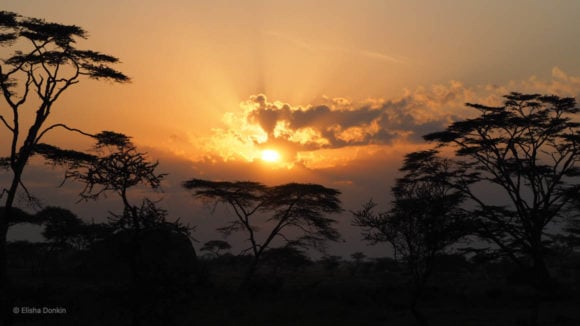
Still, you should always keep in mind that you’re a mzungo (a foreigner) in the country. Be respectful of the people, the wildlife and the environment. Take photos, but ask first. Leave your footprints, but no other trace behind.
Backpacking Kenya is a magical experience and one that I didn’t know I needed so deeply. Enjoy your time there, amigos!
Made it this far? You get 15% OFF to book a place to stay ! Offer valid exclusively for Broke Backpackers 😉

Elisha Donkin
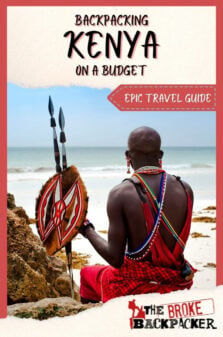
Share or save this post

Hi Christian, We have a newly built exclusive luxury camp in Taita hills, fronting a river with 4 waterfalls . This should be perfect for you and your friend as it is 20 minutes away from Tsavo east. You will also enjoy privacy as the property only takes 2 guests at a time. Karibu Kenya.
Hi Elisha – my friend and I want to go to Kenya this summer in late July. We’re both guys in our late 20s and we want to do a mix of safaris (wildebeest migration at the Mara then maybe one other park) and seeing some of the native tribes. I’ve been corresponding with one safari guide but their price for 4 nights in the Mara is around $3500 for travel, accommodations, food, park entry and drives. I’m also not sure who the clientele will be, but I’m worried that it could end up being a bunch of families with kids (not that I have anything against travelling families, just not the vibe we’re looking for). Can you recommend any tour providers or camps for us considering what we’re looking for? Thanks!
Hi Christian
Sorry but we don’t have any tips for tour providers. We do know that they can be very expensive and prices have reportedly spiked owing to a high, post COVID demand.
Best of luck.
Leave a Reply Cancel reply
Your email address will not be published. Required fields are marked *
Save my name, email, and website in this browser for the next time I comment.
Notify me of followup comments via e-mail.

A Magical Kenya Itinerary – Safaris, Cities & Beaches
Kenya is an incredible and diverse country, perfect for an introduction to African travel.
Kenya is one of those countries that really has it all – great safaris, excellent beaches, mountains, traditional culture and modern cities.
My ideal Kenya itinerary would involve some time on safari at the beginning of the trip, as well as time at the beach at the end of the trip. The options are endless, so here are a few ideas to get you started planning your own Kenya trip.
Please Note: Some of the links in this post are affiliate links, which will earn me a small commission at no extra cost to you. Affiliate sales help with the running costs of this site, so thank you for your support!
Table of Contents
A Magical Kenya Itinerary (Plus Things To See & Do)
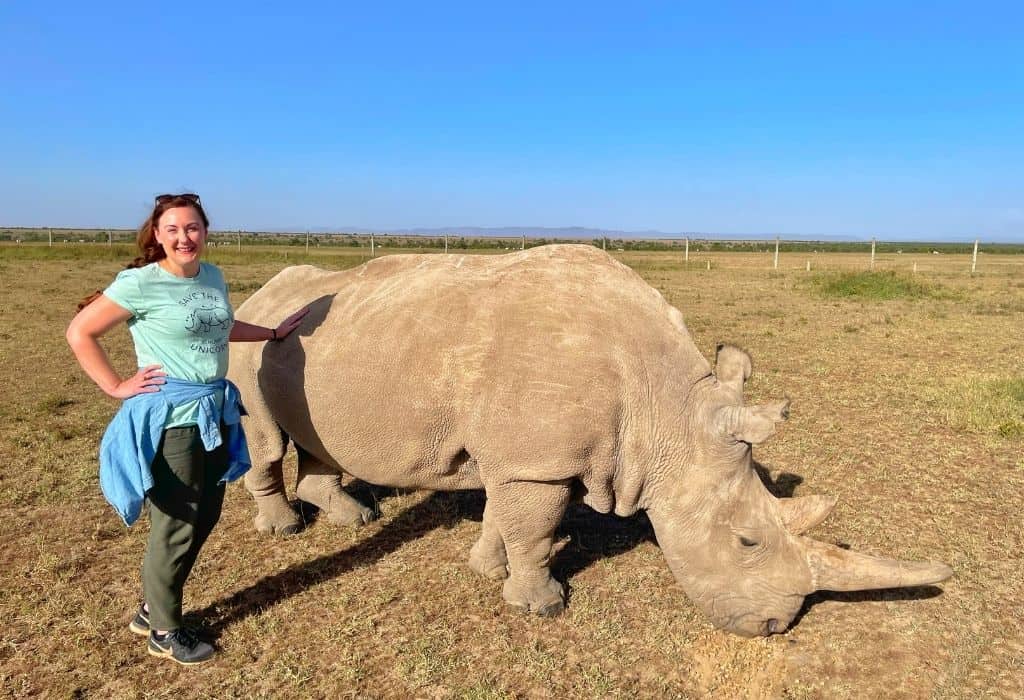
Here are a few ideas for what your itinerary could look like for 1, 2 and 3-week trips. I’ve written about all the destinations in more detail below so that you can build your own itinerary. You might want a more safari-focused Kenya itinerary, or you could do a little bit of safari and lots of beaches! The options are endless!
Kenya Itinerary – 1 Week
- Day 1 – 2: Nairobi
- Day 3 – 5: The Masai Mara
- Day 6 – 7: Diani Beach, Kilifi, Mombasa or Lamu
Kenya Itinerary – 2 Weeks ( Option A)
- Day 3 – 6: The Masai Mara
- Day 7 – 8: Amboseli National Park
- Day 9 – 10: Mombasa or Diani Beach
- Day 11 – 12: Kilifi
- Day 13 – 14: Lamu
Kenya Itinerary – 2 Weeks ( Option B)
This is the itinerary for my Rock My Kenya Adventure – check it out here.
- Day 1: Nairobi
- Day 2 – 5: Samburu National Reserve
- Day 6 – 7: Ol Pejeta
- Day 8: Lake Nakuru
- Day 9 – 11: Masai Mara
- Day 12 – 14: Lamu
Kenya Itinerary – 3 Weeks
- Day 12 – 13: Amboseli National Park
- Day 14 – 15: Tsavo National Park
- Day 16: Mombasa
- Day 17 – 18: Watamu or Malindi
- Day 19 – 21: Lamu Island
Other destinations you could add to your itinerary if you have more time include:
- Lake Turkana: 5 – 7 Days
- Mount Kenya National Park: 4 – 6 Days
- Lake Naivasha & Hell’s Gate National Park: 2 – 3 Days
Kenya Itinerary Map
Here’s a little visual guide to the places I mention above.
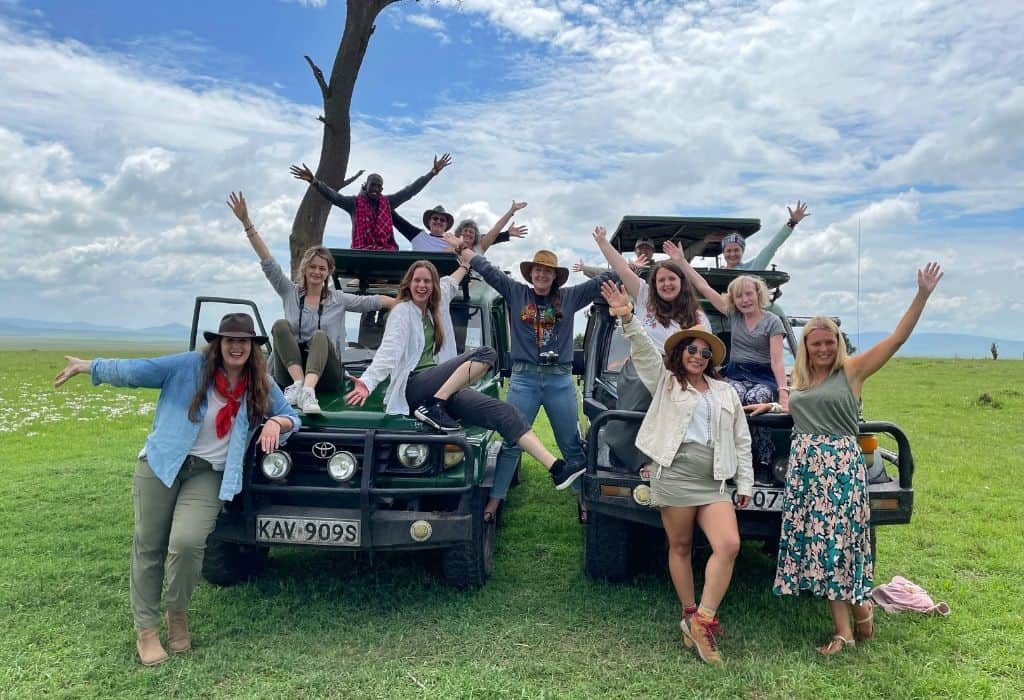
How to Get Around Kenya
One thing you need to consider when planning your Kenya itinerary is how you will get around.
Kenya is a relatively easy country to travel by public transport. There are good coaches between major cities, smaller minibuses known as matatus that go everywhere and even an excellent train network between Nairobi and Mombasa. There are also lots of taxis and in Nairobi, Uber is a popular way to get around.
However, if you are short on time, sometimes taking a Kenya group tour is a good option, saving you time (most importantly) and sometimes money, and you won’t waste precious time on your Kenya holiday trying to find groups to join.
I would try to avoid travelling by matatu for long journeys as they are not known for being the safest or most comfortable method of transport.
If you are heading up towards Lake Turkana, check the safety situation on the ground as you may need an armed escort to travel and between Malindi and Lamu, it is advisable to fly.
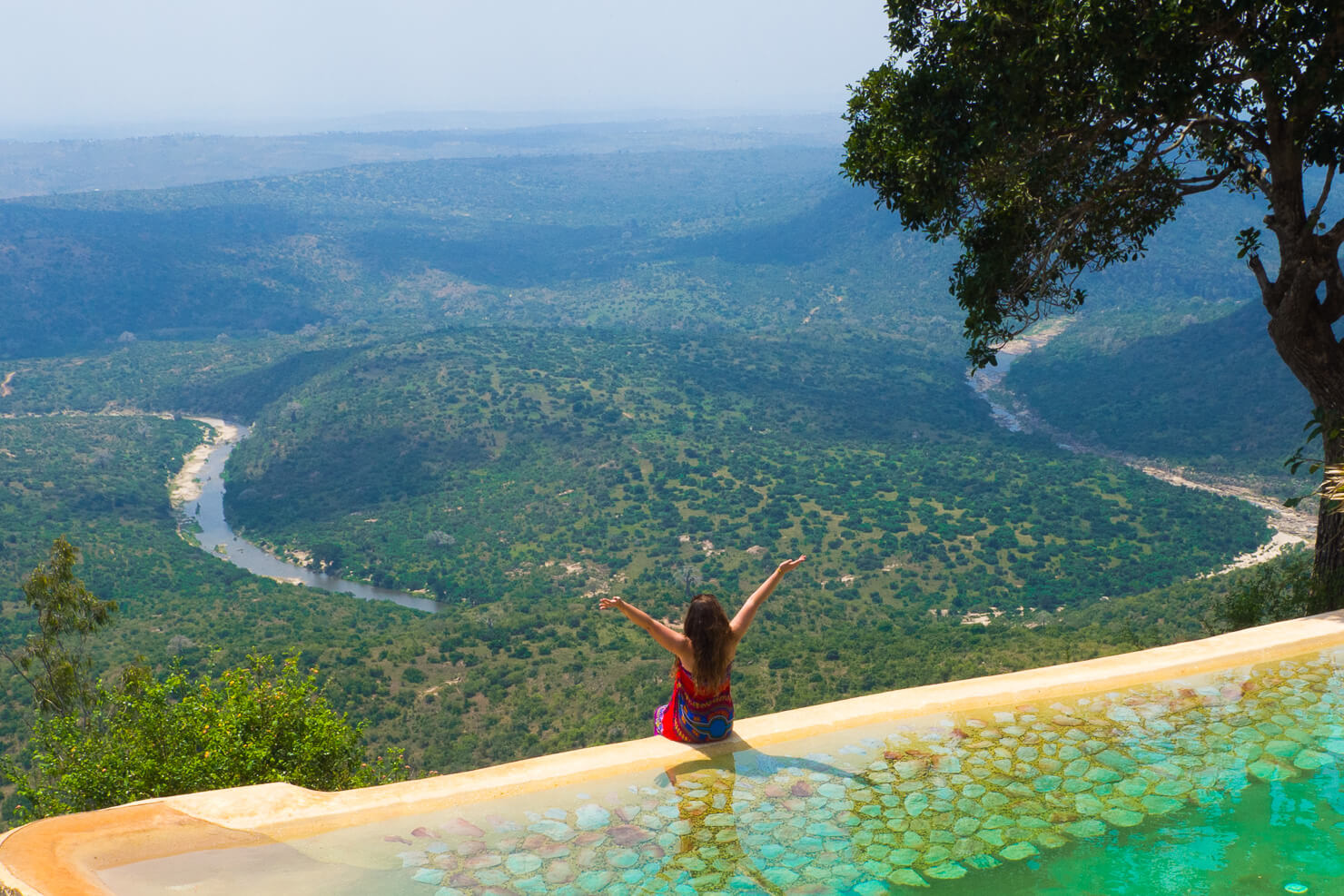
When To Visit Kenya
Kenya is best visited during the dry season from June to October. I would avoid the rainy season from mid-March to May. January and February can also be quite nice, although pretty hot in places.
If you’re hoping to see the Great Migration in the Masai Mara, July to September/October is usually the best time although sometimes the herds have arrived earlier, in June.
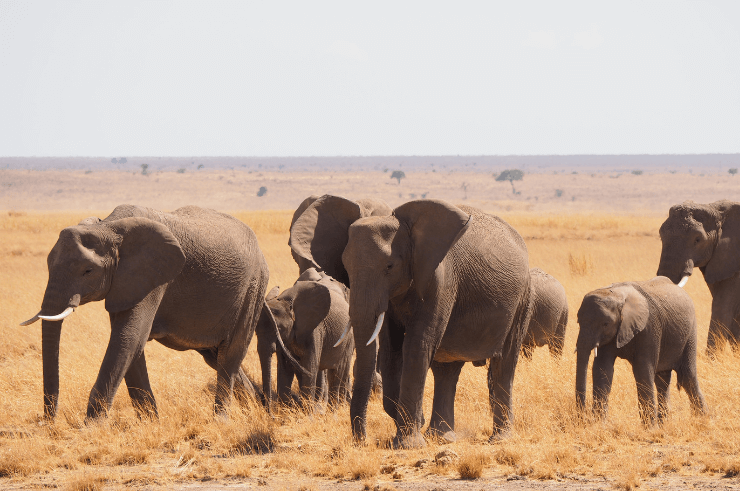
How Long To Spend in Kenya
On this Kenya itinerary, you’ll find a ton of different places to visit, as well as lots of things to do. Kenya has it all!
Kenya is a big country and it would be impossible to see it all in a one or two-week trip. But, in a couple of weeks, you can definitely get a good feel for the country.
Under each location, I’ve suggested the minimum amount of time I recommend you spend there. The full itinerary below would take around a month, but if you’re on a shorter trip, you can just miss certain places out.
For instance, Kenya is very safari heavy, so you could easily just pick 1 or 2 Kenya safari destinations and then spend the rest of your time soaking up the atmosphere in Nairobi or on the coast, near Mombasa.
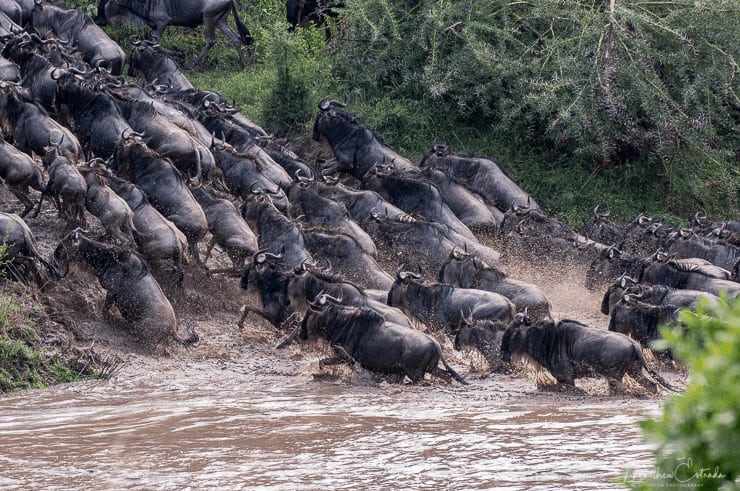
Combining Kenya & Tanzania
People often ask me which is better – Kenya or Tanzania ? They can easily be combined in one trip, but again, these countries are huge, so you won’t be able to see everything in 2 weeks, but you’ll still be able to have an incredible trip either way.
My Kenya & Tanzania Adventure tour takes in the major highlights of both countries – so definitely consider that if you want to maximise your time and let someone else (me) sort out the logistics for you!
For further ideas, check out my suggested Kenya & Tanzania itinerary and my Tanzania itinerary .
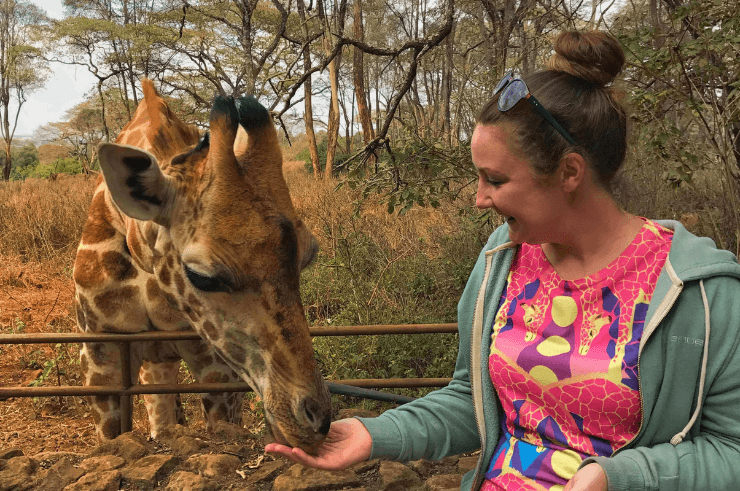
Detailed Kenya Itinerary
Nairobi may seem a bit intimidating for a first-timer to Africa, but it’s actually a great city. The first time I visited I wasn’t that impressed as it just seemed crowded, busy and congested.
But I’ve been back many times since then and now it feels like home. It’s still crowded and hectic, but it is also vibrant, exciting and full of adventure, I just didn’t see it the first time around.
Nairobi is the perfect place to begin or end your Kenya trip and you can either head straight out of Nairobi and come back later or spend a few days there first before you go on safari.
How Many Days to Spend in Nairobi
1 – 2 days. You could spend a night in Nairobi and then head straight out to other parts of the country, but there are lots of cool things to do in Nairobi too if you have time.
Things To Do in Nairobi
- Visit the Nairobi Giraffe Centre (they’re the same giraffes at Giraffe Manor).
- See the baby elephants at the David Sheldrick Wildlife Trust.
- Learn about Kenya’s tribes at Bomas of Kenya.
- Visit the Maasai markets.
- Go on safari in Nairobi National Park.
- Do a walking tour of the city.
Where to Stay in Nairobi
- Wildebeest Eco Camp : I often stay at Wildebeest Eco Camp which is a great place for groups and families. They have dorm tents too so perfect for solo travellers.
- After 40 : If you want to stay in the city centre, try After 40 for a mid-range option.
- Villa Rosa Kempinski : To treat yourself, stay in Villa Rosa Kempinski in the city centre.
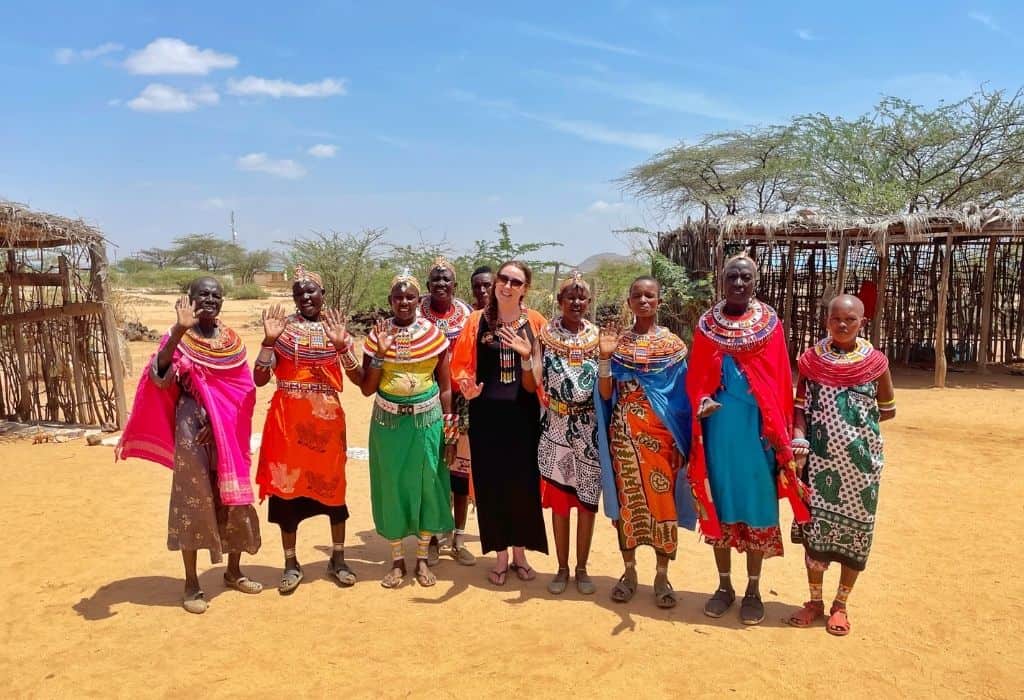
Samburu National Reserve
Samburu National Reserve lies around 300km north of Nairobi on the banks of the Ewaso Nyiro River.
Believe it or not, Samburu Reserve in Kenya was the first safari I ever went on back in 2009. I cried when I saw an elephant in the wild for the first time. It was such a special moment in my life.
I also visited Umoja Women’s Village, an initiative set up by a lady called Rebecca Lolosoli. The project was set up to help women and girls from the Samburu tribe who are the victims of violence from their husbands or forced into marriage with older men from a very young age.
If you don’t fancy the drive, you can fly up to Samburu from Nairobi’s Wilson Airport.
How Many Days to Spend in Samburu National Reserve
2 – 3 Days. As it’s a bit of a drive from Nairobi, I would recommend spending at least 2 – 3 nights there. It’s also a great place to stop if you are exploring Northern Kenya . and can easily be combined with a safari to Ol Pejeta Conservancy too.
Things To Do in Samburu National Reserve
- Go on safari in Samburu National Reserve or Buffalo Springs National Reserve on the other side of the river. The daily park fee covers you for both places. You can see my guide to Samburu National Reserve here .
- Visit the Umoja Women’s Village (see a Youtube video about the village here ). It costs 1000 KES per person to visit for the day.
Where to Stay in Samburu National Reserve
- Umoja Women’s Village: For a truly local experience, you can stay at the Umoja Women’s Village.
- Sabache Camp : Alternatively, I’d recommend Sabache Camp, a good mid-range option.
- Elephant Bedroom Camp : For a more high-end stay, have a look at the wonderful Elephant Bedroom Camp.
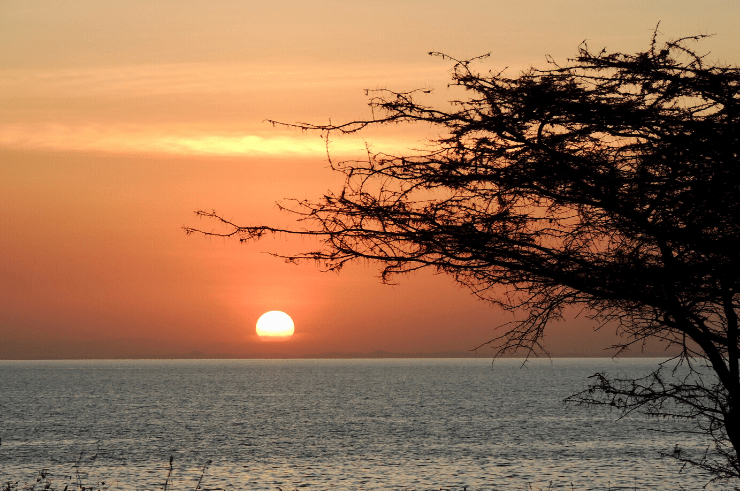
Lake Turkana
Remote Lake Turkana, also known as the ‘Jade Sea’, doesn’t find itself on many Kenya itineraries, but it can be an amazing adventure for the intrepid traveller, especially if you venture up there during the Lake Turkana Festival which takes place in June (usually – they have been known to move it).
The Lake Turkana Cultural Festival was created to help relations between the different tribes who live within the region and promote ‘cross-cultural interaction, harmony, cohesion, integration, cooperation and trading’.
At the festival, you will have the opportunity to observe and interact with people from around 14 remote Kenyan tribal groups, including the El Molo, Randille, Samburu and Turkana as well as learn about their way of life.
This is definitely something special if you can squeeze it into your Kenya itinerary. Just keep an eye on the safety warnings around the region and seek local advice before you drive up there.
How Many Days to Spend in Lake Turkana
5 – 7 days. The festival lasts for 3 days and it will probably take you a good couple of days to get up there and a couple of days to back down (even without stops), so allow a week altogether, unless you fly. Samburu, Mount Kenya or Ol Pejeta are good places to stop en route.
Things To Do in Lake Turkana
- See the Teleki Volcano.
- Go fishing on the lake.
- Visit some prehistoric sites.
- Take a boat ride on the lake.
- Go bird watching.
- Visit a local tribe.
- Take part in the Lake Turkana Festival.
Where to Stay in Lake Turkana
- Camping by Lake Turkana: The festival takes place in Loiyangalani. If you’re on a budget, camping is usually the best option – there is very little infrastructure so it is best to be self-sufficient.
- Malabo Resort : Don’t fancy camping try Malabo Resort.
- Eliye Springs Resort : On the other side of the lake, the most reliable option is Eliye Springs Resort.
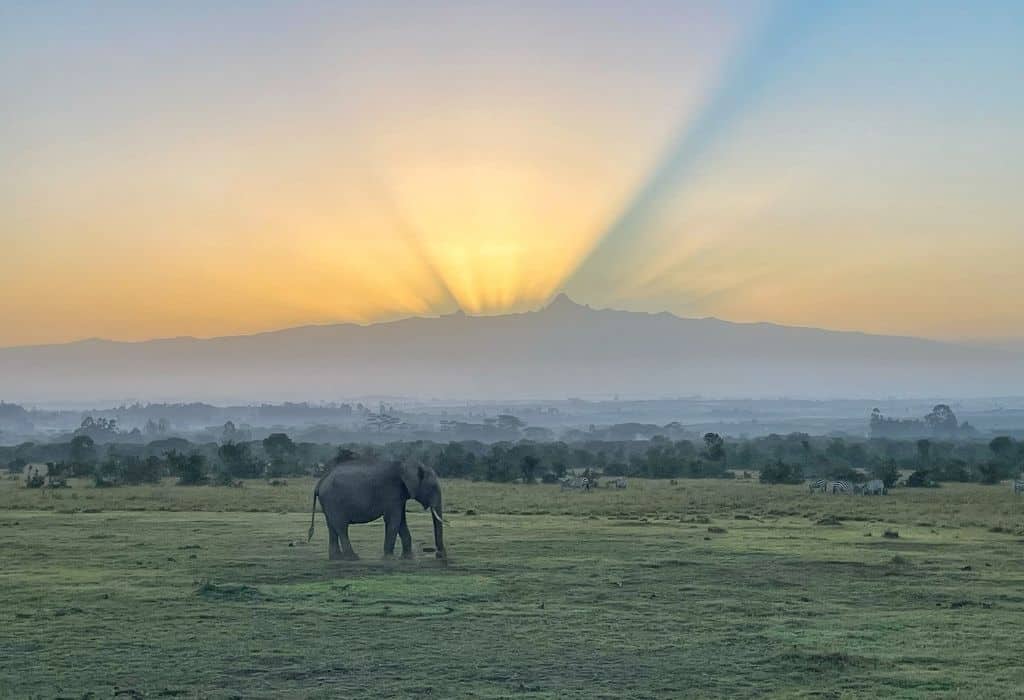
Mount Kenya National Park
Near to the Samburu National Reserve lies Mount Kenya, Kenya’s highest mountain at 5,199 metres – in fact, it’s the second-highest mountain in Africa.
Reaching the summit requires technical climbing, so most trekkers head to the 3rd highest peak, Point Lenana which usually takes between 4 and 6 days. Shorter treks are also available. Most trekkers start from the town of Naro Moru.
If you’re feeling less energetic you can take a helicopter ride over the summit. Flights usually depart from Nanyuki.
How Many Days to Spend in Mount Kenya National Park
4 – 6 days if climbing the mountain. More if you want to stay somewhere close the night before and after your trek or want to visit some of the other nearby areas, less if you are just passing through and doing a day hike.
Things To Do in Mount Kenya National Park
- Hike or climb Mount Kenya.
- Take a helicopter ride over the summit.
- Visit the Ngare Ndare waterfall.
- Visit nearby Meru National Park.
- Visit the Lewa Wildlife Conservancy.
- Visit Aberdare National Park.
Where to Stay in Mount Kenya National Park
- Noro Moru River Lodge : Some treks offer transfers from Nairobi but if you want to stay closer, try the Noro Moru River Lodge.
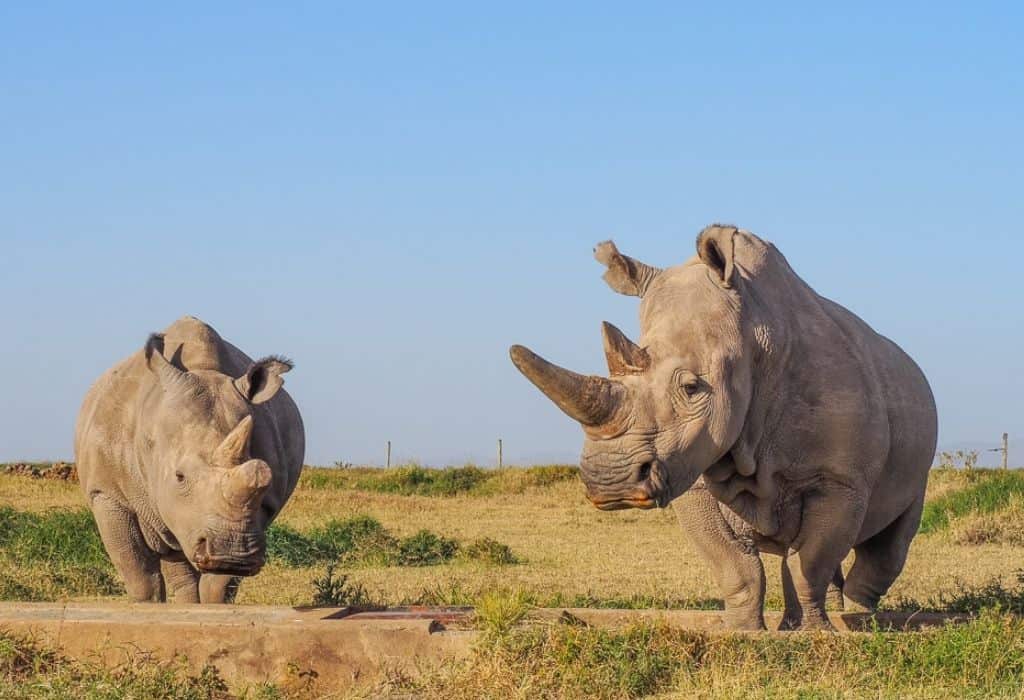
Ol Pejeta Conservancy
Ol Pejeta is one of my favourite places in Kenya . This privately-owned wildlife conservancy to the west of Mount Kenya National Park houses the largest population of the endangered black rhino in East Africa so sightings are pretty much guaranteed.
There are so many great things to do in Ol Pejeta and it’s perfect for families. You can even go horse riding through the reserve, allowing you to get close to the animals without scaring them, that includes the rhinos.
The great thing about this conservancy is that you don’t have to be staying there to visit. You can just pay to visit for the day. One of the main highlights is the waterhole at Sweetwaters Serena Camp where you will often see rhinos coming to drink.
How Many Days to Spend in Ol Pejeta
1 – 2 days at the minimum. But I reckon you could easily spend longer! Plan your stay around the activities you want to do. You can read more about planning your trip in my Ol Pejeta travel guide .
Where to Stay in Ol Pejeta
- Ol Pejeta Campsites : There are a number of campsites available inside the park.
- Sweetwaters Serena Camp : Part of the Serena portfolio, Sweetwaters Serena Camp is an excellent choice.
- Olepangi Farm : For a luxurious stay, I would suggest the Olepangi Farm which is just outside the park.
Things To Do in Ol Pejeta Conservancy
- Go horse riding to see Fatu & Najin the last two Northern White Rhinos.
- Visit Baraka, the blind black rhino.
- Join the K9 dog tracking team.
- Go on a lion tracking game drive.
- Visit the Sweetwaters Chimpanzee Sanctuary.
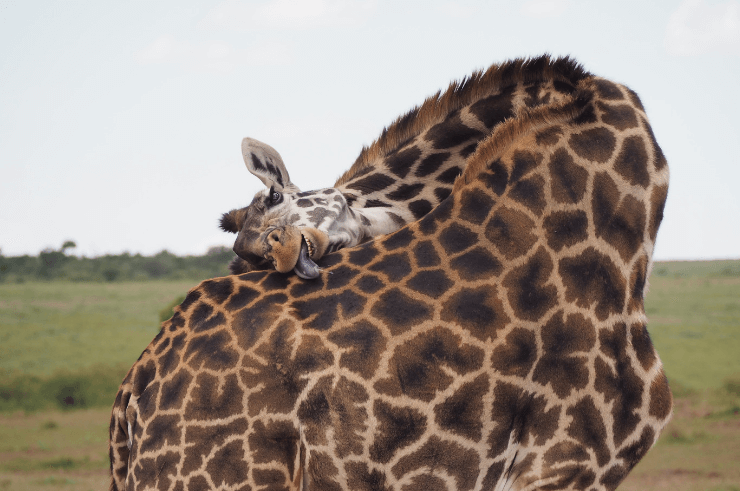
Lake Naivasha & Hell’s Gate National Park
The next stop on this Kenya itinerary is around Lake Naivasha and Hell’s Gate National Park.
On the way, you could stop at Thomson Falls , which lies between Ol Pejeta and Lake Naivasha, either for a picnic stop or an overnight stay if coming from further away.
Naivasha town lies close to Lake Naivasha. Nearby you’ll find the wonderful Hell’s Gate National Park, said to be the inspiration for the Lion King due to its dramatic landscape. What’s also special about Hell’s Gate, is that you can take cycling safaris allowing you to get a completely different safari perspective.
Naivasha is also close to the extinct Mount Longonot which can be climbed in a few hours and offers great views over Lake Naivasha, as well as Elsamere, home of Joy Adamson, the writer of Born Free.
How Many Days to Spend in Naivasha & Hell’s Gate National Park
2 – 3 days. If you were in a rush, 1 night could be ok if you’re not travelling to or from too far.
Where to Stay in Naivasha & Hell’s Gate National Park
- Camp Carnellys : The most popular budget option is Camp Carnellys.
- Elsamere Lodge : This is the lodge on the site of Elsamere, of Born Free fame, where Joy Adamson lived.
- Enashaipai Resort & Spa : The name of this lodge means ‘state of happiness’ in the Maasai language.
Things To Do in Naivasha & Hell’s Gate National Park
- Go cycling or do a safari at Hell’s Gate National Park.
- Take a dip in the Ol Karia Geothermal spa.
- See the flamingos at Lake Oloiden.
- Take a boat out on Lake Naivasha.
- Go walking on Crescent Island .
- Visit Elsamere.
- Climb Mount Longonot.
Lake Nakuru National Park
At one time, I would have definitely said to go to Lake Nakuru, which used to be famous for its flamingos, however, rising water levels have forced the flamingos to move to Lake Bogoria (around 4 hours north) and pollution from the nearby town has also had a negative effect – it’s very sad.
Saying that it’s still a good place to see rhinos, there are a couple of wonderful viewpoints and it’s a good stopover between the Mara and Ol Pejeta – but I probably wouldn’t include it as a main destination on your Kenya itinerary. Read more here .
How Many Days to Spend in Lake Nakuru National Park
1 day, for the reasons I mentioned above.
Things To Do in Lake Nakuru National Park
- Go on safari to see the white rhinos.
- Visit Baboon Cliff Viewpoint.
Where to Stay in Lake Nakuru National Park
- Lake Nakuru Lodge : This is a great mid-range option in the park.
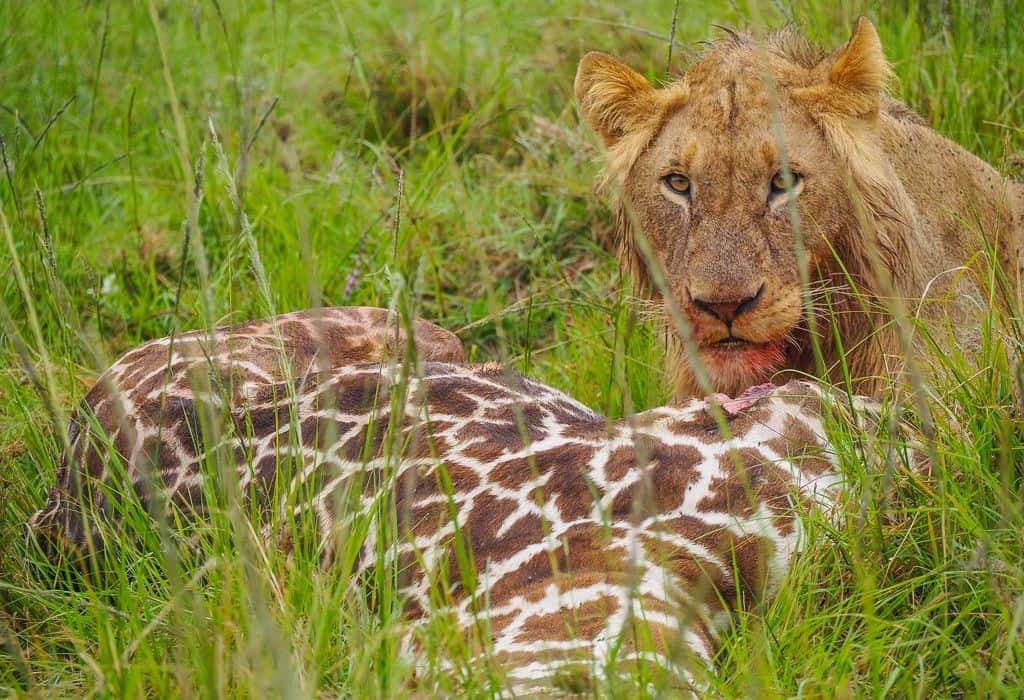
Masai Mara National Reserve
The next stop on our Kenya itinerary is the incredible Masai Mara, home to the ‘Big Five’ and arguably the most famous safari destination in the world.
As well as game drives through the park, you can take a balloon ride to see it all from above (with a champagne breakfast at the end), which is especially cool if you time it when the Great Migration is passing through ”“ this varies slightly from year to year, but usually happens around July, August & September.
If you want an amazing and varied Masai Mara safari, I’d definitely recommend coming along on my Rock My Kenya & Tanzania Adventure . It’s a really special and awesome trip (if I do say so myself)!
How Many Days to Spend in the Masai Mara National Reserve
3 – 4 days. It takes at least half a day to get to and from the Masai Mara by road (from Nairobi), so I would suggest spending at least 3 nights here. You can save a bit of time by flying into Keekorok Airstrip and I believe they are considering making this an international airport – watch this space.
Things To Do in the Masai Mara National Reserve
- Go on a Masai Mara safari.
- See the wildebeest & zabra migration (usually July – October).
- Spend time with the Maasai people.
- Go hot-air ballooning.
- Go on a horse riding safari.
- Visit the Sekenani township.
Where to Stay in the Masai Mara National Reserve
- Kobi Farm : My favourite place to stay is Kobi Farm, run by my friends who used to own Mara Explorers Camp.
- Governor’s Camp : Beautiful tented camp in the heart of the Mara.
- Mara Explorer Camp : Beautiful luxury camp, not to be confused with the old Mara Explorers Camp.
- Angama Mara : One of the best, Angama Mara is the place to go if you’re looking for somewhere really special with an ‘Out of Africa’ romantic vibe.
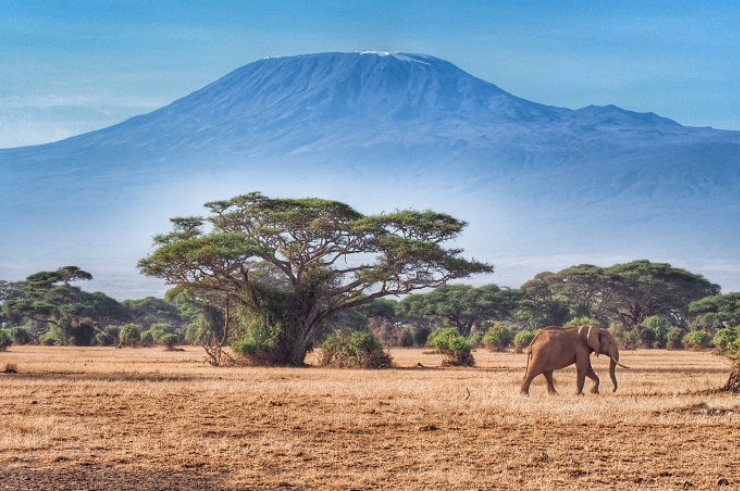
Amboseli National Park
When planning your Kenya itinerary, you should definitely consider Amboseli National Park, one of Kenya’s most iconic yet not that widely known travel destinations.
Amboseli is special for a couple of reasons, firstly for having one of the densest elephant populations in the world, and secondly for the fact that it lies at the base of Kilimanjaro, which provides an incredible backdrop for all of your photos. Simply magical!
Unless you fly between the Mara and Amboseli, you’ll probably need to stop over in Nairobi, otherwise, it would be a very long travel day.
Alternatively, you could also visit Tsavo National Park which is a little bit further on towards Mombasa.
How Many Days to Spend in Amboseli National Park
1 – 2 days. Allow yourself at least 1 full day to really enjoy your safari. Just be aware that the weather can affect the view of Kilimanjaro, so the longer you spend here, the more chance you will have for good views.
Things To Do in Amboseli National Park
- Spot elephants and other animals on safari.
- Admire Kilimanjaro.
- Visit the Maasai people.
Where to Stay in Amboseli National Park
- Kibo Safari Camp : My favourite place to stay in Amboseli is Kibo Safari Camp which has great views of Kili from the rooms.
- Amboseli Eco Camp : If you’re a fan of eco-camps, you might like to stay here.
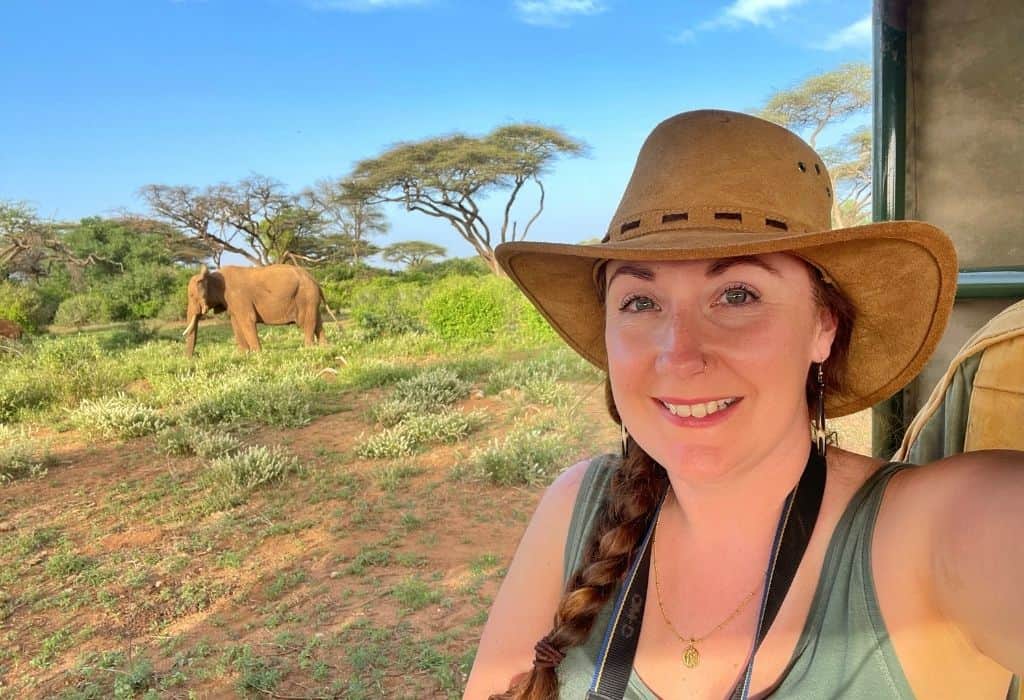
Tsavo National Park
I first read about Tsavo National Park in one of my favourite books, Love, Life, and Elephants: An African Love Story by Daphne Sheldrick, founder of The Sheldrick Wildlife Trust.
Tsavo is famous for having lots and lots of elephants and is split into two sections, Tsavo West and Tsavo East.
How Many Days to Spend in Tsavo National Park
2 – 3 days. You could spend more if you hadn’t been on too many other safaris during your trip.
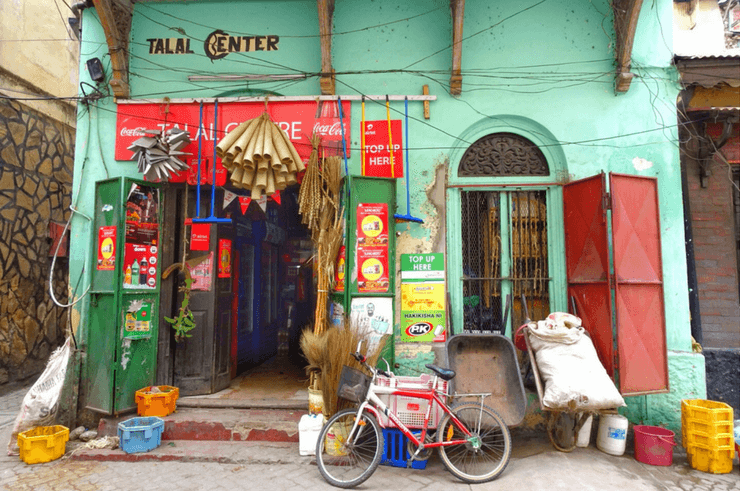
Mombasa is a fantastic coastal city, with a very different feel to Nairobi. Whereas Nairobi is a very cosmopolitan, Mombasa has a distinct old-world, meets new-world Swahili flavour.
Mombasa is steeped in history, being one of the oldest and busiest ports on the African continent and is a great place to immerse yourself in Swahili culture.
Take a tour of the city and enjoy some of the great restaurants and bars too.
If you don’t go through Amboseli or Tsavo, you can easily get the train from Nairobi to Mombasa. Alternatively, you can also jump on the train at various different towns, including Voi, near to Tsavo National park. Booking in advance is advisable as the train almost always books up.
How Many Days to Spend in Mombasa
1 – 2 days. Mombasa is a great and important historical city, however, it’s not my favourite place in Kenya so a day or two is enough for me.
Things To Do in Mombasa
- Take a city tour.
- See the Mombasa tusks.
- Visit Uhuru Park.
- Explore the spice markets.
- Visit Fort Jesus and the Old Town.
- Shop for souvenirs.
- Visit Haller Park and visit the Nguuni Wildlife Sanctuary.
Where to Stay in Mombasa
- Tulia House : The main backpacker hangout in Mombasa is Tulia House. The bathrooms aren’t great, and the rooms are ok, but they have a pool and sociable bar, great for meeting new friends.
- Best Western Plus Creekside : If you want somewhere reasonably priced, with nice views and close to town, check out this place.
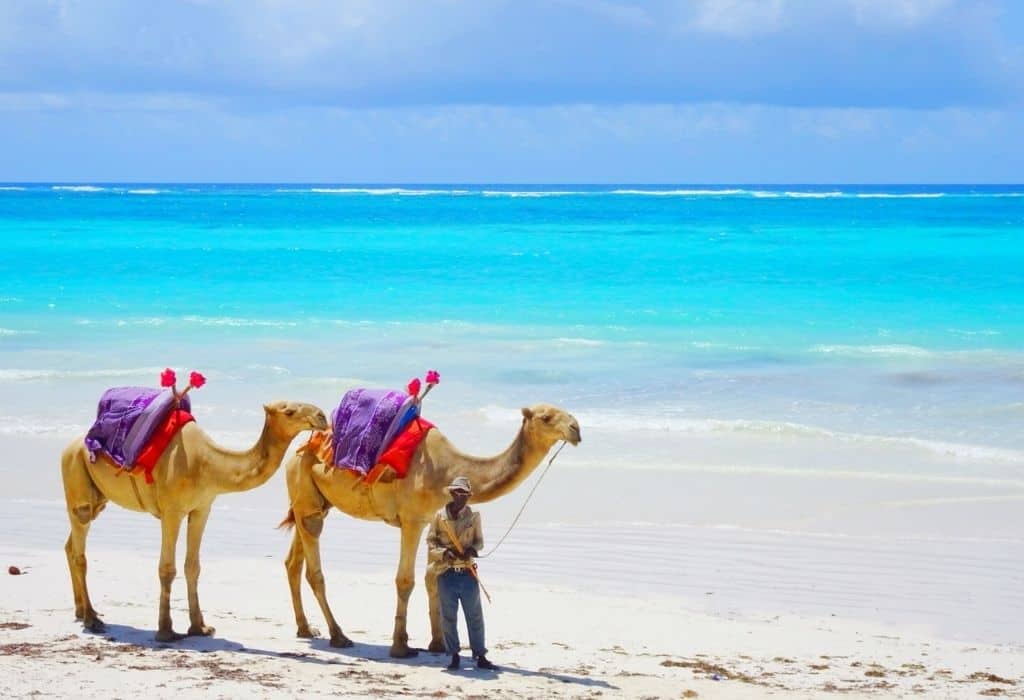
Diani Beach
You can end your Kenya holiday in Diani, one of those picture-perfect locations, known for beautiful blue seas and white, sandy beaches. Diani is a popular honeymoon spot, as well as a backpacker favourite, so it’s a great place to add to your Kenya itinerary.
Whether you’re looking to relax, get adventurous or party – there’s something for everyone.
The trade winds make Diani a popular spot for kite surfing and it’s also one of the best places for sky diving in Africa.
At night, the backpackers tend to gather at Forty Thieves (although I believe it’s closed at the moment) which is always fun, especially on the weekend.
How Many Days to Spend in Diani Beach
2 – 3 days. Diani Beach is a great place to relax!
Things To Do in Diani Beach
- Go skydiving over the Swahili coast.
- Explore Shimba Hills National Reserve.
- Take a dhow trip to Kisite-Mpunguti Marine National Park.
- Relax on the beach and party the night away.
Where to Stay in Diani Beach
- Stilts : Stilts is a backpacker place, set back from the beach in a jungle setting. It’s one of my favourites and you also get to use the facilities at their sister hotel, Flamboyant.
- Flamboyant : Owned by the same people as Stilts, for mid-range, try Flamboyant is a nice choice, with a pool and lying directly on the beach.
- AfroChic : For a more luxurious stay, check out AfroChic, part of the Elewana Collection.
- Diani Villa : If you have a big group, I would suggest Diani Villa.
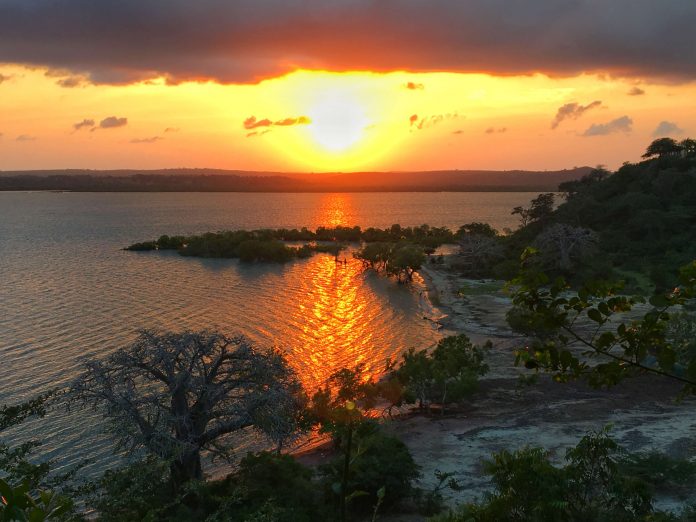
Kilifi, a town north of Mombasa, is one of my favourite places in Kenya.
I think a lot of this has to do with the incredible backpackers there, which is called Distant Relatives. It is truly is backpacker’s paradise and I’ve known many a person to go there for a couple of days and leave weeks, even months later.
The friendly, laid back-vibe tends to attract a lot of cool people including locals, independent travellers, so there’s always something going on and someone to hang out with.
You can spend your time relaxing in a hammock, swimming in the creek or the pool or taking a day trip out somewhere. There are lots of things to do in Kilifi.
Again, you could stay in Kilifi and easily explore Watamu and Malindi from there, but I guess your Kenya itinerary will depend on how much time you have – but the options are there!
How Many Days to Spend in Kilifi
How long is a piece of string? On a serious note, at least 2 full days.
Things To Do in Kilifi
- See the bioluminescence in the waters of Kilifi Creek.
- Relax on the white sands of Bofa Beach.
- Sail on a traditional dhow boat.
- Visit Vuma Cliffs.
- Go snorkelling or scuba diving.
- Take a village tour.
Where to Stay in Kilifi
- Distant Relatives Ecolodge & Backpackers : I love Distant Relatives. It’s one of those places that people either really love or they don’t and lots of people get ‘stuck’ there. It’s got a strong hippy/eco/permaculture vibe if you’re into that!
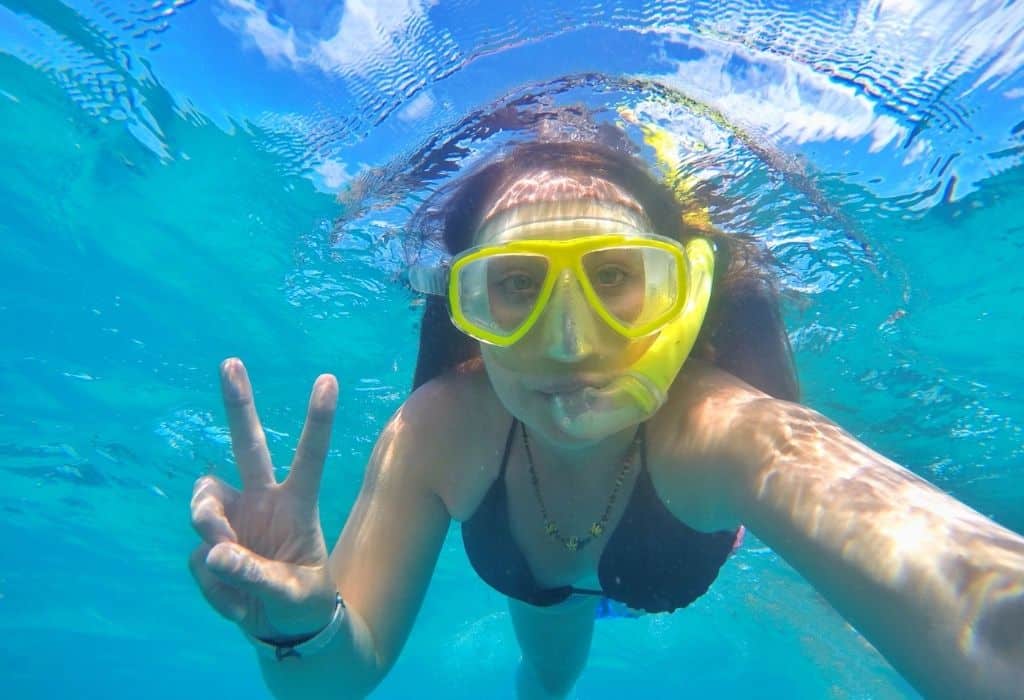
Watamu & Malindi
North of Kilifi, you’ll find Watamu and Malindi, two beautiful beach towns and popular Kenya holiday destinations, both with plenty of activities, hotels and restaurants to keep you busy for a good few days, if not longer.
I’m putting these two together because they are so close to each other (approx 30 mins) – so you could stay in one place and enjoy both. Kilifi is also nearby, but Kilifi holds a special place in my heart, so Kilifi gets a section of its own.
You can fly to Malindi from Lamu or Nairobi, or you can get a local minibus (matatu) from Mombasa.
How Many Days to Spend in Watamu & Malindi
2 days + (more if you can) – is there such a thing as too much beach time?
Things To Do in Watumu & Malindi
- Visit Arabuko Sokoke Forest.
- Go scuba diving or snorkelling at Watamu Marine National Park and Reserve.
- Explore the Gedi Ruins.
- Relax on Golden Beach.
- Hang out at Osteria Beach Restaurant.
- Visit the Marafa Depression.
- Do some watersports (SUP, surfing, kite surfing).
Where to Stay in Watamu & Malindi
- White Elephant Sea Lodge : Beach lodge in Malindi.
- Kobe Suite : Mid-range beach resort in Watamu.
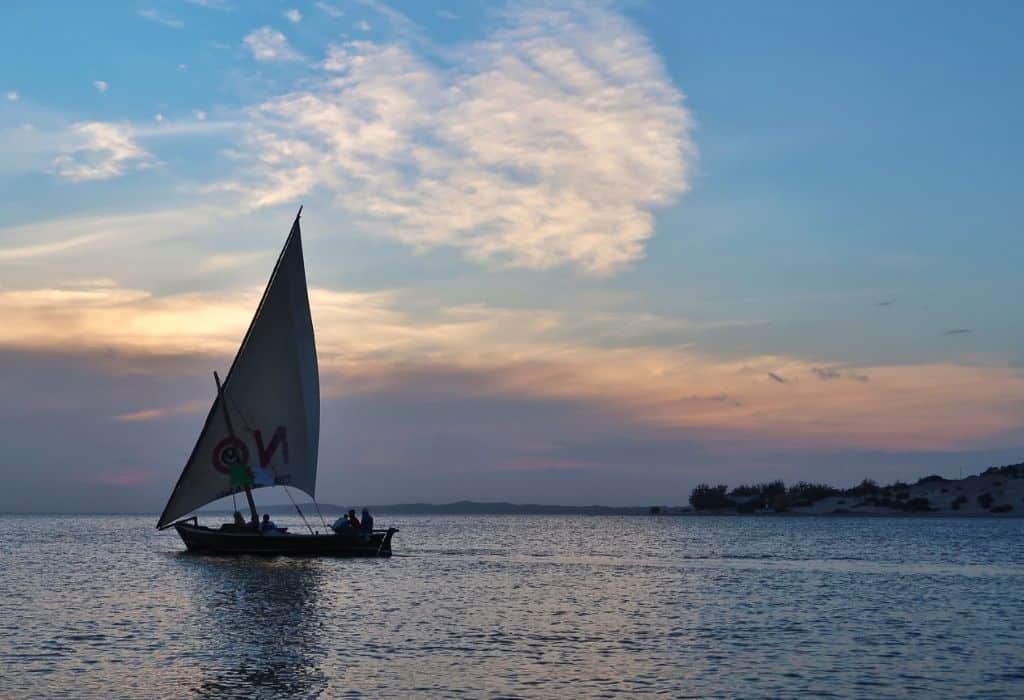
Lamu, in northern Kenya, is a UNESCO World Heritage Site and possibly the best place in the world to experience the traditional Swahili culture – even more so than Mombasa or Stone Town in Zanzibar .
Visitors to this sleepy island often spend much longer here than they intend to, sucked in by the laidback way of life. Spend your days getting lost in the alleyways, relaxing on the beaches and immersing yourself in this intoxicating place.
I absolutely love Lamu and wrote a whole Lamu travel guide to help you plan your own trip.
The road to Lamu is not known for being very safe, so it is advisable to fly. You can catch a flight from Nairobi, Mombasa or Malindi. Once you arrive, it’s a short ferry ride to Lamu from Manda Island.
How Many Days to Spend in Lamu
3 days at least. I spent 4 nights there and that was great, but I could have stayed longer.
Things To Do in Lamu
- Wander through Lamu town.
- Visit the market, fort and the museum.
- Take a trip on a dhow boat.
- Go to a festival.
- Go sunrise swimming and relax on Shela Beach.
- Visit the donkey sanctuary.
Where to Stay in Lamu
- Banana House & Wellness Centre : Check out this lovely Swahili house which also hosts retreats. This is where I stayed and I loved it!
- Manda Bay : Manda Bay is a beautiful, boutique beach lodge.
I hope this helps you plan an amazing Kenya itinerary! Got any questions? Leave them in the comments below!
Other Kenya posts you might enjoy…
- 25 Awesome Things to Do in Nairobi, Kenya
- The Perfect 2-Week Kenya & Tanzania Itinerary (Plus Map, Tips & Things To Do)
- A Little Guide to Lamu Island in Kenya
- Planning a Trip to Ol Pejeta Conservancy in Kenya – Everything You Need to Know
- Kenya vs Tanzania – Which is the Best Country to Visit?
- The Best Hostels, Guesthouses & Campsites in Kenya
- How To Get Visas for Kenya & Entry Requirements Explained
- 10 Unique Places To Visit in Northern Kenya
- How to Travel to the Masai Mara on a Budget (Under $500)
- A Guide to Visiting Samburu National Reserve in Kenya
- Visiting the Umoja Women’s Village in Kenya
- A Guide to Amboseli National Park – Kenya’s Most Iconic Unknown Safari Destination
Pin This Post For Later
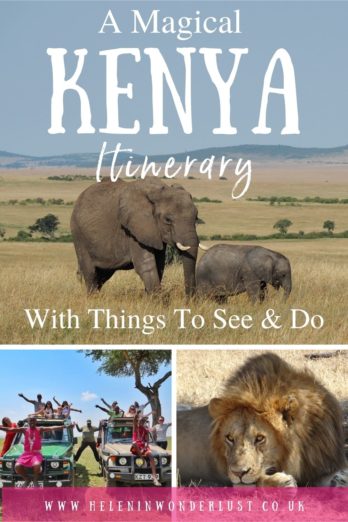
I love to travel all over the world, but it's Africa that holds a special place in my heart. My mission is to help people travel Africa in an authentic, safe, fun, adventurous and ethical way.
Similar Posts
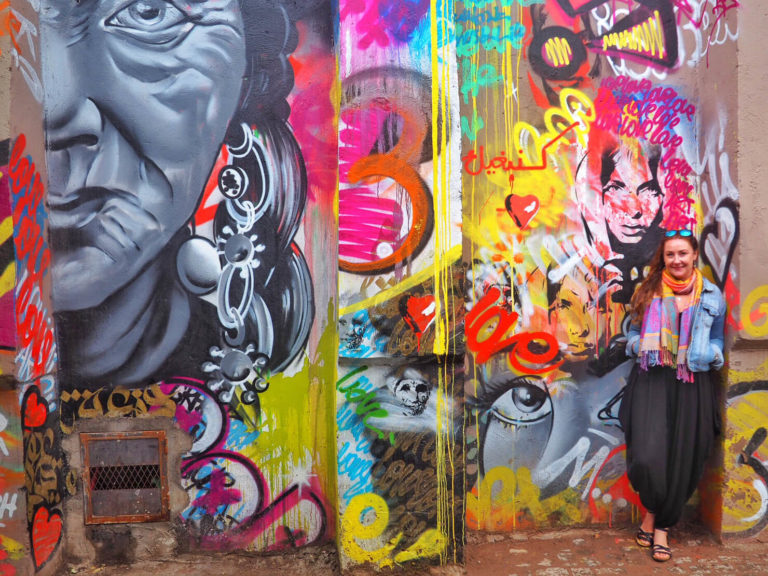
The Charm of Marrakech
If you want to read my top tips for Marrakech, click here. If you want to read about my first…

The Day I Met Jedward, Went to the Playboy Mansion and Saw Madonna’s Bush
“What’s your dream?” – The famous lines uttered in Pretty Woman. Everyone goes to Hollywood looking for something, right? Fame, fortune,…
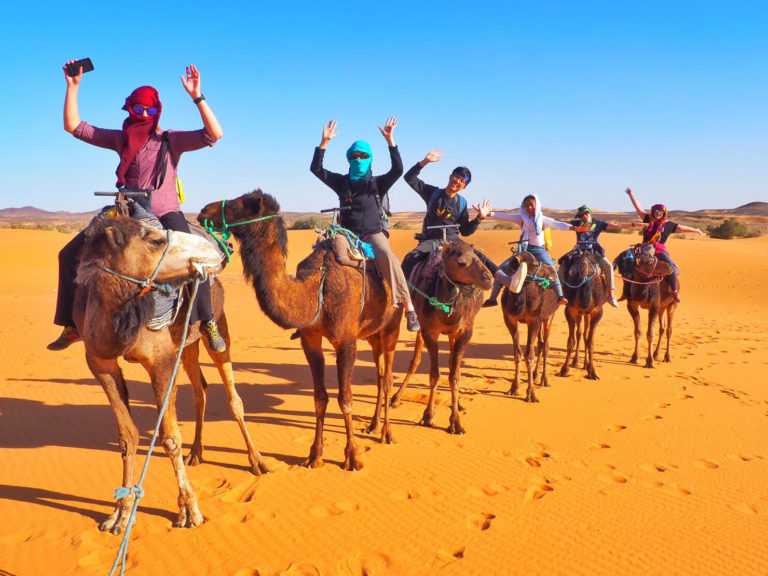
Highlights of the Rock My Morocco Adventure
Welcome to the Rock My Morocco Adventure photo diary – April 2018 edition. After running my Rock My Tanzania &…
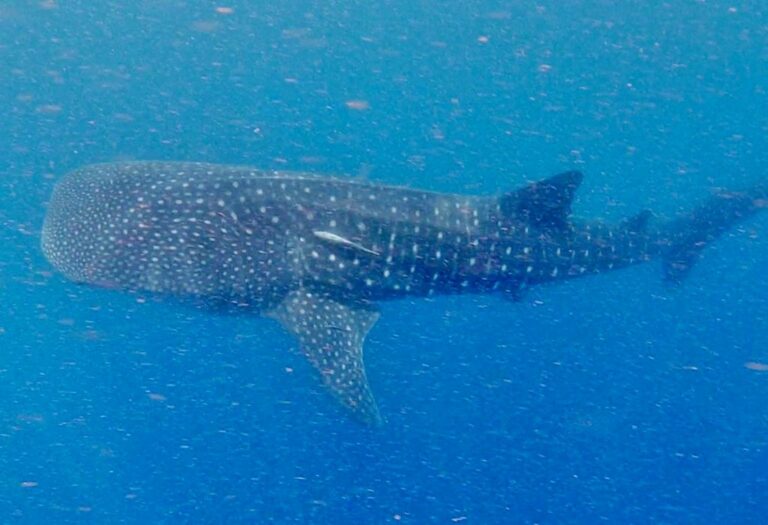
Southern Tanzania & Mafia Island Group Trip (26 October – 10 November 2025)
Experience the best of Southern Tanzania on a safari to Selous/Nyerere, Ruaha, Mikumi and Mafia Island.
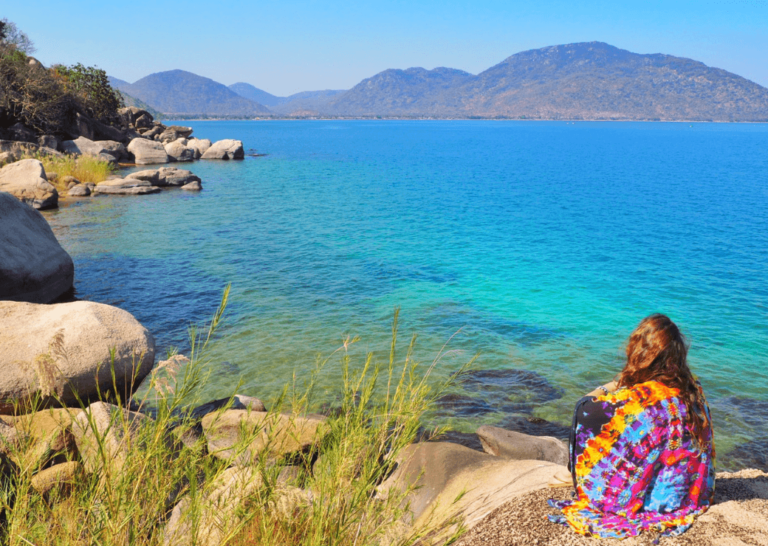
An Awesome Malawi Itinerary (Plus Map, Tips & Things To Do)
Malawi is an incredible country, often overlooked compared to its more famous neighbours. But I would go as far as…
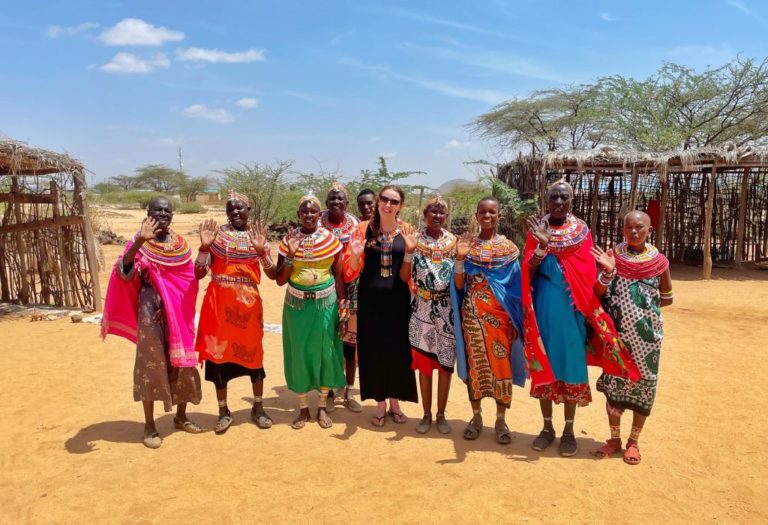
How to Visit the Umoja Women’s Village in Kenya
One of the highlights of my first trip to Africa in 2009 was a visit to the Umoja Women’s Village in…
Hello Helen, Hope you’ve been well. May name is maggy and i really enjoyed reading your blogs. I would have sent you a private message but there is no contact me link. I just started a blog and i’m looking for people who have traveled to my city to share there story. If interested it will be honor to feature your articles and pictures. send me a message and let me know if it’s an option
Best regards Maggy
Hi Helen! I will be in Kenya over the Christmas and New Year holiday this year. I am traveling solo (female) and wonder where in Kenya, and perhaps what hostel, you’d recommend to spend New Years Eve.
Leave a Reply Cancel reply
Your email address will not be published. Required fields are marked *
Privacy Overview
Lundi à Vendredi : 9h-19h. Samedi : 9h-18h. Appel non surtaxé.
- Découvrir Ôvoyages
- Où partir ?
Guide voyage
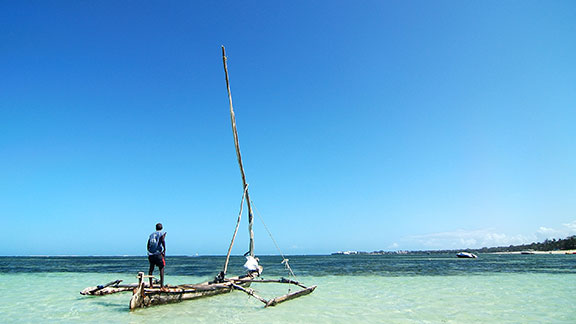
Préparez vos vacances au Kenya !
Préparez vos vacances au kenya.
Entre grands espaces, plages paradisiaques, forêts tropicales luxuriantes, déserts de dunes, glacier perché à 5 000 mètres, faune sauvage variée, parcs nationaux et réserves naturelles, le Kenya est la destination rêvée des amateurs de nature. Un voyage au Kenya c'est aussi partir à la rencontre des populations locales et de leur incroyable diversité ethnique à travers le pays, que ce soit à Nairobi ou à Mombassa.
Schillings kenyans
Anglais & Kiswahili
Nos coups de coeur au Kenya
Notre guide complet kenya, 3 bonnes raisons de voyager au kenya.

Le Kenya possède tous les paysages africains possibles : savanes, forêts équatoriales, plateaux semi-désertiques, cocoteraies, plages aux eaux translucides, montagnes de la vallée du Rift sans oublier le grandiose Kilimandjaro. Comme la densité de la population est plutôt faible au Kenya, partir au Kenya c'est forcément découvrir que les grands espaces sont omniprésents. Voyager au Kenya est donc un vrai bonheur pour tous ceux qui aiment la nature.
Les safaris, les grands mammifères africains, les fameux " Big Five " font que la richesse de la faune kenyane est exceptionnelle. On y retrouve d'ailleurs presque tous les mammifères du continent africain et en nombre : lions, léopards, guépards, éléphants, buffles, zèbres, antilopes… Sans le millier d'espèces d'oiseaux répertoriées. Passer des vacances inoubliables au Kenya est le rêve de tous les fans d'animaux. Alors optez pour un voyage combiné safari et plage au Kenya .
Grâce à la côte kenyane qui est splendide, notamment à Lamu et Mombasa, de nombreux resorts balnéaires se sont construits près des plages. Elles ont toutes des des eaux limpides et chaudes et sont également protégées des courants par une barrière de corail, sans oublier les fonds marins qui sont riches d'une faune variée... Eau turquoise et sable chaud vous attendent au Kenya ! Voilà de quoi passer de merveilleuses vacances balnéaires au Kenya .
Quand partir au Kenya ?
Le climat du Kenya est équatorial mais les températures sont plus douces sur la côte grâce aux vents marins tandis qu'une chaleur torride règne généralement au nord et à l'ouest. Dans cette destination ensoleillée en permanence, la température est à 25°C en moyenne.
On distingue deux saisons : la saison sèche, qui correspond à la haute saison touristique, et s'étend de décembre à mars ainsi que de juillet à septembre ; la saison des pluies d'avril à juin et le mois de novembre, est une période qui n'est pas recommandée pour un séjour de dernière minute au Kenya .
Découvrir le Kenya
La culture du Kenya est incroyablement variée du fait des différents peuples qui sont venus s'y installer au fil de l'histoire. Vous le remarquerez rapidement pendant votre voyage au Kenya . Au total, plusieurs dizaines d'ethnies cohabitent ensembles à travers le pays. Le peuple Kikuyu représente la majorité de la population kenyane. Suivent ensuite par ordre d'importance : le peuple Luhya, le peuple Luo, le peuple Rendile et beaucoup d'autres ethnies encore.
Par ailleurs, les habitants adorent inviter les touristes à découvrir leur vie quotidienne et leurs traditions. Si vous optez pour un séjour tout compris au Kenya , vous aurez certainement l'occasion de partir à la rencontre d'une de ces ethnies et de partager une de leurs journées.
Côté religion, les Kenyans sont majoritairement chrétiens. Un tiers de la population est musulmane et les Musulmans vivent principalement sur le littoral et à l'Est. Les rites animistes restent par ailleurs très répandus dans la population.
Les paysages sont très variés au Kenya. On peut cependant distinguer la côte et ses 400 km de plages d'une part, où se trouve plutôt une identité swahilie et musulmane, et d'autre part, le Kenya intérieur, avec Nairobi et les parcs nationaux.
Une grande partie du sud-ouest est montagneuse. Vers l'ouest, se trouve la vallée du Rift et les Highlands verdoyants où l'on cultive thé et café depuis l'époque coloniale anglaise.
Au nord du lac Victoria, qui est le plus grand lac d'eau douce d'Afrique équatoriale, se trouvent les restes d'une bonne partie de la forêt primaire qui s'étendait jusqu'au Congo. À l'est, vous trouverez principalement un paysage de plaines jusqu'à la Somalie.
Près de l'Éthiopie se trouve le grand lac Turkana, un des principaux points d'eau du pays. N'hésitez pas à réserver un circuit pas cher au Kenya pour découvrir toutes les merveilles qui s'offrent à vous.
La cuisine est essentiellement à base de viande de bœuf et de mouton, de haricots, pommes de terre et de bananes plantains.
Pendant vos vacances au soleil au Kenya , vous pourrez goûter quelques spécialités kenyanes comme le nyama choma, qui est le barbecue local ou encore l'ugali, une purée de maïs, qui est également très répandue. Les restaurants indiens et les fruits – mangues, papayes, ananas, fruits de la passion, bananes, goyaves – constituent une bonne partie du régime alimentaire kenyan.
Vous aurez la possibilité de pratiquer de nombreuses activités sportives pendant votre voyage au Kenya : randonnée et trekking, alpinisme, parapente, parachutisme, rafting, plongée sous-marine, kitesurf, équitation, pêche, athlétisme, golf... Les possibilités sont multiples.
Beaucoup d'hôtels organisent des sorties pour la pêche au gros (espadons, marlins, requins...), principalement à Shimoni, Mombasa et Malindi. La meilleure saison se situe entre novembre et mars.
La destination Kenya possède aussi de très beaux spots de plongée ; de Lamu à Mombasa, les fonds fonds marins sont splendides, notamment grâce aux différentes réserves marines. Ôvoyages vous conseille notamment les spots de Malindi-Wataru (Nord de Mombasa) et de Kisite Mpunguti (Sud de Mombasa) pendant votre séjour à Mombasa . Vous trouverez plusieurs clubs de plongée sérieux et professionnels sur la côte kenyane.
Nos incontournables au Kenya : top 10 à voir, à faire, à visiter

Avec environ 3 millions d'habitants, Nairobi est une capitale fascinante et contrastée avec des quartiers pauvres non loin de quartiers récents qui sont l'épicentre de la vie économique kenyane. Au cœur de la ville, le parc national de Nairobi est une réserve naturelle protégée où vous pourrez observer beaucoup d'animaux de la savane à l'occasion de votre visite de la ville de Nairobi . Vous pourrez y voir des girafes, des gnous, des zèbres et le fameux rhinocéros noir, une espèce protégée. Pour une vue panoramique sur la capitale, rendez-vous tout en haut de la tour de la Kenyatta Conference Center . La ville de Nairobi accueille également la splendide mosquée de Jamia, le Uhuru Park, l'authentique marché de Masaaï ou encore le Bomas of Kenya, situé dans le centre culturel, une reproduction de village kenyan.
La réserve naturelle de Masaï Mara , au sud-ouest du pays, est une des plus belles du pays et c'est une visite incontournable au Kenya . Elle porte le nom de la fameuse tribu Masaï qui vit sur place et celui de la rivière Mara qui la traverse. Cette réserve est dans le prolongement des terres tanzaniennes du Serengeti et elle est essentiellement constituée de savane sur plus 1500 km2. C'est le site parfait pour observer les célèbres « big five » à savoir le lion, le léopard, l'éléphant, le rhinocéros et le buffle. Mais vous pourrez aussi admirer d'autres mammifères africains sur places : des zèbres, des girafes et des gnous.
C'est le 2ème plus beau parc à découvrir au Kenya . Le parc d' Amboseli se trouve au pied de l'emblématique Kilimandjaro, toujours très impressionnant avec ses 5895m de hauteur, et qu'on peut admirer en toile de fond tout au long de la découverte du Parc. Cette réserve de biosphère classée au patrimoine mondial de l'UNESCO compte beaucoup d'animaux de la savane dont d'importants troupeaux d'éléphants. Le Parc Amboseli compte aussi beaucoup de marécages et ils sont fréquentés par environ 400 espèces d'oiseaux.
Mombasa représente la plus grande ville portuaire du pays. Elle abrite de nombreux monuments et temples incroyables tels que le Baps Swaminarayan, le Shree Cutch Satsang ou le Jain temple. Visitez la cathédrale de Mombasa, le fort Jesus ou le Pembe Za Ndovu. Profitez de votre séjour à Mombasa pour faire un tour sur l'île de Wasini située à quelques heures de Mombasa. Il s'agit d'une station balnéaire très touristique abritant de nombreux hôtels, bars et restaurants. Non loin de l'île se trouve le parc national marin de Kisite-Mpunguti. Vous pourrez y observer toutes sortes de créatures marines et pratiquer de nombreux sports nautiques.
C'est le troisième parc le plus connu du Kenya et il se compose de deux parties divisées par le chemin de fer Nairobi - Mombasa : Tsavo Est d'un côté et Tsavo Ouest de l'autre. Ce parc a la particularité d'avoir une terre rouge qui donne une certaine couleur rougeâtre aux animaux. Mais ce parc compte aussi un plus grand nombre d'arbres et Amboseli ou Masai Mara, ce qui rend la recherche des animaux plus compliquée mais encore plus glorifiante. Les fontes de glace du Kilimandjaro se retrouvent dans des plans d'eau à Tsavo, ce qui permet de créer des oasis luxuriantes pour les animaux tout au long de l'année.
Ces réserves sont parfaites pour observer la flore et la faune locale. Au cœur de la savane, vous pourrez notamment voir des lions, des girafes, des éléphants ou même des autruches. Une bonne adresse pour un safari lors de vos vacances au Kenya . La réserve de Samburu se trouve à une soixantaine de kilomètres seulement de Mombasa et constitue donc un incontournable lors d'un voyage à Mombasa .
Le Lac d'eau douce de Naivasha est situé dans la vallée du Grand Rift, une vallée composée de failles et de volcans. Vous pourrez observer sur le lac Naivasha des centaines d'espèces d'oiseaux et des hippopotames. Vous pourrez également vous rendre à Crescent Island , une presqu'île où se trouve un sanctuaire d'animaux.
Le lac Nakuru se trouve dans le parc du même nom à plus de 1500 m d'altitude. Vous pourrez faire un safari tout autour du lac pendant votre voyage au Kenya et y admirer un grand nombre d'espèces d'oiseaux, des lions, des léopards, des rhinocéros noirs. Un sanctuaire pour ces derniers qui ont été réintroduit par l'homme alors qu'ils étaient en train de disparaître totalement. Le lac est essentiel pour le maintien de la vie de centaines d'animaux dans la région.
Cette station balnéaire située au sud de Mombasa, est l'une des plus belles d'Afrique. En arrivant sur place, vous comprendrez immédiatement pourquoi. Il s'agit d'un site incontournable lors de vacances Kenya . Ses plages de sable fin sont bordées par la mer turquoise de l'Océan Indien. A marée haute, les sorties snorkeling sont toujours fructueuses et il est possible d'observer de magnifiques espèces de poissons multicolores. Si vous avez envie de vous reposer après un Safari au Kenya , Diani Beach est l'endroit rêvé pour le farniente.
Au nord de la ville de Nakuru, les Thomsons Falls sont des chutes d'eau immenses, de plus de 70 mètres de haut, à environ 2000 mètres d'altitude. Elles se trouvent au niveau de la rivière Ewaso Narok et elles irriguent la forêt luxuriante qu'elles traversent. Ces chutes ont été découvertes par Joseph Thompson dans les années 1880 d'où leur nom. C'est le premier Européen à avoir relié à pied Mombasa et le lac Victoria.
Le Hell's Gate se trouve au sud Naivasha. Il est connu pour ses impressionnantes falaises et ses paysages surprenants non loin de troupeaux d'animaux, le plus souvent des zèbres ou des girafes. Vous pourrez également voir deux volcans éteints, l'Olkaria et le Hobley's. C'est le site parfait pour entreprendre une randonnée en famille pendant votre séjour au Kenya .
Les meilleurs itinéraires au Kenya

Durée : 4 jours
Situé au niveau de l'équateur, le mont Kenya n'est pas aussi touristique que le Kilimandjaro en Tanzanie mais il offre des panoramas superbes qui vous permettront de réaliser de magnifiques photos-souvenirs de votre voyage au Kenya . Sachez cependant que c'est le 2ème plus haut sommet d'Afrique qui culmine tout de même à 5199 mètres et possède des glaciers et neiges éternelles. Si vous souhaitez vous lancer dans cette ascension, il faudra bien sûr le faire avec des guides expérimentés et vous y préparer au préalable. Une bonne condition physique est bien entendu nécessaire.
Durée : 1 journée
Les Masaï seraient près de 900 000 dans le pays et la majorité vit dans les parcs et les réserves du pays, sur leurs terres sacrées. Vous pouvez aller à leur rencontre en étant accompagné de guides locaux qui vous expliqueront leur culture ancestrale et comment ils vivent de façon autonome. Cette excursion peut se faire sans problèmes avec des enfants.
À Nairobi, au David Sheldrick Elephant Orphanage , sont recueillis des éléphanteaux orphelins du Kenya. Cette organisation fondée en 1977 a pour but de sauver les bébés éléphants et de les réintroduire dans la nature par la suite. En visitant cet orphelinat, vous soutenez son action de protection de ces bébés éléphants. Vous pourrez voir des éléphants boire au biberon ou se baigner dans la boue. Cette visite est bien sûr un immanquable si vous prenez des vacances aux Kenya avec des enfants . Enfin, pour mieux comprendre la vie des éléphants, il s'agit d'un site à voir absolument pendant votre découverte du Kenya .
Bien préparer vos vacances au Kenya
L'anglais et le Kiswahili sont les deux langues les plus parlées à travers le pays. La majorité des Kenyans comprend parfaitement l'anglais et il est parlé dans toutes les zones touristiques du pays. Vous n'aurez donc aucun à mal à communiquer avec la population locale pendant votre séjour pas cher au Kenya .
Pendant votre voyage au Kenya , vous paierez vos achats en schillings kenyans.
Il y a 2h de plus au Kenya quand c'est l'hiver en France et seulement 1h quand c'est l'été dans l'hexagone.
Si vous avez choisi de partir en vacances au Kenya, prévoyez des vêtements légers comme des tenues en coton et des pantalons en toile. Sachez que les soirées sont assez fraîches et que quelle que soit votre période de voyage pas cher au Kenya , un gilet ou une polaire légère seront bienvenues, tout comme un imperméable et un coupe-vent peuvent s'avérer très utiles. Emportez également de bonnes chaussures de marche, bien aérées, qui seront adaptées pour les safaris.
Sachez enfin que le Kenya se trouve sous l'équateur et que le soleil tape fort, il est donc important de mettre un écran total dès le début de vos vacances au Kenya , des lunettes de soleil et un bon chapeau. Pensez aussi à prendre un spray anti-moustique car ils sont nombreux et peuvent transmettre le paludisme. Il est préférable de mettre de l'anti-moustique sur vos vêtements et d'utiliser les moustiquaires dans les hôtels.
Si vous choisissez de réserver un séjour au Kenya , évitez toute tenue provocante, moulante ou dénudée. Le pays étant majoritairement croyant, se couvrir est donc une question de respect par rapport à la population locale.
Voyage avec des enfants
Vous voyagerez facilement avec des enfants au Kenya et les habitants se mettront en quatre pour leur faire plaisir. Cependant, sachez que les traitements anti-paludisme ne sont généralement pas possibles pour des enfants en dessous de 12 ans, il faudra donc veiller à les protéger un maximum contre les piqures de moustiques.
Côté séjours, les vacances au bord de la mer au Kenya plairont beaucoup aux enfants, d'autant plus qu'ils pourront facilement faire du snorkeling et observer les poissons. De même, les safaris au Kenya en voiture permettent d'observer les animaux en toute sécurité avec toute la famille, y compris les enfants.
En matière d'hébergement, il est recommandé d'opter pour des établissements de catégorie moyenne ou haute gamme dans le cadre de vacances au Kenya avec des enfants , et d'éviter les lodges économiques, afin d'avoir un hôtel au standing correct pour un séjour confortable et sûr pour les plus petits (lit supplémentaire, hygiène etc).
Destinations similaires
Destination kenya.

1. Sélectionnez votre date de voyage 2. Choisissez votre mode de paiement en 3 ou 4 fois 3. Validez votre commande 4. Complétez le formulaire de notre partenaire Oney 5. Recevez une confirmation immédiate !

Afin de bénéficier du paiement en plusieurs fois, les seules conditions à remplir sont :
- Réserver un séjour à partir de 100 € et jusqu’à 4000 €
- Être une personne majeure
- Résider en France
- Être titulaire d’une carte bancaire Visa ou MasterCard (hors cartes Electron, Maestro, e-card, Indigo, American Express, …)
- Posséder une carte bancaire dont la date de validité est supérieure à la durée du financement choisi
- Un premier paiement est dû le jour de la réservation. Les autres échéances suivent 30 et 60 jours après pour le paiement en 3 fois ou 30, 60 et 90 jours après pour le paiement en 4 fois.
- Pour le paiement en 3 fois, les frais correspondants sont de 1,64% du montant total de la commande (dans la limite de 25€ maximum). Vous pourrez bénéficier d'un paiement en 3 fois par carte bancaire pour des achats d'un montant compris entre 100 et 4000 euros.
Exemple : Paiement en 3 fois pour un achat d’un montant de 150€, apport de 52,46€, puis 2 mensualités de 50€. Crédit sur 2 mois au TAEG fixe de 22,08%. Coût du financement 2,46€ dans la limite de 25€ maximum
- Pour le paiement en 4 fois, les frais correspondants sont de 2,46% du montant total de la commande (dans la limite de 50€ maximum). Vous pourrez bénéficier d’un paiement en 4 fois par carte bancaire pour des achats d’un montant compris entre 350 et 4000 euros.
Exemple : Paiement en 4 fois pour un achat de 400€, apport de 109,84€, puis 3 mensualités de 100€. Crédit sur 3 mois au TAEG fixe de 22,22%. Coût du financement 9,84€, dans la limite de 50€ maximum
Offre de financement sans assurance avec apport obligatoire, réservée aux particuliers et valable pour tout achat de 100€ à 4000€. Sous réserve d’acceptation par Oney Bank. Vous disposez d’un délai de 14 jours pour renoncer Oney Bank - SA au capital de 51 286 585€ - 34 Avenue de Flandre 59 170 Croix - 546 380 197 RCS Lille Métropole - n° Orias 07 023 261 www.orias.fr
Pour le paiement en 3 fois sans frais : le coût du financement est de 0% du montant total de la commande. Exemple pour un achat de 150€, apport de 50€, puis 2 mensualités de 50€, Crédit d’une durée de 2 mois au TAEG fixe de 0%. Coût du financement : 0€ Pour le paiement en 4 fois sans frais : le coût du financement est de 0% du montant total de la commande. Exemple pour un achat de 400€, apport de 100€, suivi de 3 mensualités de 100€. Crédit d’une durée de 3 mois au TAEG fixe de 0%. Coût du financement : 0€
Pour toutes vos questions complémentaires sur le fonctionnement du « paiement en 3 ou 4 fois par carte bancaire », pensez à consulter nos conditions générales de vente .
Voir les conditions > Cette solution est proposée par notre partenaire Oney Bank. Conditions : Cette offre est réservée aux particuliers (personnes physiques majeures) résidant en France et titulaires d’une carte bancaire Visa et MasterCard possédant une date de validité supérieure à la durée du financement choisie. Les cartes à autorisation systématique notamment de type Electron, Maestro, Nickel etc… ainsi que les e-cards, les cartes Indigo et American Express ne sont pas acceptées. Modalités de souscription : Après avoir terminé votre commande, il vous suffit de cliquer sur « paiement en 3x 4x Oney par carte bancaire ». Vous êtes alors redirigé vers la page internet 3x 4x Oney de notre partenaire affichant le récapitulatif détaillé de votre commande et la demande de financement personnalisée, que vous devez ensuite valider. Vous saisissez vos informations personnelles ou, si vous disposez d’un compte 3x 4x Oney, vous vous identifiez au moyen des identifiants de connexion liés à votre compte 3x 4x Oney. Vous prenez connaissance des conditions générales de paiement en plusieurs fois auxquelles vous souhaitez souscrire qui vous sont fournies sous format PDF afin que vous puissiez les lire, les imprimer et les enregistrer avant de les accepter. Vous notifiez ensuite votre acceptation électronique par la case à cocher correspondante. Vous reconnaissez que le « double clic » associé à la case à cocher sur la prise de connaissance des conditions générales valent consentement à contracter et constituent une acceptation irrévocable et sans réserve des conditions générales du produit. Sauf preuve contraire, les données enregistrées par Oney Bank constituent la preuve de l’ensemble des transactions passées entre vous et Oney Bank. Si vous demandez à bénéficier d’une solution de financement proposée par Oney Bank, les informations en rapport à votre commande seront transmises à Oney Bank, qui les utilisera à des fins d’étude de votre demande pour l’octroi, la gestion et le recouvrement de crédit. Oney Bank se réserve le droit d’accepter ou de refuser votre demande de financement en 3x 4x Oney. Vous disposez d’un délai de rétractation de 14 jours pour renoncer à votre crédit. Oney Bank - SA au capital de 51 286 585 € - Siège social : 34 avenue de Flandre 59170 CROIX - RCS Lille Métropole 546 380 197 - n° Orias : 07 023 261 - www.orias.fr - Correspondance : CS 60006 - 59 895 Lille Cedex 9 - www.oney.fr
- A Solo Travellers Guide To...
A Solo Traveller's Guide to Kenya

Welcome to East Africa’s favourite safari destination, a country that rolls out 580,000sqkm (223,939sqmi) of spectacular landscapes. You’ll spot almost every animal from A to Z, alive and kicking, in its 40 or so national parks and nature reserves. In juxtaposition, the Kenyan coast is lined with white sandy beaches edging the space-blue Indian Ocean. Get stuck into surfing, snorkelling, diving, sailing or just sunbathing. Learn a few of its 68 different languages spoken by 54 million people for a bit of fun – English is widely spoken.
What’s the vibe.

Kenyans are incredibly welcoming and friendly, even more so outside of the big cities. It’s touching how fascinated children are by visitors from Europe and the Americas. There are also tons of places that welcome solo travellers – most relish their time anywhere around the country – and a little common sense, as on any international trip, keeps you even safer.
A Kenya solo trip overview

It’s easy to go wild for Kenya, whether over a week or three. It’s number-one for safaris and the Big Five wildlife encounters. But you’ll also be thrilled by its volcanoes in the Great Rift Valley, trekking Africa’s second-highest mountain (Mount Kenya), the Serengeti-Maasai Mara ecosystem, sailing in a 100-year-old dhow and dazzlingly starry skies.
Visit a Maasai village and get acquainted with their culture, housing, foods and nomadic lifestyle. They’re continually moving to greener pastures.

Explore Lake Victoria, the world’s largest tropical, freshwater lake and the beginning of the River Nile. Its 19 tranquil islands with magical white sandy beaches, swaying palms and sizzling sunsets are a paradise for birds and bird-watchers.
Where to stay in Kenya as a solo traveller

Kenya has a cross-section of accommodation for various budgets. Some may charge extra for singles – but negotiation often works, especially during the off-season, outside the Maasai Mara migration period, or the coast during school term times.
From basic tented camps to opulent lodges, safari lodges are a dime a dozen across the Kenyan countryside. The quirky Ark Lodge is set in the heart of well-known, game-rich Aberdare National Park. It’s like Noah’s Ark overlooking a floodlit wildlife-magnet salt-lick and waterhole. At night, room buzzers alert you to unique waterhole visitors.

Become a Culture Tripper!
Sign up to our newsletter to save up to $1,200 on our unique trips..
See privacy policy .
Many people dream of staying in a castle, and Kenya has one. Put your feet up in the 29-room Tafaria Castle, and let Laikipia Plains wildlife and Mount Kenya views soothe you.
Get exhilaratingly stranded at a deserted golden beach in Mambrui. A coconut plantation cocoons Che Shale, and the beach’s flat water is a kite-surfers paradise. Or alternately you can sail, snorkel and deep-sea fish.
If you’re after a special stay, check out our top pick of beautiful boutique hotels in Kenya .
What to do in Kenya as a solo traveller
Safaris are number one, and surfing is second. But there are many more experiences to discover: perhaps a thermal bath in three cascading lagoons at Olkaria Geothermal Spa, on the Great Rift Valley floor at the heart of Hell’s Gate National Park – also the setting for Tomb Raider and T he Lion King .

Test your prowess against Kenya’s supreme Mount Kenya at 5,199m (17,057ft). With proper gear and a guide, it’s a cinch. Fit walkers can easily conquer the third highest peak, Point Lenana.
The Equator splits the middle of Kenya. The best spot to straddle the line is 6km (3.7mi) south of Nanyuki or the exact same distance north, at Central Kisumu.

Get up, up and away over the Maasai Mara in a hot-air balloon. Drift over the vast, majestic plains – eyeballing the wildlife going about its daily business is breathtaking. Afterwards, partake in a sumptuous champagne breakfast beside jungle kings.
You’ll spend several days within Aberdare National Park and the Maasai Mara as part of Culture Trip’s exclusive seven-day Ultimate Kenyan Safari Experience .
Eating and drinking in Kenya

The best way to fully immerse yourself in the Kenyan food scene is at a kibanda (open-air restaurant), where life is simple and the food spectacular. Sit at basic tables and bench seats – think stones and bricks with a plank. There are no menus, water dispensers or bathrooms, no pizzas, burgers or French fries. Just fabulous filling beef, mandazi (deep-fried bread pouches), chicken, chapati, beans and ugali – this thick-porridge-like maize dish is the real Kenyan deal. If you want more, ask for sosa (an additional helping); the cook will love you.
If you’re adventurous, try camel tea, a camel milkshake or camelcino (camel-milk cappuccino). Or boogie on at a delectable flea market boho brunch comprising fantastic local foods, music and drinks.
Getting around Kenya solo

Expect all forms of transport – of course the best way to experience Kenya is on tour rather than overcrowded local buses or matatus (colourful minibuses). Tours use fully maintained buses or light aircraft.
The Nairobi to Mombasa SGR Madaraka Express train now takes about four and a half hours instead of the leisurely overnight transit. The Modern Coast Bus is another worthwhile alternative with first and business class options.
Stay safe, stay happy in Kenya
Grab a local Safaricom SIM on arrival with heaps of internet; they’re cheap and have the best coverage. With few ATMs outside of major cities, carry Kenyan cash (shillings) in small denominations. Only bigger safari lodges accept credit cards. By removing the geo-tag location from your wildlife photos, you won’t attract poachers.
Cultural need-to-knows

As most Kenyans are Muslim, it’s best to dress conservatively. Most city people know English, but country folk usually stick to Swahili, so learn a few essential words, and they’ll appreciate it: h abari (hello); niko sawa (I’m fine); kwaheri (goodbye); and asante (thank you). Always ask permission when taking photos of the Maasai and leave a gratuity after visiting their village.
Want to experience Kenya on a small-group adventure with like-minded travellers? Sign up for TRIPS by Culture Trip’s seven-day itinerary Rift Valley to the Maasai Mara: the Ultimate Kenyan Safari Experience and enjoy highlights including Big Five-spotting in the Maasai Mara National Reserve and exploring the Nairobi National Museum.

Guides & Tips
The 22 best things to see and do in kenya.

See & Do

Places to Stay
The best hotels to book in kenya for every traveller.

The Best Trips for Embracing Indigenous Cultures and Communities

Amazing Animal Encounters You Can Have With Culture Trip

The Best Camping and Glamping Experiences You Can Have

The Most Unique Cultural Experiences You Can Have with Culture Trip

Amazing Photos of Wonderful Animals You'll Find in Kenya

Quick Getaways and Overnight Escapes From Nairobi

Beyond the Tourist Traps: Experiencing Authentic Culture in 2024

Food & Drink
Sample the best coffee in the world with culture trip.

The 18 Best Things to Do in Nairobi
Culture Trip Summer Sale
Save up to $1,200 on our unique small-group trips! Limited spots.

- Post ID: 1002211617
- Sponsored? No
- View Payload

IMAGES
COMMENTS
10 best fully guided Kenya tour packages. Compiled by. Nadine Kenya travel expert at TourRadar. 6 Days Kenya Budget Tours (with Free Night at Nairobi Hotel) Kenya Wildlife Safari. Amboseli & Masai Mara Budget Safari By 4x4 Jeep. 5 Days Mount Kenya Circumnavigation Trek Using Sirimon Chogoria Routes. 5 Days Masai Mara and Amboseli Wildlife Safari.
10-day Kenya Itinerary. 1. Nairobi - 1 day. The first stop on your 10-Day Kenya Itinerary is Nairobi. Typically, when you fly into Kenya, you will fly into Nairobi International Airport. Or you fly into Mombasa the exotic town at the coast of Kenya with stunning beaches. It's what you prefer.
Whether you choose a typical safari tour of Kenya's famed national parks, such as the Maasai Mara and Amboseli, or a guided tour of the country's dynamic cities, such as Nairobi, and coastal getaways, such as Mombasa, each experience guarantees unique wildlife encounters and local traditions. A Kenya tour immerses you in the breathtaking ...
From the snow-capped peak of mighty Mt Kenya to the golden, grassy plains of the Central Highlands to the pink blush of Lake Nakuru, Kenya does the great outdoors like nowhere else. ... Wonderful guide, incredible cook, fabulous driver. Amazing destinations. Totally recommend this trip. Review submitted 10 Aug 2024. Essential East Africa Tyler ...
Most visitors will have the opportunity to spot one of the Big 5—lions, leopards, elephants, buffalo, and rhinos. Day 1: Get picked up from your hotel in Nairobi city center at 8:00 a.m, then drive to Maasai Mara Nature Reserve. Pass the Great Rift Valley viewpoint for breathtaking views.
10 best Kenya tour packages. Compiled by. Nadine Kenya travel expert at TourRadar. 6 Days Kenya Budget Tours (with Free Night at Nairobi Hotel) Kenya Wildlife Safari. Amboseli & Masai Mara Budget Safari By 4x4 Jeep. 5 Days Mount Kenya Circumnavigation Trek Using Sirimon Chogoria Routes. 5 Days Masai Mara and Amboseli Wildlife Safari.
What To Expect. Language: Kenya is made up of about 40 ethnic groups, making the country extremely multilingual. However, English and Swahili are the two official languages. Currency: The official currency of Kenya is the Kenyan shilling (KES). $1 USD is equivalent to 101.27 KES. Some accommodation and tour operators will also accept payment in the US dollar.
Préparez votre voyage au Kenya : incontournables et itinéraires, infos culturelles et pratiques, idées voyage, photos et forum.
1. Authentic Safari Camping in Amboseli & Masai Mara Duration: 7 Days | Destinations: 3 | Accommodation: Luxury Tented Camps. Experience nature up close on this wildlife-focused Kenya safari tour, while staying at award-winning eco-camps that are perfectly located for observing game.Generous hospitality and personal attention come standard at these intimate camps, which are ideal for couples ...
4 Days Mt. Kenya Sirimon Route and Down Sirimon. 5. (8 reviews) Trip customizable. Best price guaranteed. "My four-day trip to Mt Kenya was extra ordinary because of the services provided by this local travel specialist. The". Trekking and Hiking. Tour Type.
About Kenya. Lions and leopards are just part of the landscape in Kenya, one of East Africa's favourite safari destination. More than 40 national parks and nature reserves are scattered between Lake Victoria and the Indian Ocean, covering every imaginable landscape and featuring just about every animal in Africa: from aardvarks to zebras.
Day 2: Journey to Maasai Mara. Rise and shine early as your Kenya itinerary leads you to the iconic Maasai Mara National Reserve. The scenic drive, lasting approximately five and a half hours, promises breathtaking landscapes that will captivate your senses. By midday, you'll find yourself at the doorstep of Maasai Mara.
Le guide Kenya : Lieux incontournables, idées de séjour, itinéraires, infos pratiques et culturelles du Kenya et les bonnes adresses du Petit Futé pour se restaurer, sortir, se loger et organiser son voyage au Kenya
2. Pack smart for Kenya - it's not always hot. Early morning safaris can be chilly, so it's wise to take layers for a trip to Kenya. Similarly, temperatures can drop at night in the highlands. Fleeces and even windproof waterproofs are recommended. On the other hand, staying cool is key by the coast or in the city.
Voyage Kenya 242 séjours et safaris au Kenya à partir de 956€ : Nairobi, Maasai Mara, Parc National d'Amboseli, Lac Nakuru, Diani Beach, Tsavo...Découvrez notre sélection d'offres et promotions Kenya. Jet Tours le spécialiste en vacances réussies !
Backpacking Kenya Itinerary 10 Days. Most people begin their Kenya backpacking journey in Nairobi, the capital. And while it's had a bad reputation in the past, the city can be a hella vibrant! Save at least one full day to explore the markets and the Kenya Museum Society. You could even visit Nairobi National Park.
Things To Do in Nairobi. Visit the Nairobi Giraffe Centre (they're the same giraffes at Giraffe Manor). See the baby elephants at the David Sheldrick Wildlife Trust. Learn about Kenya's tribes at Bomas of Kenya. Visit the Maasai markets. Go on safari in Nairobi National Park. Do a walking tour of the city.
Guide du Kenya !Même si d'autres pays africains s'efforcent de lui ravir la vedette, le nom de Kenya reste synonyme de safari, mot swahili dont le sens littéral est "voyage". Au pied du mont Kenya et au cœur de paysages spectaculaires, ce voyage-là vous fera côtoyer l'une des plus impressionnantes faunes du globe. Nul doute que les spectacles de la migration des gnous, de la chasse du ...
La culture du Kenya est incroyablement variée du fait des différents peuples qui sont venus s'y installer au fil de l'histoire. Vous le remarquerez rapidement pendant votre voyage au Kenya. Au total, plusieurs dizaines d'ethnies cohabitent ensembles à travers le pays. Le peuple Kikuyu représente la majorité de la population kenyane.
Un voyage à préparer ? Échangez questions, conseils et bons plans entre voyageurs sur nos forums de discussions. ... Expérience fantastique guide SKM RASHID au Kenya. parc-national-d-amboseli ...
Test your prowess against Kenya's supreme Mount Kenya at 5,199m (17,057ft). With proper gear and a guide, it's a cinch. Fit walkers can easily conquer the third highest peak, Point Lenana. The Equator splits the middle of Kenya. The best spot to straddle the line is 6km (3.7mi) south of Nanyuki or the exact same distance north, at Central ...
️ Découvrez le guide de voyage pour le Kenya. Infos et conseils sur cette destination de l'Afrique, cliquez ici https://www.voyage-prive.com/offres/voyage...
SAFARI AU KENYA. à partir de 8 599 $ par personne (Occ. double) 15 JOURS / 12 NUITS. Masai Mara, les Lacs Naivasha et Nakuru, Amboseli (Kilimandjaro), le village Massai, la réserve de Tsavo et séjour balnéaire en tout-inclus à Diani sur l'Océan Indien. Le safari, le voyage d'une vie.